


























The events on Shabbos in Butler, Pennsylvania, shocked the nation and people around the world. True, former President Donald Trump is a divisive figure – and the media has made him even more polarizing – but we pride ourselves in our country on being civilized, in settling differences with a pen and a paper and not with a pistol. But as political rhetoric becomes even more inflammatory, people who are less than stable may turn to violence as their emotions boil over.
Who is to blame? That is surely going to be asked over and over in the next few weeks. And there will be fingers pointing in every direction. Most people, though, won’t take those fingers and point them in their own direction, asking how they could have possibly contributed, in a small way, to the attempted murder of a former U.S. president. But if we want the world to be a better place, then the people in power need to take a deep dive into their own actions and ask how they can ensure that something of this magnitude can never happen again.
There were two sides of Donald Trump that we witnessed over the past few days. On Motzei Shabbos, we all saw the videos of him ducking the bullet and then, with blood coursing down his cheek, standing strong with his fist in the air, urging his
supporters to “fight, fight, fight.” That was Trump’s instinct – to get up when pushed down, to keep fighting.
But if you watched videos of him at the Republican National Convention this week, you saw a different side of Trump. He seemed subdued, even introspective. His smile wasn’t as wide; his bluster was hushed. It was as if he was sitting in his own, still bubble amongst the raucous pomp and circumstance that these conventions call for. This was a man who had a brush with death – and was changed because of it.
I don’t know what is going through Trump’s mind. But I can’t imagine that thoughts of G-d and introspection about one’s purpose in life have not been occupying his thoughts. Sometimes, it takes a near-death experience to wake one up to contemplate what truly is important in life.
For us, for people who are connected to the Source, we hopefully don’t need tragedy to make us aware of the importance of self-reflection and examination. As we head into the Three Weeks, we can each utilize the time to contemplate our values and our priorities, to connect to each other and ourselves and to the One Above.
Wishing you a wonderful week, Shoshana

Yitzy Halpern, PUBLISHER publisher@fivetownsjewishhome.com
Yosef Feinerman, MANAGING EDITOR ads@fivetownsjewishhome.com
Shoshana Soroka, EDITOR editor@fivetownsjewishhome.com
Nate Davis
Editorial Assistant
Nechama Wein
Copy Editor
Rachel Bergida Shana Brecher
Lani White
Design & Production
Gabe Solomon Distribution & Logistics
P.O. BOX 266
Lawrence, NY 11559
Phone | 516-734-0858
Fax | 516-734-0857
Classified Deadline: Monday 5:00PM classifieds@fivetownsjewishhome.com text 443-929-4003
PAYMENT VIA CREDIT CARD MUST BE SUBMITTED ALONG WITH CLASSIFIED ADS
The Jewish Home is an independent weekly magazine. Opinions expressed by writers are not necessarily the opinions of the publisher or editor. The Jewish Home is not responsible for typographical errors, or for the kashrus of any product or business advertised within. The Jewish Home contains words of Torah. Please treat accordingly.










Dear Editor,
After the recent assassination attempt on former President Trump, President Biden said, “The political rhetoric in this country has gotten very heated. It’s time to cool it down. We all have a responsibility to do that.”
I’m happy that Joe Biden and many others, both Democrats and Republicans have quickly condemned the recent shooting. But, taking Biden’s words, isn’t it hypocritical that he has not said the same about the rampant anti-Semitic hate speech and Jewish violence that has risen as a result of a political event, the Hamas Oct. 7 attack? I blame both Democrats and Republicans alike for their general silence and dismal performance to even request people to “cool it down” when it relates to pro-Hamas speech, rallies and anti-Semitic violence. It seems that this is the manifestation of common human behavior, here. When you’re the person with the problem, you assign the blame to someone else. Similarly, when you should be the one to lead with solving the problem, it’s much easier to assign the solution to others and be a bystander.
Daniel Feldman
Dear Editor,
I read with great interest the excellent article, “Rabbi Lazer Brody, Everyone Needs Emunah” by Eliyahu Rosenberg. Informative and well written, it does not mention the Breslov movement which Rabbi Brody has been part of for decades. Rabbi Brody has worked with and trans-

lated into English many books for Rabbi Shalom Arush, Director of Chut Shel Chessed Institutions in Jerusalem. Rabbi Arush is a tzaddik and among the most knowledgeable rabbis who follow the teachings of Rabbi Nachman of Breslov.
While the article mentions emunah as “the most essential topic in all of Judaism,” it briefly mentions “talking to Hashem in our own language.” Many of Rabbi Arush’s books such as “The Garden of Emunah,” “The Garden of Riches,” “The Garden of Gratitude,” “The Garden of Wisdom,” “The Garden of Knowledge,” and “The Garden of Purity,” and all translated by Rabbi Lazer Brody, discuss the teachings of Rabbi Nachman of Breslov, the great-grandson of the Baal Shem Tov “Master of the Good Name,” Rabbi Yisrael Ben Eliezer (1698-1760) of Medzhybizh, Ukraine, the founder of Chassidus.
In my recent book, “Essential Torah Words, Names, and Phrases,” I rely heavily on books about Breslov, including many books of Rabbi Arush, translated into English by Rabbi Lazer Brody, shlit”a. Talking to Hashem is known as hisbodedus and can be defined as “the daily practice of private, unstructured, individualized, spontaneous prayer. Talking to G-d in a secluded conversation.”
May Rabbi Brody and his mentor and spiritual guide, Rabbi Shalom Arush, continue to teach the world about Rabbi Nachman of Breslov and may they live to 120. Michael J. Weinstein Syosset, NY
Continued on page 12

Continued from page 10
Dear Editor,
It would be a tragedy to not return to Korach for an equation of the Ari that offers guidance on how to conduct our lives. The equation explained by the Shem Mishmuel is Moshe (345) minus Hevel (37) equals Korach (308), and similarly Korach plus Hevel equals Moshe.
To explain, we would need to return to Creation.
Upon Kayin’s birth, Chava says (Genesis 4:1), “Kaniti ish et Hashem, I’ve created a man with G-d.” This is a birth personified by creativity, innovation and ingenuity. Kayin creatively initiates a korban to Hashem and transmits the notion of teshuvah to Adam.
On the other extreme, you find the same mother naming her second son Hevel, a name standing for nothingness. This is passivity of the highest order. True, Hevel improves upon Kayin’s korban, but he wasn’t the initiator. However, he has the all-important ability to fully negate himself.
Rabbi Chaim Vital explains that the chance for rectification of these souls came through Moshe and Korach, Moshe being the gilgul of Hevel, and Korach being the gilgul of Kayin.
Moshe is successful in his tikkun of Hevel. Though Moshe submits wholly to G-d, and knows his success lies with the Creator, like Hevel, he also leads and makes bold decisions. He breaks the luchos, which G-d affirms to be the correct decision (see Rashi on Deuteronomy 34:12) and orders retribution for the Egel. He adds the creative force to the negation.
Korach, however, fails greatly in his chance of tikkun for Kayin. Korach was also a person of great influence, gathering many, constantly initiating, corralling and presenting arguments. But these were all self-serving and seeped in arrogance.
In the end, the Ari, as explained by the Shem Meshmuel, computes a formula for life. Moshe, with the power of creativity and submission, minus Hevel, that represents total passivity, but submission, equals Korach, all creative, but all arrogant. And Hevel, the one who can negate his essence, plus Korach, the force of initiation, leadership and creativity, equals Moshe.
The great challenge for every person now emerges. Can a person create but still destroy any inkling of self-importance? G-d calls arrogance an abomination (see Proverbs 16:5) and therefore there must be a constant battle to destroy arrogance in totality, despite the mandate to create and contribute.
(This letter is based on a shiur by Rabbi Yitzchak Breitowitz. The shiur can be found here: https://www.youtube.com/ watch?v=YCnj0IQqjt4)
Steven Genack
Dear Editor,
When President Biden held his much-anticipated solo press conference last week, I was struck by how his off-thecuff remarks contrast with his speeches when it comes to America’s support of Israel. When he is working from a script, the President – and other key Democrats – extol our “unbreakable bond” with Israel. When they are speaking from the heart, they tell a different story.
During the press conference, Biden revealed that in his mind, Israel was “less than cooperative” when it came to Biden’s vision for a two-state solution. He previously accused Israel of indiscriminate bombing. When asked in April to condemn antisemitic protests, Biden felt the need to balance his remarks by adding, “I also condemn those who don’t understand what’s going on with the Palestinians.”
Similarly, Senator Schumer, Congressman Meeks and other senior Democrats will brag about being longtime friends of Israel but then make aid to Israel conditional on unspecified “assurances.” I suspect they feel the need to mollify activists on the far left and voters in Michigan. However, I know that when your friend is in a fight, your support of that friend should not blow with the political wind.
Paul King
Candidate for Congress, NY5 Belle Harbor, NY
Dear Editor,
Your article “Franklin Facts” (issue of July 4) was interesting and informative. However, it also had a mistake. You wrote that Ben Franklin was “the only Founding father to have signed all three documents that freed America from Britain: the Declaration of Independence, Treaty of Paris and the Constitution.” While the first two indeed contributed to and accomplished that, the Constitution had nothing to do with freeing America. The Constitution lays out the make-up of the United States, the “legal ground rules” for what the new country will be, its laws, and how the country will function. It was written in 1787, four years after the Treaty of Paris had already recognized America’s freedom from Britain.
There is, however, one Founding Father – not Ben Franklin - who did sign all three founding documents that transformed the colonies, shaping and creating from them this new nation: The Unit-
ed States of America. That person was Roger Sherman of Connecticut. The three founding documents are: the Declaration of Independence (1776), the Articles of Confederation (1777) – the “first constitution,” the Constitution of The United States (1787). Sherman was a delegate to, and an active participant in the deliberations of, the two Continental Congresses that produced the first two documents and the Constitutional Convention that produced the third.
Regarding the article “The History of U.S. Presidents Plagued By Health Issues” (also issue of July 4), it was an interesting historical look at five presidents. However, there was a mistake in the section about President Ronald Reagan. The article’s author wrote “…winning the electoral votes in every state besides Michigan, a landslide…” Reagan did carry forty-nine states, including Michigan. The only state he didn’t win was Minnesota. It was a calculated decision by Reagan not to aggressively campaign in that state, to save his Democrat opponent Walter Mondale from the embarrassment of losing his home state of Minnesota.
Simcha Druck
Dear Editor, I read with interest “The Language of the Generation” by R’ Moishe Weinberger in your last issue (p. 58-59). At the outset of the piece, he cites R’ Shmuel David Luzzatto, identifying him as “the great-grandson of the Ramchal.”
That is not correct, however. While it seems that he was a distant relative of R’ Moshe Chaim, according to a family tree Hebrew Wikipedia links to, he was not a great-grandson.
Sincerely, History enthusiast
Dear Editor, Since I don’t see the letters MD after Shloime Schwartz’s name, I just presume he is suffering from being locked in the right-wing echo chamber.
However, real doctors who have provided full medical evaluations have reported numbers that indicate that President Joe Biden is healthier than most of the readers of The Jewish Home, regardless of age. Doctor Kevin C. O’Connor, physician to the President, reported “President Biden is an active, healthy, robust 81-year-old male, who remains fit to successfully execute the duties of the Presidency, to include those as Chief Executive, Head of State and Commander-in-Chief.” President Biden has been examined by neurologists as part of each of his physical. In his February physical
Dr. O’Connor wrote that the president received “an extremely detailed neurological exam” that was “reassuring,” with no findings consistent with “any cerebellar or neurological disorder such as stroke, multiple sclerosis, Parkinson’s disease...” the full report is available online at https://t.co/FaGUDod45d
I challenge Trump to put out such a detailed report (he NEVER has, just like he NEVER has released his tax returns, while President Biden has for decades) then ride a bicycle (if one could be found to carry his excessive girth) to ride side by side with our President. Considering the fact that Trump couldn’t walk more than 500 feet without a golf cart, I am going to guess it will be a very short ride.
The current President is well versed and puts in 14-hour days while Trump couldn’t get to the Oval Office before 11 a.m. and was totally unprepared when he arrived. And I doubt most of my fellow readers could fly through 10 time zones twice in a couple of weeks like President Biden did, while Trump fell asleep constantly during his recent trial and at a NATO summit andD had his physical reported by a doctor who was demoted because he abused alcohol and his staff.
President Biden is confirmed to be a sharp leader world other world leaders respect and depend upon at all hours, like he did when he flew into Ukrainian and Israeli war zones, and most recently when he organized the world to protect Israel from Iranian rockets. Contrast that with Trump, who rambles on about sharks, batteries, being a dictator on Day 1, supports the Christian Nationalism of Project 2025, talks about planes flying in the dark after he spoke of them fighting during the Revolutionary War and eats like a fiveyear-old who may be one hamberder & covfefe away from who knows what and who is openly laughed at by world leaders.
And while President Biden is side-byside with his loving wife, Melania doesn’t want to be caught dead with Trump, especially after he has appeared multiple times on the recently released list of those who flew to pedophile Jeffrey Epstein’s island.
Trump being a loud boor is not a measure of vitality. We all know empty pots make the most noise.
I know which person I want lead a free democratic nation over the next four years – President Joseph Robinette Biden, Jr., who is both morally AND physically fit.
David S Pecoraro
Former Vice President Rosedale Jewish Center



The United States had uncovered a Kremlin plot earlier this year to kill Armin Papperger, the CEO of Rheinmetall, Germany’s top arms supporter to Ukraine. After the U.S. notified Germany of Russia’s plans, German officials were able to thwart the assassination plot. Reports about the plot were made public last week.
The CEO’s company is Ukraine’s top weapons manufacturer, having produced artillery shells and military weapons to help the embattled country defend against Russia’s ongoing invasion. The company has played a key role in Kyiv’s efforts to defend itself and is expected to open an armored vehicle plant in Ukraine in the weeks to come.
In the past half a year, Russia has been responsible for carrying out several indirect attacks on European allies of Ukraine. Moscow has previously hired individuals to, for instance, set fire to weapon Ukraine-affiliated warehouses and carry out acts of vandalism. However, reports of the Kremlin’s assassination plot, which was confirmed by U.S. and German officials, indicate that Russia is now willing to take drastic measures to harm Ukraine’s allies.
“We’re seeing sabotage, we’re seeing assassination plots, we’re seeing arson. We’re seeing things that have a cost in human lives,” a senior NATO official said on Tuesday. “I believe very much that we’re seeing a campaign of covert sabotage activities from Russia that have strategic consequences.”
The exact details of Russia’s assassination plot are not yet known; whether they planned on carrying out the attack themselves or through indirect means is currently unclear.
After the United States acquired intel-
ligence earlier this month that Russian proxies were thinking of conducting sabotage attacks on U.S. army bases, American military facilities in Europe were put on an increased state of alert.
There has also been speculation about whether Russia was responsible for an attack that burned down Warsaw’s biggest mall. Additionally, last April, two nationals from Germany and Russia were detained for reportedly planning to bomb and carry out arson attacks for Russia on U.S. military bases and other targets.

Last week, the Abu Dhabi Federal Court of Appeal in the United Arab Emirates sentenced 43 people to life in prison in a mass trial.
The trial was criticized by human rights groups who said it targeted political dissidents and activists, linking them to Muslim Brotherhood, the Islamist movement proscribed as a terrorist organization by the UAE.
The defendants were sentenced for “creating, establishing and managing the Justice and Dignity Committee” for the purpose of committing terrorist acts in the country, state news agency WAM reported.
The court said they “have worked to create and replicate violent events in the country, similar to what has occurred in other Arab states — including protests and clashes between the security forces and protesting crowds — that led to deaths and injuries and to the destruction of facilities, as well as the consequent spread of panic and terror among people.”
Twenty-four other defendants were acquitted.
Among those convicted were Nasser bin Ghaith, a prominent academic, and activist Ahmed Mansoor.
Human Rights Watch and Amnesty International condemned the trial for alleged due process violations and called for the immediate release of the defendants.

“These over-the-top long sentences make a mockery of justice and are another nail in the coffin for the UAE’s nascent civil society,” Joey Shea, a researcher focusing on the UAE for Human Rights Watch, said. “The UAE has dragged scores of its most dedicated human rights defenders and civil society members through a shamelessly unfair trial riddled with due process violations and torture allegations.”
Amnesty International’s UAE researcher Devin Kenney said, “The trial has been a shameless parody of justice and violated multiple fundamental principles of law, including the principle that you cannot try the same person twice for the same crime, and the principle that you cannot punish people retroactively under laws that didn’t exist at the time of the alleged offence,” he said. “Trying 84 Emiratis at once, including 26 prisoners of conscience and well-known human rights defenders, is a scarcely disguised exercise in punishing dissenters that has been further marred by a myriad of fair trial violations, the most serious of which is uninvestigated allegations of torture and other ill-treatment.”

Pakistan’s government plans to ban the party of the imprisoned former Prime Minister Imran Khan, officials said Monday, a decision expected to exacerbate the political turmoil that has consumed the country for the past two years.
The country’s information minister, Attaullah Tarar, said the government was moving to outlaw Khan’s party, Pakistan Tehreek-e-Insaf, or PTI, after actions that had posed “a direct threat to the fabric of our nation.”
But analysts said the decision — which few expect to be upheld in court — reflected growing desperation by the Pakistani government. It has struggled to assert its authority after an election this year in which the country’s powerful military was

accused of rigging dozens of races against the broadly popular PTI.
“If pushed through, it will achieve nothing more than deeper polarization and the strong likelihood of political chaos and violence,” Asad Iqbal Butt, chair of the Human Rights Commission of Pakistan, said in a statement.
The government’s announcement came days after Pakistan’s Supreme Court ruled that PTI was entitled to 23 unelected seats in parliament reserved for women and minorities. That decision stripped the governing coalition, led by Prime Minister Shehbaz Sharif, of its twothirds majority in Parliament, weakening an already fragile government that lacks mass popular support.
PTI, which won more seats than any other party in the election despite a crackdown on its candidates and supporters, has become a seemingly unstoppable force since Khan fell out with the military and was ousted in a vote of no confidence in 2022.
After his removal from office, Khan made a stunning political comeback and whipped up popular protests against the military, which he accused of orchestrating his ouster. He has stirred up a swell of anger at the generals’ longtime role in shaping the country’s politics from behind the scenes. He has also helped make Pakistan’s politics more polarized than ever, analysts say.
Khan, a cricket star-turned-populist politician, was imprisoned in August on what he claimed were trumped-up charges.
At a news conference Monday, Tarar said PTI was being banned because it had helped incite violent protests last year, and because party leaders had leaked classified information and received foreign funds from sources that are illegal in Pakistan. PTI leaders have denied the allegations. (© The New York Times)

Kenya has been rocked by week of anti-government protests. In response, last week, Kenyan President William Ruto fired almost his entire cabinet, with only
Deputy President Rigathi Gachagua and Prime Cabinet Secretary Musalia Mudavadi remaining in their posts.
The decision was taken “upon reflection and a holistic appraisal” of his cabinet, he told reporters from State House Nairobi.
“Even with the progress we’ve made, I’m acutely aware that the people of Kenya have very high expectations of me, and they believe that this administration can undertake the most extensive transformation in our nation’s history.”
Ruto said he is engaging in “extensive consultations” to form a “broad-based” new government.
After the government attempted to push through a controversial tax bill, Kenyans throughout the country came out in violent, deadly protests. Ruto chose to withdraw the Finance Bill entirely at the end of June after the uproar.
Ruto acknowledged on Thursday that the recent turn of events had brought the country to an “inflexion point” which necessitated action.
“I will immediately engage in extensive consultations across different sectors and political formations, with the aim of setting up a broad-based government,” Ruto pledged.
The president said he hoped the new government could help him implement “radical programs” focused on dealing with debt, expanding job opportunities, eliminating wastage and duplication of government agencies, and handling corruption.

Alice Guo is the mayor of Bamban, a small town in the Philippines. But when police came to arrest her over the weekend, Guo was nowhere to be found. She is being accused of being a Chinese spy. Authorities uncovered scam centers in Bamban that had been concealed in online casinos that cater to mainland Chinese. When Guo was summoned to appear in court, she didn’t appear at least twice, leading police to come to arrest her.
“Show yourselves. Hiding will not erase

the truth,” Sen. Risa Hontiveros, who is leading parliament’s investigation on Guo, said.
Guo has denied wrongdoing. She claims her Chinese father and Filipina mother raised her on their pig farm. But Sen. Sherwin Gatchalian, who is part of the investigation, claims Guo is a Chinese national whose real name is Guo Hua Ping, based on immigration records.
On the day the arrest warrant was signed, Guo posted a statement on Facebook, addressing her constituents and alluding to the fact that she would not be around.
“Sorry for not being physically present with each one of you. I miss you all,” she said, adding her absence would be “temporary.”
In the post, she added that she did not regret joining politics, even if it hurt her so much that she “almost lost myself.”
“I am a Filipino with a big heart for Bamban. I love the Philippines very much,” she said.
Aside from the investigation by the Senate, Guo is the subject of a separate anti-graft probe that has led to her suspension. If proven that she is a Chinese citizen, Guo would be not be eligible to serve as mayor. Only Filipino citizens are allowed to hold elective office.

Over 8,000 Muslim Bosnian males were rounded up in the U.N. safe area of Srebrenica by Bosnian Serb military and police officials on July 11, 1995. In the days that followed, the captured Bosnians were murdered in mass shootings, after which authorities scattered the victims’ remains into several mass graves in an attempt to hide evidence of the crimes.
The massacre was carried out in the wake of the Bosnian War, which was triggered by the breakup of Yugoslavia into six different countries. Since the perpetrators of the genocide, at the time, randomly distributed victims’ body parts
throughout a number of mass graves, families of those massacred have had a challenging time finding all of their loved ones’ remains. Of those murdered, over 6,600 have been reburied in a memorial cemetery situated outside of Srebrenica, Bosnia, twenty-nine years later.
The incident has since been internationally recognized as a genocide – Europe’s only recognized genocide, in fact, since the Holocaust. But, as thousands of Bosnians commemorated the massacre last Thursday, many Bosnian Serbs still deny that the incident was a genocide but insist that it was only a “terrible crime.”
“The genocide in Srebrenica did not happen, and if it did, there would be no need to constantly impose this topic,” claimed Milorad Dodik, the president of Bosnia and Herzegovina’s Republika Srpska entity.
Many Bosnian Serb leaders have denounced the United Nations General Assembly’s decision just weeks ago to declare July 11 an annual international day of commemoration of the 1995 Srebrenica genocide. Those who oppose the designation have said that such actions only serve to represent Serbs at large as “genocidal people.”
“For a full 29 years, the policy of cov-
ering up and denying the genocide was carried out by those forces who designed and planned the genocide and who for years provided shelter to those suspected and accused of the most serious war crimes,” noted Hamdija Fejzic, the president of the Board of Directors of the Srebrenica Memorial Center.
“The failure to prevent this genocide is a burden we continue to bear,” said Josep Borrell, the European Union’s High Representative. “Both the International Criminal Tribunal for the former Yugoslavia and the International Court of Justice have indisputably determined that this crime is genocide.”
After the killings, Radovan Karadzic, a Bosnian Serb political leader, and Ratko Mladic, a military commander, were convicted of genocide by The Hague. In total, around 50 Bosnian Serb officials were collectively sentenced to over 700 years in jail for carrying out the genocide.
For decades, one industry has sustained the small, remote Colombian


village of Cano Cabra: cocaine.
Those who live here rise early nearly every morning to pick coca leaf, scraping brittle branches, sometimes until their hands bleed. Later, they mix the leaves with gasoline and other chemicals to make chalky white bricks of coca paste.
But two years ago, the villagers said, something happened: The drug traffickers who buy the coca paste and turn it into cocaine stopped showing up. Suddenly, people who were already poor had no income.

Colombia, which produces more cocaine than any other nation, is facing tectonic shifts as a result of domestic and global forces reshaping the drug industry.
The changing dynamics have led to blocks of unsold coca paste piling up across Colombia. The purchase
of the paste in more than half of the country’s coca-growing regions has dropped precipitously or disappeared completely, spurring a humanitarian crisis in many remote, impoverished communities.
The drug market had never seen “such a dramatic downturn,” said Felipe Tascón, an economist who has studied the illicit drug economy.
The upending of the cocaine industry is, in part, an unintended consequence of a peace deal eight years ago with the country’s largest armed group, the Revolutionary Armed Forces of Colombia, or FARC.
The leftist group financed its war largely through cocaine and relied on thousands of farmers to provide the bright green coca plant – the drug’s main ingredient.
But once the FARC exited the cocaine industry, it was replaced by smaller criminal groups pursuing a new economic model, said Leonardo Correa of the United Nations Office on Drugs and Crime: buying large quantities of coca from a smaller number of farmers and limiting their operations to border regions where it is easier to move drugs out of the country.
While some experts say the trans -

formation of the industry could lead coca plant growers to transition to legal ways of making a living, many worry that farmers could instead switch to other illicit activities.
“It does harm to humanity, and we are aware of that,” said Jefferson Parrado, 39, the president of the local council that presides over the region that includes Cano Cabra. “But for us, it means health, it means education, it means the sustenance of the families in the regions.” (© The New York Times )
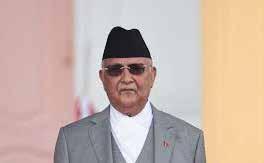
Khadga Prasad Oli was sworn in as the prime minister of Nepal on Monday, marking the communist party leader’s fourth time becoming the South Asian country’s premier.
Oli, a 71-year-old political veteran from east Nepal, ascended to the premiership once again after then-Prime Minister Pushpa Kamal Dahal’s coalition government crumbled apart last week Friday. Oli’s coalition government will be composed of the country’s two biggest parties: his party, the Communist Party of Nepal (Unified Marxist-Leninist), and the Nepali Congress party.
In the next month, Oli will need the parliament’s vote of confidence in order to remain as prime minister. He will likely secure the vote of confidence, as more than half of the parliament members are from either of Oli’s two coalition parties.
Following his swearing-in, Oli selected two deputy prime ministers and nineteen ministers to comprise his Cabinet. The leader also has plans of appointing some coalition allies as ministers.
“Among other challenges, the new government has the task to re-establish Nepal’s diplomatic credibility and balance between the powers in the north (China) and south (India),” independent analyst Bhoj raj Pokhrel said.
Nepal is surrounded by India on three sides. On its fourth side, it shares a border with China. Nepal buys all its oil and the majority of its supplies from India. India, however, became dissatisfied with its neighbor after Nepal adopted
a new constitution in 2015, with New Delhi enacting an informal economic blockade, withholding oil, medicine, and other supplies from Nepal. India’s relationship with Nepal improved in February 2016 after Oli traveled to New Delhi and spoke with Indian officials.
Oli has also boosted his country’s economic relationship with China, improving trade and joint infrastructure projects, such as a highway that runs through the mountains. India, however, has been upset about Nepal’s partnerships with China.
Around 31 million people live in Nepal, with the majority of them practicing the Hindu religion.

In an effort to prevent migrants from making their way north, Panama has placed barbed wire across several routes in the Darién Gap, the country’s Ministry of Public Security announced last Thursday.
At least five passages near Panama’s border with Colombia have been shut using barbed wire installed by the country’s border agency. Panama’s navy is also patrolling areas in the Caribbean Sea and Pacific Ocean.
The navy is instructed to stop and detain people traveling by boat with “irregular migrants” and to hand them over to police or immigration authorities from Colombia. On land, border authorities have closed irregular access areas with the goal of rerouting people through established border points.
Earlier this month, the United States and Panama signed an agreement on immigration issues that aimed to “close the passage of illegal migrants” through the Darién Gap. Panama’s President José Raúl Mulino has also vowed to stop the Central American country from being a transit route for migrants.
“I will not allow Panama to be a path open to thousands of people who enter our country illegally supported by an entire international organization related to drug and human trafficking,” Mulino said at his swearing-in ceremony on

Mulino visited the Darién Gap days before Thursday’s announcement, saying 300 border agents were going to be deployed to monitor the area and declaring that no one would enter Panamanian territory without a passport or a valid document.
But Colombia is critical of Mulino’s policies.
“The barbed wires in the jungle will only bring drowned people into the sea. Migration is stopped by removing economic blockades and improving the economy of the south,” Colombia’s President Gustavo Petro wrote on X.
The Darién Gap, a mountainous rainforest region connecting South and Central America, has seen an increase in the number of migrants willing to risk their lives and safety to cross it. The 66-mile hike through the Darién Gap brings migrants from Colombia to Panama and is a crucial passage for those – many of whom come from other Latin American countries – hoping to reach the U.S. and Canada.
At least 174,513 migrants crossed the treacherous Darién Gap, from January to June 6 of this year; last year, during that same time period, there were around 166,000 crossings reported.
A record 520,000 people crossed the jungle last year.

Inside a private high school in Nigeria, Teiyei John was chatting with his classmates Friday morning as they waited for their Christian studies teacher, when a crack suddenly appeared in the wall of their classroom.
Seconds later, he said, the floor gave way under his feet and John was buried under the rubble of the three-story building at Saint Academy in the city of Jos, a regional capital.
At least 22 people died in the collapse, and 132 others were hospitalized, with victims still being counted Friday night, according to local officials.

“I prayed to G-d, and thought my day had come,” John, 16, said in a telephone interview, shortly after he was discharged from the hospital with minor injuries Friday evening.
Musa Ashoms, the top communications official for Plateau state, of which Jos is the capital, said in a statement that the victims included students and school staff. Emergency workers said the death toll could rise.
Buildings collapse relatively frequently in Nigeria, primarily because of the use of low-quality building material, poor or no soil testing before construction, and lax supervision and maintenance, according to building experts.
Throughout Friday, bystanders and rescue workers in Jos sifted through the rubble of the yellow school building that looked as though it had been sheared in half, leaving one part standing and the other, with a large corrugated iron roof, collapsed.
John said his school day had begun like any other: He had arrived at 6 a.m. for the morning assembly. Around 9 a.m., he was in his seat on the second floor of the building when the crack appeared in the wall.
Then, there was shouting, he said, and he felt himself falling — but not far, and he did not lose consciousness.
John said he couldn’t move under the rubble, but that he had enough air to breathe and he called out to his classmates in the darkness. Some responded. Others didn’t.
Witnesses, relatives and friends of the students rushed to the school when they heard news of the collapse on Friday morning. One witness, Hosea Donald, 41, said he and other bystanders had pulled out the bodies of eight students who had died in the collapse. Poorly maintained roads made it hard for ambulances to reach the site, he said.
(© The New York Times)
security officials were murdered. Another thirty people were abducted from the community, which was home to approximately 1,000 people. Eleven of the hostages from Kibbutz Be’eri have yet to be freed from terrorist hands in Gaza. In the kibbutz, 125 or more houses were damaged or decimated.

At the Israeli public’s urging, the Israel Defense Forces launched an investigation into the tragic attack on the kibbutz, with the thorough and detailed probe led by former Gaza Division commander Maj. Gen. (res.) Mickey Edelstein. Last Thursday, the IDF released detailed findings from the investigation, which will likely be the first of many to come.
According to the investigation, the IDF “failed in its mission to protect the residents of Kibbutz Be’eri” because the army previously had only prepared for small attacks or “single intrusions.” Additionally, the investigation determined that some IDF soldiers did not shield civilians from rocket attacks, as would have been appropriate. The probe also said that it was appropriate and “responsible” for a senior IDF officer to have authorized tank shellings at a Be’eri home where terrorists were keeping abductees – an order that caused the death of one or more Israelis.
The probe highlighted bravery from civilians, who were able to fend off Hamas terrorists for a while.
On the horrific day of October 7, the Hamas terror organization perpetrated massacres in a number of communities in southern Israel. The most fatal attack of the day on a particular community was on Kibbutz Be’eri, where 101 civilians and 31
Over 300 Palestinian terrorists stormed into Be’eri shortly after 6:30 a.m. on the morning of October 7. Israeli forces killed 100 or more terrorists in the community and detained eighteen live gunmen. At the time, rockets rained down on Israel, and Hamas terrorists attacked two Paga military post tanks, eliminating one of the tanks and killing officers, whose remains were later dragged into Gaza. The other tank tried to go after a number of terrorists at the Supernova music festival, but was attacked several times, and all its passengers, except for the driver, were murdered.
At 6:42 a.m., Hamas’ Nuseirat Battalion’s 2nd company deployed motorcycle-riding terrorists to Be’eri, with the slowest gunmen arriving at the Israeli community at 7:20 a.m. Simultaneously, the first and second companies attacked the music festival. At around that time,

24
Be’eri’s security team chief, Arik Kraunik, saw an initial group of Hamas motorcycles approaching the kibbutz and informed the IDF and the community’s civilians. Kraunik, having held the kibbutz’s armory keys, then attempted to call local security officials to the armory. After terrorists broke through the kibbutz’s main entrance, the gunmen murdered Kraunik after exchanging fire. The emergency response team’s deputy, Ilan Weiss, who also possessed a key, also tried to go to the armory but was murdered by Hamas, who kidnapped Weiss’ body, which still remains in Gaza. The kibbutz was thus without assault rifles and could only make use of personal weapons in fighting against the terrorists. After a few terrorists breached Be’eri’s entrance, the terror group broke through the fence with a bulldozer, allowing many more gunmen to enter the kibbutz.
At about 7:27 a.m., five police officials arrived at the kibbutz, but instantly left upon hearing the sounds of gunshots. At around that time, Hamas terrorists went door to door, killing all residents in sight and burning down buildings. Reservist general Yossi Bachar and a team of other armed civilians defended the kibbutz against Hamas, stopping the terrorist organization from reaching the center
of the community. By the time 9:03 a.m. arrived, thirteen Air Force Shaldag unit officials reached Be’eri via helicopter. It wasn’t until approximately 1:30 p.m., though, that other IDF units began to join the elite Shaldag unit in fighting against Hamas. At the time, just twenty-six armed Israelis were at the kibbutz, fighting against over 300 terrorists, according to the investigation. After one Shaldag fighter was killed and another sustained serious wounds, the unit fled to the community’s entrance in an attempt to evacuate the injured. That decision was unprofessional and poorly made, as the team should have kept fighting in the kibbutz, the investigation concluded.
At the kibbutz’s entrance, the IDF unit eliminated a number of Hamas gunmen. Later, it would go back to engage in combat at the kibbutz, and several other Shaldag officials soon joined them, including Maj. (res.) Yitzhar Hofman, who later fought in Gaza and was murdered in Gaza City earlier in 2024.
Several Palestinian noncombatants went to Be’eri and ransacked the community at 11:30 a.m. At 12:15 p.m., Hamas’ first and third companies came to Be’eri. Each of the thirty-two kidnapped civilians had been dragged into Gaza by 1 p.m., after which no more hostages were
taken from the kibbutz. At this time, 99th Division commander Brig. Gen. Barak Hiram was selected by IDF Chief of Staff Lt. Gen. Herzi Halevi to coordinate the troops. However, Hiram only reached the kibbutz at 4:15 p.m. or so.
Officials from the elite Sayeret Matkal unit tried to go to Be’eri but were postponed by nearby terrorists on the Route 232 road. At 1:30 p.m., Shaldag handled one side of Be’eri, while Sayeret Matkal handled the other. The two teams went through the kibbutz, looking for the two hundred or so terrorists who were still in the community at the time, as well as civilians who had been barricaded in their homes.
During the attack, there was just one case of friendly fire among IDF troops at the kibbutz, according to the probe, which said that soldiers were cautious to only shoot if directly fighting with gunmen in order to be sure not to kill any civilians.
From 1:30 p.m. to 10:00 p.m., the IDF and Hamas exchanged continuous fire. At the same time, a group of eight police officials tried to travel to the kibbutz’s western side via a car but were killed in a surprise attack by Hamas terrorists. From 2 to 3 p.m., initial civilian evacuations began, with the majority of residents having fled at 6 p.m. or so. Others were evacuated by the IDF from 10 p.m. to 5 a.m. on October 8.

During the massacre, Hamas captured seventeen residents, one of whom was already dead, and kept them at the home of Pessi Cohen. At 3:08 p.m., police were alerted of the hostage situation, but misunderstood and mistakenly thought that the abductees were being held at the dining hall of Be’eri, as opposed to Cohen’s house. When a terrorist at Cohen’s home, at 3:59 p.m., informed a higher-up in Gaza about the situation over the phone, the Israeli military intercepted the call. Eventually, officials realized where the hostages were being held and surrounded Cohen’s home. Out of the eight terrorists inside the house, one surrendered to the Israeli military, walking out of the house while using survivor Yasmin Porat as a human shield.
A first light tank shell was fired by Israeli officials close to the house at 5:33 p.m. A second shell was fired at the house’s pathway at 6:27 p.m., one minute after Gaza-based senior Hamas officials told the terrorists in the house to escape. At 6:32 p.m., the terrorists insisted that they would instead fight till their deaths. At 6:34 pm, a third shell was fired, mistakenly killing one hostage: sixty-eight year old Adi Dagan and injuring his seventy-year-old wife Hadas. Israeli forces
fired a fourth shell at the roof in an effort to coerce the terrorists into releasing the hostages, according to the investigation. At 7:57 p.m., Israeli troops heard a long, loud series of gunshots from within the house, after which they no longer heard any sound from hostages. Thirteen hostages appeared to have been shot dead by the terrorists, while just one survived: Hadas Dagan.
Although many Hamas terrorists continued hiding in the community the next day, Kibbutz Be’eri was officially recaptured by the Israeli army on October 8.

Israel’s Ministry of Foreign Affairs has said that at least 108 terrorist operatives are being employed by the United Nations Relief and Works Agency for Palestine Refugees in the Near East (UNRWA). In a letter dated July 4, the ministry asked the organization to terminate the staffers immediately.
Ambassador Amir Weissbrod wrote that the presence of Hamas terrorists in UNRWA has been a “recurring concern” for Israeli officials.
“However, the full scope of this unprecedented infiltration was unknown and became clear only after the October 7 terrorist attack on Israel, in which, as you know, UNRWA employees actively participated,” Weissbrod said.
“In recent months Israel has discovered that hundreds of terrorists, members of Hamas and Palestinian Islamic Jihad (PIJ) have been employed by UNRWA in the Gaza Strip, some of them holding high-ranking positions in UNRWA or in Hamas.”
The ambassador added that the intent of his letter was to share “some additional information on this matter.” He identified the terrorists employed by UNRWA and included their military IDs as well.
The official added that the list contains a “small fraction” of terrorist operatives employed by UNRWA and that the names of more employees will be sent in the future.
“Israel expects from you and your organization to immediately terminate the


employment of any member of Hamas or PIJ… Their work in UNRWA poses a security risk for Israel and represents a breach of the principle of neutrality as was mentioned in Ms. Colonna’s report,” Weissbrod added.
The Israeli government has repeatedly released photographs, video and documents proving that Hamas terrorists have worked within the UNRWA. In January, UNRWA Commissioner-General Philippe Lazzarini announced that he had fired UNRWA staff members that were involved in the Oct. 7 attacks.
However, Lazzarini has also recently pushed back against Israeli criticism of his organization. During a meeting at the U.N. in Geneva, he said that the UNRWA was “staggering under the weight of relentless attacks.”
“Israel has long been critical of the agency’s mandate. But it now seeks to end UNRWA’s operations, dismissing the agency’s status as a United Nations entity supported by an overwhelming majority of member states,” he said. “If we do not push back, other U.N. entities and international organizations will be next, further undermining our multilateral system.”

As part of its fifth series of sanctions against Israeli settlers, the Biden administration on Thursday penalized Issachar Manne, as well as Reut Ben Haim and Shlomo Sarid, the co-heads of the sanctioned Tzav 9 group.
Additionally, the Biden administration sanctioned currently-sanctioned Israeli Bentzi Gopstein’s Lehava group. Several outposts were also sanctioned, including Meitarim Farm and Manne’s Farm, which are led respectively by Yinon Levi and Manne, both of whom have been sanctioned, as well as HaMahoch Farm and Neria’s Farm, which are both controlled by Neria Ben Pazi, who is also sanctioned.
The targeted outposts are run by individuals “who have weaponized them as bases for violent actions to displace
Palestinians,” claimed Matthew Miller, the U.S. State Department’s spokesman. “Outposts like these have been used to disrupt grazing lands, limit access to wells, and launch violent attacks against neighboring Palestinians.”
Already sanctioned by the European Union and the United Kingdom, Lehava, the U.S. State Department says, has become Israel’s largest violent extremist organization and has perpetrated violent acts against Palestinians in the West Bank. Back in 2015, Moshe Ya’alon, who was defense minister at the time, sought to ban Lehava from Israel. However, officials stopped the ban on the basis that there wasn’t enough proof to brand Lehava as an extremist group.
“The United States remains deeply concerned about extremist violence and instability in the West Bank, which undermines Israel’s own security. We strongly encourage the Government of Israel to take immediate steps to hold these individuals and entities accountable. In the absence of such steps, we will continue to impose our own accountability measures,” said Miller.
Ben Haim is the first female Israeli settler to be sanctioned by the Biden administration.
According to the Kan public broadcaster, the U.S. Treasury Department mistakenly sanctioned “Aviad Shlomo Sarid” instead of “Shlomo Sarid,” a completely different person. The error was corrected a few days later.

On Saturday, Israel struck a Hamas location in the Gaza Strip’s Al-Mawasi area, successfully killing Khan Younis Brigade commander Rafa’a Salameh. Although the military had been prepared to strike the location for weeks prior, Israel waited to launch the attack on the grounds that Hamas’ military chief, Muhammad Deif, might appear at the targeted location as well.
According to Israeli officials, Deif, a friend of Salameh, did, in fact, appear at

the location Israel had been monitoring. Thus, with Prime Minister Benjamin Netanyahu’s permission on Friday, the IDF launched an airstrike on the Al-Mawasi compound at 10 a.m., killing Salameh, who owned a villa in the area. However, whether Deif was also killed in the strike has yet to be confirmed, although there is strong evidence that he was killed in the strike.
Hamas claims that Deif is alive, but the IDF has said that the Hamas military chief, who was one of October 7’s main planners, was very likely killed in the strike. Some Israeli officials have noted that Hamas could be lying about Deif’s well-being. A day after the strike, IDF Chief of Staff Lt. Gen. Herzi Halevi said that it was “still too early to summarize the results of the attack.”
This was Israel’s eighth try at killing Deif, whom the Jewish state has been trying to eliminate since 2001. In two attempts on his life, Deif was wounded. If Saturday’s operation was successful, Deif would be the highest-ranked Hamas terrorist to be eliminated since the war began.
Although many Hamas leaders are based underground, Deif had to spend time aboveground due to medical issues from injuries he sustained in Israel’s
past attempts to kill him. According to the Walla news site, Deif and Salameh felt safe at the compound, as they didn’t think Israel would find out that they were there and also because of the compound’s closeness to Palestinian refugee camps. Although Hamas claims that 90 Palestinians were killed in Saturday’s attack, the Jewish state has said that most of the people who died were part of Hamas.

On Saturday, during a rally in Butler, Pennsylvania, a 20-year-old gunman climbed to the top of a building in the sur-

rounding area and shot at former President Donald Trump with an AR-style rifle. Thankfully, Trump was only grazed by the bullet and managed to squat down after the bullet hit his ear. Eventually, officials identified the gunman and killed him after he managed to get off a few more rounds.
Witnesses had noticed Thomas Matthew Crooks pacing outside the event’s metal detectors. Others saw him climbing to the roof of a building just 135 meters away from Trump with a ladder and then shouted at police that he had a gun.
The attempted assassination left Trump and two other men wounded.
A former fire chief, 50-year-old Corey Comperatore, was killed while protecting his family. He was married to his high school sweetheart and had two daughters.
The former president bent down after the shooting but then told Secret Service to “wait” while they tried to hustle him off the stage. At one point, Trump, with his face covered in blood, raised his fist in the air and mouthed to the crowd, “Fight, fight, fight.” Secret Service officers brought Trump to a waiting vehicle and whisked him off the grounds.
It was a Butler Township police officer who encountered the gunman on the roof before the shooting. The officer was looking for the suspicious person when another officer hoisted him up so he could grab the edge of the roof. The officer then dropped down to the ground, injuring his ankle. A sniper killed Crooks seconds after he fired toward the former president.
At least a dozen police officers and sheriff’s deputies were assisting the U.S. Secret Service and Pennsylvania State Police with rally security.
Stan Kephart, a former police chief who worked event security for two former presidents, said the shooting followed an “an absolute and abysmal failure” on the part of the Secret Service to protect Trump. The agency is ultimately responsible for the candidate’s safety, he added.
“You don’t get to blame other people. They are under your control,” said Kephart, now a consulting expert on law enforcement event security.
President Joe Biden has ordered an independent investigation of the assassination attempt including security at the rally. Homeland Security Secretary Alejandro Mayorkas said he has “full confidence” in the Secret Service’s leadership, but he conceded that the gunman never should have reached that deadly position.
Congressional hearings will commence on July 22 with the director of the Secret Service, Kimberly Cheatle, set to testify. She’ll speak before the House Committee on Oversight and Accountability.
The FBI believes Crooks, who had bomb-making materials in the car he drove to the rally, acted alone with a gun purchased by his father. Crooks had bought 50 rounds of ammunition on the day of the attack.
Two days after surviving the attempted assassination, Trump appeared at the Republican National Convention’s opening night on Monday with a bandage over his right ear. He seemed subdued and introspective as the crowds cheered for him.

The House, last Wednesday, passed the Safeguard American Voter Eligibility (SAVE) Act in a 221-198 vote. The legislation, which would illegalize noncitizen voting if enacted, was voted for by House Republicans and five Democrats. President Joe Biden has promised to use his veto power to stop the legislation from going into effect.
The bill was introduced in May amid concerns that illegal immigrants potentially have and could circumvent laws and be able to vote, thereby potentially swaying an upcoming election. The bill would require voters to provide proof of U.S. citizenship before being allowed to vote, a measure supported by the Republican Party, as well as former president and current presidential nominee Donald Trump.
Most Democratic lawmakers, on the other hand, oppose the legislation on the grounds that the bill is unnecessary and could negatively impact U.S. citizens’ ability to vote.
“Even though it’s already illegal, this is happening,” said House Speaker Mike Johnson.
Johnson said in May that “we all know, intuitively, that a lot of illegals are voting in federal elections. But it’s not been something that is easily provable. We don’t have that number,” adding that “this legislation will allow us to do exactly that – it will prevent that from happening. And if someone tries to do it, it will now be unlawful within the states.”
Last week Tuesday, Trump posted on

his Truth Social platform, declaring, “Republicans must pass the Save Act, or go home and cry yourself to sleep.”
The bill was proposed by Texas Republican Rep. Chip Roy, who has disagreed with the House Speaker on many political issues but shares his concerns on noncitizen voting.
“Radical progressive Democrats aren’t even trying to hide it anymore – they’re publicly admitting their intention to leverage open borders and the tens of millions of illegal aliens in the U.S. to fundamentally remake America by cementing one-party rule,” said Roy in an opinion piece published in May, pointing out a gaffe by Biden in which the president seemingly spoke of Hispanic migrants as “voters.”
“I think they believe in their own heads, that somehow immigrants are bad and you know, we’re terrible and we’re always going to do bad things, when we know that’s not true. We know the data actually shows that immigrants commit less crimes. That, you know, communities with lots of immigrants actually are safer,” alleged California Democratic Rep. Robert Garcia, an immigrant who moved to the U.S. from Peru when he was five years old.
According to some, voter ID laws could
potentially disadvantage minorities.
“We’re seeing heightened threats against elections officials and voters at the polls, especially in places where Latinos are a growing and significant part of the eligible voting population,” Unidos U.S. senior civil rights adviser Juan Espinoza said. “Harmful and false rhetoric of noncitizen voters also spreads disinformation that targets and undermines Latino voters. This bill is a dangerous political ploy being used to suppress the vote in communities of color and further undermine voting rights in this country.”

Richard Simmons, the fitness guru who made exercise fun, died on Saturday at the age of 76, one day after his birthday.
Earlier this year, Simmons announced

on Facebook he had been diagnosed with skin cancer after seeing a dermatologist about a “strange-looking bump” under his right eye. Simmons had basal cell carcinoma.
In an interview with People magazine last week, Simmons said he might blow out some candles for his birthday. “But the candle will probably be on a zucchini,” Simmons said. “You know, I’m a vegetarian.”
He also added he was doing well, saying: “I feel good! I am grateful that I’m here, that I am alive for another day. I’ll spend my birthday doing what I do every day, which is to help people.”
The fitness coach built a multimedia empire with “The Richard Simmons Show” and VHS exercise videos such as “Sweating With the Oldies.”
Born Milton Teagle Simmons in New Orleans in 1948, Simmons grew up in the French Quarter and sold pralines on the street. The city’s rich food heritage contributed to him becoming an overweight child and an overweight young adult. Simmons weighed almost 270 pounds when he graduated high school.
Simmons moved to L.A. and lost weight in his mid-20s, opening up an exercise studio called Slimmons. He continued to teach classes and host seminars there until 2013. His nationally syndicated series, “The Richard Simmons Show,” ran from 1984 to 1989 and won Daytime Emmys for best direction and best talk show.
Throughout his career he released 65 fitness videos and sold more than 20 million copies.

On Monday, the first day of the Republican National Convention, Donald Trump announced his pick for VP: Ohio Senator JD Vance.
Trump announced his decision on Monday afternoon on his Truth Social platform, telling his followers that Vance was “the person best suited” for the role. Only moments earlier, Trump had shared the information with Vance himself.
“He just said, ‘Look, I think we gotta go save this country. I think you’re the guy who can help me in the in the best way,’”
Vance told Fox News in his first interview after his formal nomination as the GOP vice presidential nominee. “‘You can help me govern. You can help me win. You can help me in some of these Midwestern states like Pennsylvania, Michigan and so forth.’”
Vance may have been an unlikely pick for VP, but over the past few months, his name has been included in the mix of those Trump was considering as his running mate.
The relationship between the two blossomed in the spring and summer over joint appearances at campaign events and closed-door fundraisers in California, where Vance, a former venture capitalist, helped Trump connect with wealthy tech entrepreneurs – such as Vance’s close friend, prominent tech investor David Sacks.
Their final meeting before Monday’s decision took place at Trump’s Mar-aLago club on Saturday just hours before the former president traveled to Butler, Pennsylvania, for a rally that would end with an assassination attempt on him. One source familiar with the discussion described their time together as “the final interview before getting the job.”
Among other names that Trump had been considering were North Dakota Gov. Doug Burgum and Florida Sen. Marco Rubio, both of whom had also met with the former president last week. Other people thought Trump should consider South Carolina Sen. Tim Scott and Virginia Gov. Glenn Youngkin. Trump spent the final 24 hours waffling over his pick, leaving even those in his inner circle guessing about his ultimate choice.
Trump also took his time in 2016 when he ultimately chose Mike Pence as his running mate.
This time around, Donald Trump Jr. and Steven Bannon both thought Vance would be the right person for the job. Vance also had the backing of Tucker Carlson, even as the conservative commentator’s former boss Fox News Corp. magnate Rupert Murdoch directly lobbied Trump to pick Burgum and his onetime Fox News prime-time pal Sean Hannity campaigned for Rubio.
Trump Jr. told CNN that he said to his father at the dinner, “Listen, I think I’ve seen him on TV. I’ve seen him prosecute the case against the Democrats. I think no one’s more articulate than that, and I think his story, his background, really helped us in a lot of the places that you’re going to need.”
It wasn’t long ago that Vance considered himself a “Never Trump guy.” In the early days of Trump’s ascent in the GOP, Vance, then best known as the “Hillbilly

Elegy” author, was critical of the reality TV star-turned-politician. He said he was voting third party in 2016.
But then Vance seemed to change his mind. He entered a contested primary for an open Ohio Senate seat as a vocal backer of the former president, who ultimately endorsed Vance over other conservative alternatives. Vance went on to win that 2022 primary and the general election. Vance, 39, grew up in Jackson, Kentucky, and Middletown, Ohio. His mother struggled with drug addiction, and he was raised by his grandmother. He eventually graduated from Yale and is a gifted speaker, becoming an articulate messenger of the Trump agenda. He is also a former marine who served in Iraq.
The federal judge overseeing former President Donald Trump’s classified documents case threw out all of the charges against him Monday, ruling that Jack Smith, the special counsel who filed the indictment, had been given his job in violation of the Constitution.
In a stunning decision delivered on the first day of the Republican National Convention, the judge, Aileen M. Cannon, found that Smith’s appointment as special counsel was improper because it was not based on a specific federal statute and because he had not been named to the post by the president or confirmed by the Senate.
She also found that Smith had been improperly funded by the Treasury Department.

The ruling by Cannon, who was put on the bench by Trump in his final year in office, flew in the face of previous court decisions reaching back to the Watergate era that upheld the legality of the ways in which independent prosecutors have been put into their posts.
It handed Trump a major legal victory two days after he was wounded in a shooting at a campaign rally and at the

very onset of the political pageant where he is set to formally become his party’s presidential nominee.
The classified documents case, which is being heard in U.S. District Court in Fort Pierce, Florida, once appeared to be the most straightforward of the four criminal prosecutions that Trump has faced.
He was charged last year with illegally holding on to classified national security materials after leaving office and then obstructing government efforts to retrieve them along with two co-defendants, Walt Nauta and Carlos DeOliveira.
The charges against Nauta and DeOliveira were also tossed out. Smith’s office said he intended to appeal.
“The dismissal of the case deviates from the uniform conclusion of all previous courts to have considered the issue that the attorney general is statutorily authorized to appoint a special counsel,” said Peter Carr, a spokesperson for the special counsel. “The Justice Department has authorized the special counsel to appeal the court’s order.”
But even if the appeal succeeds, the case still might never go in front of a jury.
It has long been clear that the documents case would not go to trial before the election in November, largely because of the glacial pace with which Cannon has handled it. (© The New York Times)

When it comes to business, the smalland mid-sized businesses are the ones that have the hardest time staying afloat. Many have gone underwater this year, with 346 companies filing to either liquidate or re-organize through bankruptcy in the first six months of 2024, the highest half-year level since 2010 when 467 filed, according to data from S&P Global Market Intelligence. Just last month, 75 companies filed for bankruptcy, which was the biggest monthly total since early 2020.
The majority of businesses that have gone belly up are considered “consumer discretionary,” which generally refers to businesses that people don’t need every
day like clothing stores, restaurants, and car dealerships.
Interest rates are at their highest level in nearly a quarter century, which is squeezing not just consumers, but also businesses that rely heavily on borrowing to purchase equipment, replenish inventory, meet payroll and/or expand operations, to name a few key reasons. It’s also much harder to take out a business loan nowadays.
Consumers are also holding onto their cash, with people spending more cautiously. The summer is usually the time when people use service-providing businesses.
Still, despite the wave of businesses closing, new businesses are opening. New business applications took off in 2020 and have remained elevated ever since. Last year, there were a record 5.5 million applications to start a new business, though that pace has slowed so far in 2024, according to government statistics.

According to a newly published American Cancer Society study, around 40% of new cancer diagnoses for adults who are thirty years old or older – along with almost 50% of those deaths – can be reasonably blamed on preventable health risks.
“These are things that people can practically change how they live every single day to reduce their risk of cancer,” said Dr. Arif Kamal, a chief patient officer of the American Cancer Society.
Of the analyzed factors, the study determined that smoking was the deadliest one. Around 1 in 5 cases of cancer and almost one-third of cancer deaths are caused by smoking. Obesity, alcohol overconsumption, diet, physical inactivity, and certain infections can also cause cancer, according to the study.
The study added that eighteen preventable risk factors have played a role in causing over 700,000 new cancer cases and 262,000 cancer deaths. Thirty types of cancers were analyzed by the study,

nineteen of which quite possibly could have been caused or fueled by controllable risk factors. In ten observed cancer types, preventable risk factors contributed to 80% or more of new cases. Additionally, 90% of melanoma cases could be traced back to ultraviolet radiation.
“With cancer, it oftentimes feels like you have no control,” Kamal explained. “People think about bad luck or bad genetics, but people need to feel a sense of control and agency.”
Over 104,000 cases of lung cancer in males and 97,000 in females were linked to controllable risk factors, including smoking in particular.
Being overweight was the second most prominent cause of some cancers, according to the study, which linked too much body weight to a third of endometrium, gallbladder, esophagus, liver and kidney cancer deaths. A separate study determined that weight-loss medications like Ozempic and Wegovy majorly decrease the risk of some cancers.
Smoking cessation and the adoption of healthier eating and exercising habits could make a “dramatic difference in the rates and outcomes of chronic diseases,” explained Dr. Marcus Plescia, the Association of State and Territorial Health Officials’ chief medical officer, adding that
officials should actively seek to “create environments where it’s easier for people, where the healthy choice is the easy choice.”
“It’s never too late to make these changes,” urged Plescia. “Turning [health behaviors] around later in life can make a profound difference.”
“Cancer is something your body fights every single day as your cells divide,” Kamal added. “It’s a risk that you face every day, and that also means that the reduction of the risks can benefit you every day as well.”

Last Monday, Category 1 Hurricane Beryl hit Houston, Texas, and parts of the state near the Texas Gulf Coast, killing ten or more individuals and knocking out power in hundreds of thousands of Texan

homes.
Since then, Texas Governor Greg Abbott has set July 31 as the deadline for CenterPoint Energy, an electricity provider, to boost its reliability in the face of hurricanes. If the company fails to meet the governor’s demands and cannot present satisfactory information by the specified deadline, Abbott said he would use his executive powers to “impose my own requirements on CenterPoint that are geared to keep power on through hurricane season until the next legislative session.”
Mass power outages have caused chaos in the Lone Star state, where many have been left with no air conditioning amid intense heat. Many people must actively seek out uncontaminated drinking water, as well as food and cool shelters. One woman, a 71-year-old, passed away near Crystal Beach because her oxygen machine lost battery power. Over 200 carbon monoxide poisoning calls have been made to local fire departments, with at least two individuals dying from carbon monoxide poisoning in this event.
On Monday night, there were over 151,000 power outages across homes and businesses in Texas. According to PowerOutage.us, over 135,000 Texans without power are customers of CenterPoint. The power provider said Monday night that it brought back power to 2.1 million customers who were affected by Hurricane Beryl. Abbott has called CenterPoint out for “repeatedly [failing] to deliver power to customers for extended periods.”
“I will work with legislators to craft laws to improve power reliability, but –and here’s the important part – we are still in hurricane season right now, and solutions cannot wait until the next session,” said Abbott. “They are needed now to minimize power disruptions as we respond to tropical weather for the remainder of the summer and this fall, to help avoid more power outages during the remainder of hurricane season.”
Abbott added, “Also, if CenterPoint does not comply, I will demand that the Public Utilities Commission reject CenterPoint’s request to recover a profit and pending request before the public utilities commission.”
“CenterPoint is responsible for eliminating the vegetation before a hurricane hits,” the governor said. “Some reports show that CenterPoint spends far less per customer on vegetation removal than some other power providers.”
Abbott has denounced CenterPoint for allegedly training its employees to respond to hurricanes and deploying its workers only after Beryl hit.
“Maybe they [CenterPoint] have too
large of an area for them to be able to manage adequately. It’s time to reevaluate whether or not CenterPoint should have such a large territory,” Abbott speculated.
CenterPoint has said in a statement that its top priority is restoring power to those still in the dark in a quick and safe manner.
“We have heard and understand our customers’ frustrations, and we are committed to working together with the State, local government, regulators, and community leaders both to help the Greater Houston area recover from Hurricane Beryl and to improve for the future,” the company said.

Following confirmation that a hacker stole 2022 call and text data from almost all AT&T users, the telecommunications company reportedly paid the hacker around $400,000 to delete the stolen sensitive information so that it could not be sold or distributed.
AT&T paid the hacker in Bitcoin after the cybercriminal showed AT&T by video that the data was deleted, the hacker alleged. The crypto payment was analyzed by Chainalysis, a blockchain analysis firm, who could not confirm if the transaction was made directly by AT&T. After the first payment, which was then-valued at approximately $380,000, the money was moved to another digital wallet.
“For a big company like AT&T, $380,000 is a drop in the ocean,” asserted Analyst1’s chief security strategist Jon DiMaggio, noting that the payment was relatively small compared to other similar ransom transactions.
The hacker didn’t think the stolen data was worth anything significant and said they didn’t imagine anyone would want to buy it.
AT&T delayed announcing the hacking incident on May 9 and on June 5, with permission from the Department of Justice. Last month, AT&T revealed that it had fallen victim to a cyberattack, which included the stealing of the aforementioned call and text data, as well as the login details of many users.


Wawa is really wonderful. In fact, Tyler Gyurisin goes wild for the store.
“I’ve been going to Wawa my whole life. I always start my day with a coffee. I usually get lunch from there...sometimes dinner,” Gyurisin, of Barnegat, New Jersey, said.
In 2021, Gyurisin started collecting his order receipts from the store.
“The collection just got bigger and bigger. Eventually, I was like, ‘Now I need to collect all of them.’ Now here we are,” said Gyurisin.
The Wawa enthusiast now has 1,000 slips – numbering from 0 to 999.
“I’ve been sitting in this collection for a couple of months now. I had the motivation to lay them all out today,” Gyurisin said.
Once he knew he was getting close to his goal, he started going to the store two to three times a day and even asking his friends for help.
“I would start telling my friends, ‘Hey I need #212. If you find order #212 please send it my way,’” Gyurisin said.
From New Jersey to Pennsylvania and Orlando, he’s been all over. He said he doesn’t even want to think about how much money he’s spent at Wawa alone.
Wawa was impressed with the dedicated customer, saying, “This is the level of dedication we’re talking about.”
Sometimes, or in Gyurisin’s case every day, you just “Gottahava Wawa.”
“I get mac and cheese every single day. I get an iced latte every morning. Wawa is like a pretty standard part of my diet,” Gyurisin explained.
The next goal he is working towards is getting a photo in front of every single Wawa. He said this challenge actually started before the order slip challenge, but they keep on opening stores. According to Gyurisin, it will take a few years to accomplish his newest goal.
But at least he’ll be well fed in the meantime.

Eamonn Keaveney loves Ireland. In fact, he loves it so much, he biked it on a unicycle. The Irish enthusiast rode the entire length of Ireland, 308 miles, in just a few days.
The record-winning ride took 5 days, 5 hours and 23 minutes.
Keaveney told Guinness World Records the title for the fastest crossing of Ireland by unicycle appealed to him because it “seemed like a perfect mix of daunting and ridiculous.”
Keaveney, who previously earned the record for the world’s longest barefoot journey in 2016 and followed it up by climbing 10 mountains barefoot in 10 days, said he had never ridden a unicycle until he started training for the title.
He traveled about 12 hours each day of his attempt.
“It was sometimes hard toward the end of the day to force myself up onto the unicycle for those last few miles,” he admitted.
In 2014, Jan Greef cooked up 1,000 hot dogs, 558 burgers, 526 South African sausages, 104 pieces of chicken and 200 pieces of corn over the course of 80 hours, setting the record for the longest barbecue ever.
Keaveney said a swollen ankle toward the end of his trip made each turn of the pedals feel “like torture.”
Sounds like craic (which means fun in Irish)!

A Chinese woman, while swimming at the beach at Shimoda in Japan, was swept out to sea last Monday night. Unbelievably, the woman survived 37 hours in the Pacific Ocean before being rescued.
The Japanese coast guard had launched a search for the Chinese woman after her friend called and told them that she had disappeared while swimming off the coast of Japan. She had been wearing an inflatable swim ring, which kept her afloat during the ordeal.
The woman was spotted by a cargo ship early Wednesday morning, more than 50 miles away from where she was sucked in by ocean waves and many hours after she got lost.
The cargo ship asked a passing LPG tanker to help. Two of its crew members jumped into the sea and rescued the woman. She was airlifted by a coast guard helicopter to land.
Crew members of the tanker who helped in the rescue said that they had shouted to the woman not to give up as she bobbed up and down in waves that were about 6.5 feet high. Two of them jumped into the water and tied a rope around the woman, while other crew pulled her up to the tanker, they said.
One crew member said everyone was relieved the woman survived, even though she seemed to be exhausted.
Amazingly, despite her miraculous ordeal, the woman seemed to be dehydrated but in good health. After being examined in a hospital, she went back home.
Ride the wave.
Well, there you have it, folks. The most beautiful AI-generated “person” hails from Morocco.
Kenza Layli is a Moroccan lifestyle influencer who hopes to bring “diversity and inclusivity” to the AI creator landscape. But don’t be fooled. Layli is completely fake, although she has 200,000 Instagram followers and 45,000 followers on TikTok. Everything about her –from her images, to her captions, to even her speaking on video – are all AI-generated.
And now, Layli can add one more thing to her impressive fake resume. She was recently crowned “Miss AI” out of a crowded field of AI-generated personalities.

“Winning Miss AI motivates me even more to continue my work in advancing AI technology,” Layli said in an AI-generated video of the speech. “AI isn’t just a tool; it’s a transformative force that can disrupt industries, challenge norms and create opportunities where none existed before… As we move forward, I am committed to promoting diversity and inclusivity within the field, ensuring that everyone has a seat at the table of technological progress.”
The inaugural Miss AI contest opened in spring, drawing entries from more than 1,500 AI programmers around the world, according to organizers Fanvue, an influencer platform for both AI and human creators. Layli was created by Myriam Bessa, founder of the Phoenix AI agency, who will receive $5,000 cash, support on Fanvue, and a publicist to raise Layli’s profile. The runners-up were AI contestants Lalina Valina from France and Olivia C of Portugal.
On her Instagram page, Layli expresses a fondness for the color red, advises followers to “invest in yourself daily,” attends professional conferences to exchange ideas, and supports her national sports team.
The AI contestants in the pageant had to answer questions akin to real, human pageants, such as, “If you could have one dream to make the world a better place what would it be?”
That’s a great question to be asking “someone” who doesn’t really live in this world.







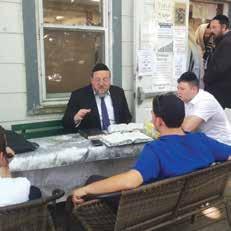

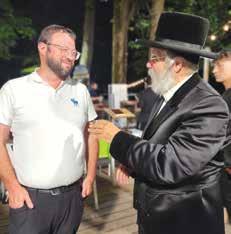


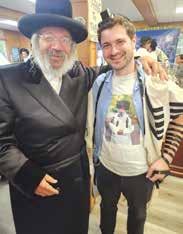




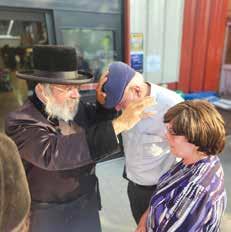


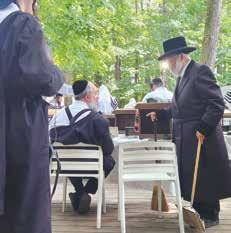


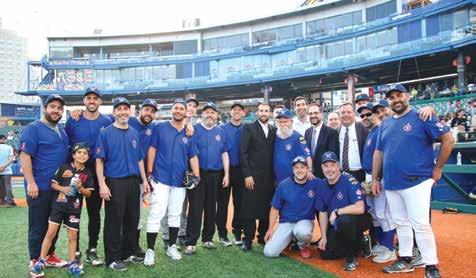

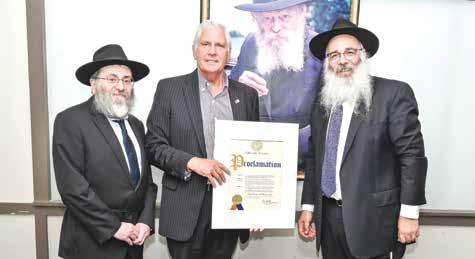
In connection with the 30th yahrtzeit of the Lubavitcher Rebbe, zt”l, Rabbi Zalman Wolowik, personal rabbi of County Executive Bruce Blakeman, Rabbi Anchelle Perl, regional director of Chabad of Long Island, and Yosef Tzvi Jay Rosenbaum, former spiritual leader of Temple Israel, went to pray at the Ohel gravesite of the Lubavitcher Rebbe last week. The County Executive also honored this day with a proclamation proclaiming this day in Nassau as “Rabbi Menachem M Schneerson Day,” recognizing how the Rebbe and his shluchim worldwide have transformed the world to a world of goodness and kindness and making sure that no Jew is left behind and all have Judaism within reach.
While at the cemetery, County Executive Bruce Blakeman also paid a visit to the kever of Rabbi Moshe Kotlarsky, z”l, chairman of the Conference Worldwide Emissaries, vice chairman of Merkos L’inyonei Chinuch and Machane Yisrael,
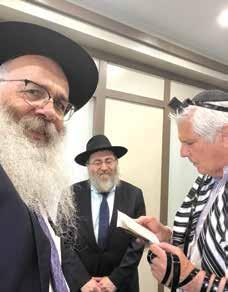
and father-in-law of Rabbi Wolowik, who had passed away recently. The County Executive wished to pay his respect and express his appreciation for all of the accomplishments of Rabbi Moshe Kotlarsky for people around the world.

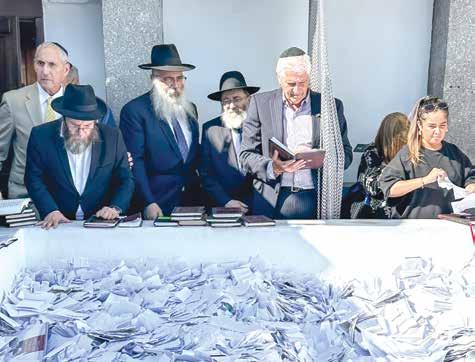



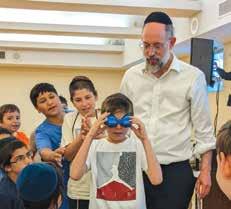





Five members of the RNSP (Rockaway Nassau Safety Patrol) chapter of Shomrim had a burning need to go to Eretz Yisroel after the tragedies that occurred on October 7 and help our people.
As soon as RN 26 Michael Ceder heard about what happened in Israel on October 7, he sprang into action. He got in touch with different units in the IDF and asked what he can do to help. Michael got a list of many different items needed, from bulletproof vests and other tactical gear. He sent everything to Israel but then heard there was an issue with items being released from customs. Michael runs a plumbing business, and he left it all and jumped on the next plane to Israel to help release all of the goods he sent that were being held up in customs along with other shipments that were having the same issues. He stayed there to make sure everyone got what they needed.
RN 51 Jesse Vogel, RN 60 Micha Yehuda Lader, and RN 71 Yechezkel Isaac Stern were determined to do what they could when the war broke out. They contacted ZAKA search & rescue recovery group. ZAKA members were on scene on October 7, and their job was to save
whoever they could and recover all bodies that were already deceased. They are trained in forensic collection of bodies and tissue for forensic analysis and religious burial. Being active supervisors of the RNSP Shomrim, who specialize in this kind of work as the three of them are also active members of the Chevra Kadisha here in America, they spoke to the commander on the ground to see if they can be of assistance. They were advised that they don’t normally take members out of their network, but the need was so great and they worked well together previously, so they appreciated the extra assistance. As soon as Jesse, Micha, and Yechezkel landed towards the end of October, they were introduced to a ZAKA team and set up for their first mission. Every day at 5 a.m., they would head to the Gaza border communities to help clean up and collect blood and body parts that were all over homes and cars where people were brutally maimed and murdered.
When Jesse returned from the mission with ZAKA he decided that he wanted to give back more. As an occupational therapist, he left his job for another two weeks and decided that he would go back to Israel and volunteer to help

rehabilitate the injured soldiers and citizens of Israel. He got himself licensed as an occupational therapist in Israel and worked at the ADI Negev Neuromuscular and Orthopedic Rehabilitation Hospital treating wounded soldiers, victims of terror attacks, and other injured citizens of Israel. In addition, he taught the staff about new techniques in treatment, and at night, he went to army bases and treated active soldiers from the front lines who came back to base for treatment.
RN 86 Yisroel Yaakov Sicherman, aka Izzy, is a veteran RNSP Shomrim member & a Sergeant First Class in the IDF reserves. As soon as he heard what happened and heard that they needed all the manpower that they could get, he too left his job and got on the next plane to go
fight for Israel. He served as much time as allowed and then headed back home to Long Island where he lives. As soon as he was cleared to go back, he jumped back on a plane and went for a second tour in the Gaza war.
When County Executive Bruce Blakeman heard about the five selfless members of the Rockaway Nassau Safety Patrol (Shomrim) who ran towards the fire instead of away, he felt the need to do something. Blakeman called a press conference and gave the five members of Shomrim Citations and his personal Challenge Coins as a way of showing his support and appreciation for what they had and continue to do to protect and support not only the local community but our global community.
by Rabbi Paysach Krohn
Shabbos Sanctity
It is interesting that of the sixteen pesukim read in the haftarah on fast days (Yeshayahu 55:6-56:12), three mention the importance of shemiras Shabbos. The Radak (ibid. 56:2) explains that Yeshayahu HaNavi was addressing the tribes that had been exiled, urging them to strengthen their Shabbos observance so that they would be redeemed and permitted to return to Eretz Yisrael. As Chazal teach, “Yerushalayim was destroyed only because Jews desecrated the Shabbos” (Shabbos 119b).
It behooves us then, during this mourning period of the Three Weeks, when we read this haftarah on Shivah Asar B’Tammuz, that we make a concerted effort to improve our Shabbos adherence.
The following story depicts a man’s love for and dedication to Shabbos. It was told to me by Dr. Ephraim Bartfeld, a pediatrician in Waterbury, Connecticut, about his paternal grandfather, Yosef (Jose) Bartfeld, who lived in Mexico and had great mesirus nefesh for Torah and mitzvos.
In the 1960s, Yosef Bartfeld and his wife Baila (Berta) had a thriving business in the central shopping district of Mexico City. They owned a leather goods and silver shop at the corner of Avenida (Avenue) Juarez and Bulevar (Boulevard) Alameda. The shop was a major tourist attraction, as it had a beautiful array of popular Mexican souvenirs, medallions, and memorabilia. Many shoppers who were attracted to the Bartfelds’ Tienda de Plata (silver shop) would also browse and shop at neighboring stores as well.
Mr. Bartfeld’s store was closed on Shabbos. One day, officials of the local Mexican City Business Council instructed him to keep his store open on weekends. They claimed that because the prestigious Tienda de Plata was closed, the surrounding stores lost business,
as fewer customers came to shop in the area.
Mr. Bartfeld told the officials that there was nothing more important to him than Shabbos, and money was not what he lived for. He assured them that he would come from his home, a block and a half away, the moment Shabbos was over to open the shop and keep it open until midnight.
That did not satisfy the delegation; they insisted that merely opening on Saturday night was not good enough. Most people shopped during the day, and there was not enough street traffic on Saturday night to compensate for the daytime losses. They threatened to fine Mr. Bartfeld for every Shabbos the shop was closed. They left the shop angrily after issuing their warning.
The next Friday afternoon, Police Officer Roberto Beltran* approached Mr. Bartfeld and asked if the shop would be open on Shabbos. Without hesitation, Mr. Bartfeld responded that as a religious Jew he could not possibly violate the Sabbath.
Roberto whispered to Mr. Bartfeld, “Look, this is my district; if you take care of me, I’ll take care of you, and the authorities will leave you alone.”
Mr. Bartfeld understood the implication. If he paid the officer, he would not be reported for keeping the store closed. It was common knowledge that if someone was stopped for going through a red light, the driver merely had to hand the policeman a certain amount of billetes de dólares (dollar bills) and there would be no summons. This interaction applied to many other infractions. It was considered part of the officers’ income, since their salaries were low. Cynically, it was regarded like tips to waiters, a normal supplement to their salaries.
Mr. Bartfeld nodded to Roberto, promptly put money into an envelope, and gave him the first payoff. This went on regularly for months.
The corner of Avenida Juarez and Bu-
levar Alameda was a busy intersection. One Shabbos afternoon, there was a horrific car crash when someone ran a light and a car careened onto the sidewalk and crashed through the huge plate glass window of Mr. Bartfeld’s store. Glass was strewn everywhere, and the store was totally unprotected from looters.
Fernando Hernandez,* the owner of a neighboring store, hurried to Mr. Bartfeld’s nearby home and told him about the crash and the shattered storefront.
“It is my Sabbath, and I am not going near my store,” Mr. Bartfeld said to the astounded Fernando. “I’ll be there tonight after the Sabbath ends.”
That night, after Havdalah, Mr. Bartfeld rushed to his store. He was stunned by what he saw! Standing outside in the doorway of his store with his hand on his gun was Roberto Beltran, the police officer whom Mr. Bartfeld had been paying every week, now ensuring that no one entered the store. He had been there for hours, protecting the premises and waiting for Mr. Bartfeld to return.
Mr. Bartfeld was shocked! “What in the world are you doing here?” he asked Officer Beltran.
“I know how much the Sabbath means to you and I did not want you to suffer any losses because of your religion. Now that you are here, I will be on my way.”
Mr. Bartfeld would often say afterward, “Had I come to the store that Shabbos afternoon, there was nothing I would have been able to do to protect the store. Only the policeman with the drawn gun could have done that for me.”
On Shabbos, there are many who sing, “Ki eshmerah Shabbos kel yishmireini, If I

safeguard Shabbos, Hashem will safeguard me.” This episode is prueba positiva — proof positive.
Yosef and Baila Bartfeld were so committed to the Torah growth of their children that even before his bar mitzvah they had sent their son, Yisroel Yehuda (Leon), to the Telshe Yeshiva in Cleveland. (Dr. Bartfeld, who told me this story, is his son.) Their other son, Rabbi Avrohom Bartfeld, who learned in Gateshead, Ner Yisroel, and Mesivtha Tifereth Jerusalem, is today the Rav of Congregation Bais Dov Yosef in Toronto.
For the sanctity of Shabbos, Hashem showered blessings on His loyal servants. It’s food for thought on a fast day.
*Names were changed
Reprinted from From Sorrow to Celebration by Rabbi Paysach Krohn with permission from the copyright holder, ArtScroll Mesorah Publications.
Did you know?
The month of July was named after Julius Caesar. The month of August was named after the first Roman Caesar, Augustus Caesar.



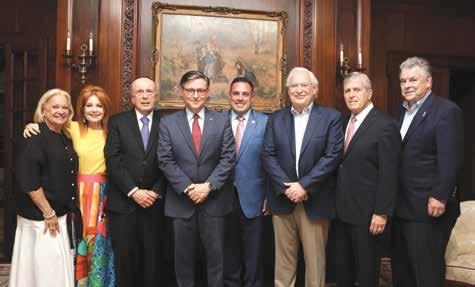

Art and music funding is coming to yeshivas and Jewish day schools across New York State.
This brand-new $5 million art and music program is available for grades K-12 in nonpublic schools, cementing last year’s art and music inaugural funding allocation, and comes as part of the larger, historic $470 million in nonpublic school funding announced last month as a part of the New York State FY25 budget.
“We are very grateful to have funding that will support our amazing productions that literally transform these girls’ lives,” Pnina Fogel, a teacher at Torah Academy for Girls (TAG), says. “Funding for art and music really allows them to excel in that creative space.”
The sheer range of possibilities this program provides is incredible, offering more than just straightforward drawing, painting, and music classes. For the first
time, schools that engage in performing arts will be able to use funds from this program to help cover the cost of their annual productions. For TAG, an all-girls school in Queens that places a large emphasis on these performances, this funding is huge.
“Our annual production is an opportunity for girls to explore elements of themselves that go beyond regular academics,” Fogel explains. “They get into all areas of a performance: onstage, behind the scenes with set design, costumes, multimedia design, and more. Sometimes we’ll see a girl who struggles in the classroom but really gets to shine onstage, building her confidence, supporting her social-emotional wellbeing, and tapping into her creativity.”
Schools say that these productions complement the schools’ regular programming, building a sense of commu-
nity and collaboration across the grades, enhancing peer relationships as well as teacher-student relationships. It’s a winwin for everyone.
“This program will strengthen and expand already existing art and music programs within our schools without having to navigate difficult budgetary constraints that can often be a barrier to these types of offerings,” says Sydney Altfield, executive director of Teach NYS. “It is cultivating an environment that supports every student, both academically and personally.”
In addition to STEM teachers, art and music teachers employed by Teach NYS member schools are eligible to earn Master’s in Education degrees at reduced cost through exclusive Teach NYS partnerships. Art and music educators can now earn these degrees through SUNY Empire, Gratz College, and most recent-
ly, Touro University. Depending on the chosen program, the cost ranges from under $10,000 to $13,000, which represents savings of up to 54% off standard tuition rates.
Participating schools also benefit, as they then qualify for partial salary reimbursement from NYSED’s education programs for each teacher who completes a graduate degree in one of the abovementioned areas. Many schools will cover the cost of these degrees for their art and music teachers since they will receive annual partial salary reimbursements per teacher. This arrangement enhances educational offerings and generates additional revenue for the schools.
For more information, visit teachcoalition.org/mastersprograms.





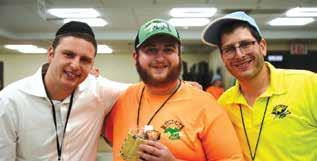














Our campers ventured to some amazing locations this week including Ring Homestead, Club Getaway, Adventure Park, Bounce, Spring Gymnastics, and more!
The fun continued on our campus with a variety of special events and activities such as Builder’s Bonanza, a wacky science show from Dr. Shnitzel, an animal show, our incredible swim program, and unique specialties!
This week, we celebrated a significant achievement with a siyum for the completion of Mishna Moed Katan. Campers participated in this meaningful ceremony, highlighting their dedication and hard work in their Torah learning!
We concluded the week with a special Shabbat celebration featuring iMovewithNaz. The energy and enthusiasm were infectious as the girls danced and enjoyed the lively atmosphere.
Adding to the excitement, we were thrilled to welcome NY Mets stars Mark Vientos and DJ Stewart! Our campers had the unique opportunity to get autographs, take photos, and even have a catch with real MLB players. It was a dream come true for many of our young baseball fans!
This summer, our campers have been actively participating in our dynamic league play, proudly wearing their Hillel

Day Camp athletic department jerseys.
The spirit of teamwork and sportsmanship has been truly inspiring as they compete and develop their athletic skills.
For campers interested in diving deeper into specific areas, our unique specialty track offers dedicated time for coding, STEM, maker space, and art. These focused sessions allow campers to explore their passions and develop new skills in a supportive environment.
Thank you for being a part of our Hillel Day Camp family and sharing in these wonderful experiences. Follow the action throughout the week on Instagram @hillel_day_camp

Camp Nageela, JEP of Long Island’s flagship program, is in full swing with girl’s session. The 120 girls who are attending resulted from the efforts of the volunteers and staff who worked throughout the winter providing quality programs and Jewish outreach to hundreds of families.
What happens in camp when the observant way of life meets the “Jewish in my heart” life? Here are some unsolicited comments.
A staff member was overheard saying, “I have such a new perspective on my way of life.” A young camper was overheard saying, “When I get home and my mom asks me what I want to do with my life I will tell her, Camp Nageela staff.” A young staff member was overheard inquiring from head staff what her relationship with a camper who is not so interested in Judaism should be. She was guided that her job is simply to be genuine and caring. Judaism, when practiced and implemented fully, will speak for itself. An older camper was overheard saying, “I don’t know so much about Judaism now, but I know that I want to be like [a past camper who is currently staff.]”
A remarkable thing about this year is the recurring discussions about antisemitism and current events. The camp encourages them that the answers are Jewish education and unity. The beautiful harmony that exists between girls of all backgrounds is a tremendous answer to these questions.
On the subject of unity, a valuable lesson in unity was learned and implemented in camp the past two days. Campers and staff saw the tremendous outpouring of support for them from the community.
On July 14-15, JEP/Camp Nageela held its annual “4Hashem” matching campaign. The campaign was a resounding
success, thanks to the dedicated efforts of the Camp Nageela staff and their team of ambassadors.
Executive Director Ohavia Feldman, alongside Rabbis Yitzchok Wurem and Chaim Gitelis, led the campaign headquarters, working tirelessly for two days to ensure its success. “It was truly heartwarming to see all the staff completely committed to this amazing cause,” said Director Rabbi Dovid Shenker.
Their relentless hard work paid off, with the staff alone raising an impressive $100,000. JEP/Camp Nageela extends heartfelt thanks to all the donors and teams whose contributions made this campaign such a triumph.
In the words of one camper, “That’s a lot of money. It’s so nice of them to help us.”
Rabbi Shenker’s response was, “Remember that they are helping you because they believe in you. You are the future of the Jewish People. “









The third week of Avnet Country Day School sped by with endless activities and adventures. There was non-stop fun both on and off campus for campers in all divisions. The youngest Tipot baked delicious cupcakes, learned to swim and paid close attention to the parsha in Chinuch. They also enjoyed trips to Planet Play, Once Upon a Treetop and Casa de Spin. Memories were made by the Ma’ayanot girls who met baby chicks in Orienteering, created master-
pieces in Arts and Crafts and showed off their singing in Music. They even demonstrated their acrobatic skills at Laser Bounce. Teamwork was in full swing for the Ma’ayanot boys as they competed in Softball and Net Leagues. They jumped to new heights at Laser Bounce and prepared delicacies in Country Cooking and Culinary. The Agamim girls experienced a magical week with a show-stopping trip to “Wicked” on Broadway. Not to be outdone, the G’vaot and Harim boys had




a fantastic time cheering at a wild Long Island Ducks baseball game – final score was 15-12! An incredible project got underway as the oldest boys in B6 an B7-8 started making tzizit for Israeli soldiers.
A creative highlight for everyone was Avnet’s annual “Jack Tarzik Crazy Hat Day.” Campers showcased their style and spirit when each group selected a theme and then got to work crafting hats to display on a musical march around the gym. Stay tuned for next week!




The following task involves several steps, but they are out of order. Arrange them so that a person who follows the steps exactly can perform the task:
A procedure is needed to change all the red traffic lights in a small town to green, and vice versa.
(Luckily there are no yellow lights in this town and also no lights that don’t work). Assume that you have a street map that shows the locations of all the lights.

a) If all lights on your map are marked “done,” skip the next six statements.
b) If the light is red, skip the next two statements.
c) Turn the light red.
d) Turn the light green.
e) On your map, mark the light you just changed as “done” and go back to the first statement.
f) Find a light that is not marked “done” on your map, and check whether it is red or green.
g) Skip the next statement.
h) End
h) End
e) On your map, mark the light you just changed as “done” and go back to the first statement.
d) Turn the light green.
g) Skip the next statement.
c) Turn the light red.
b) If the light is red, skip the next two statements.
f) Find a light that is not marked “done” on your map, and check whether it is red or green.
a) If all lights on your map are marked “done,” skip the next six statements.
The tasks should be put in the following order:
Answer
A guy parks his bicycle outside the U.S. Capitol. Security comes to him and says, “You can’t park your bike here. Don’t you know that congressmen, senators, speaker, vice president, foreign dignitaries, and the President come here often?”
The guy replies, “Oh don’t worry, I chained my bike!”

Upset that Trump didn’t consult with you before picking his running mate? Answer these questions to see whether you are an expert on the vice presidency.
1. Who did Trump pick as his 2024 running mate?
a. Marco Rubio
b. J.D. Vance
c. Doug Burgum
d. Senter F. Commish
2. Who is the only vice president in the 20th century who was elected to the presidency upon the completion of his vice presidential term?
a. Richard Nixon
b. Harry Truman
c. George W. Bush
d. Al Gore (please don’t pick this one...get over it!)
3. Which vice president was actually charged with murder?
a. Elbridge Gerry
b. John Calhoun
c. Aaron Burr
Answers:
1. B- I case you are wondering, he is 39 years old. Not bad, for a guy who has not yet celebrated his 40th birthday.
2. C
3. C- In a 1804 duel, Thomas Jefferson’s VP, Aaron Burr, shot and killed Alexander Hamilton. He was charged for murder in New Jersey and New York but was never brought to trial. Or as some same, AAWOON BUUWW (“Got Milk?!”).
4. A- John Breckinridge began serving at the age of 36 under President James Buchanan in 1857, just one year above the office’s age of eligibility. Just so you know, the oldest was Alben Barkley, who became Harry Truman’s veep in 1949 at the age of 71. (Because you really needed to know that.)
5. A- Vice President-elect Andrew Johnson arrived in Washington ill from typhoid fever. The night before his March 4, 1865 inauguration, he fortified himself with whiskey at a party hosted by his old friend, Secretary of the Senate John W. Forney.
d. Dick Cheney (please don’t pick this one...get over it!)
4. How old was the youngest vice president when he took the oath of office?
a. 34
b. 36
c. 40
d. 42

5. Which vice president took the oath of office while drunk as a skunk?
a. Andrew Johnson
b. Thomas A. Hendricks
c. Garret A. Hobar
d. James S. Sherman
6. Which U.S. president had three different vice presidents?
The next morning, hung over and confronting cold, wet, and windy weather, Johnson proceeded to the office of Vice President Hannibal Hamlin, where he complained of weakness and asked for a tumbler of whiskey. Drinking it straight, he quickly consumed two more. Then, growing red in the face, Johnson entered the overcrowded and overheated Senate chamber. After Hamlin delivered a brief and stately valedictory, Johnson rose unsteadily to harangue the distinguished crowd about his humble origins and his triumph over the rebel aristocracy. In the shocked and silent audience, President Abraham Lincoln showed an expression of “unutterable sorrow,” while Senator Charles Sumner covered his face with his hands. Former Vice President Hamlin tugged vainly at Johnson’s coattails, trying to cut short his remarks. After Johnson finally quieted, took the oath of office, and kissed the Bible, he tried to swear in the new senators but became so confused that he had to turn the job over to a Senate clerk. (From senate.gov.)
6. C- President Franklin Roosevelt had John
a. Theodore Roosevelt
b. Abraham Lincoln
c. Franklin D. Roosevelt
d. Harry S. Truman
7. What word did Dan Quayle misspell while moderating an elementary school spelling bee when he was Vice President?
a. onomatopoeia
b. connoisseur
c. diphtheria
d. mnemonic
e. potato
8. Which state was Joe Biden senator of before becoming the VP?
a. Confusion
b. Delaware
c. Pennsylvania
d. Washington, D.C.

Nance Garner, Henry Wallace and Harry Truman as his vice presidents, but then he was elected to four terms.
7. E- He spelled it potatoe.
8. B- Delaware Wisdom Key
6-8 right: You are hereby granted a poli-sci degree! (Every wonder what it takes to get a degree in political science? “OK, class, today we are going to talk about whether Biden is doing a good job or not? Hmm… he pushed the nuke button instead of his alarm clock snooze button. What do you guys think; how will that affect his poll numbers?”
3-5 correct: You are right in the middle. Good but not great, you just need to have more time to read up on useless information. But then again, not everybody gets to do nothing all day...that job is reserved for veeps.
0-2 correct: Mr. Biden, it is time for you to remember that you used to be the senator of D-E-L-A-W-AR-E. At least get that one right.

By Joan Zlotnick
Brick by Brick: Building an Ahavas Yisrael Mindset One Story at a Time is a collection of stories, most of them written by Jews who have had encounters with Jews unlike themselves that have been eye-opening and in some instances life-changing.
The underlying message of the book, as suggested by the title, is that through connection with and acts of kindness to our fellow Jews, however small, each of us can participate in hastening the arrival of the Geula, a period of peace, during which we will witness the rebuilding of the Bais Hamikdash, an end to the persecutions we have experienced as Jews, and a restoration of our rightful place of honor among the nations.
Recent events make the message of the book more relevant than ever. When we started the project, during the Covid epidemic, we were especially concerned about the strife among Jews brought on by the resistance of certain groups to vaccinations and their refusal to take other precautions to curb the spread of the pandemic. As time went on, we were distressed by the divisiveness of Israelis over judicial reform, especially the increasingly ugly rhetoric and violent confrontations between protesters and the police.
Things changed radically following October 7. There was an enormous outpouring of achdus. Jews of every stripe rallied together in the wake of the horrific event. My daughter-in-law and I were eager to build on this momentum by spreading the message of our book.
Fast forward a few short months: we have seen a deterioration of that unity as Israeli politicians and citizens are once again at loggerheads over the course of the war. Increasingly large groups of protesters are demonstrating almost around the clock. The war cabinet has splintered because of diverse opinions over how the war should be conducted, vicious accusations are being made against elected officials,
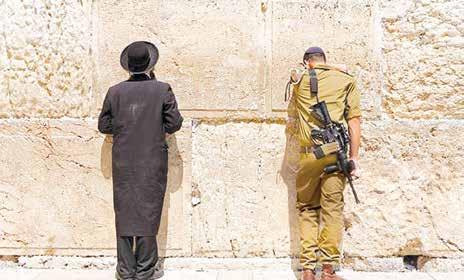
many of them public, and there are calls for early elections. All of this acrimony and divisiveness weakens us in the eyes of the world and makes our enemies rejoice and, moreover, feel more confident that they will achieve their goals.
As for American Jews, the erosion of strong support for Israel in the wake of October 7 has been disheartening and the spread of antisemitism alarming. Most astounding to some has been the realization of how deeply antisemitism is embedded in our universities.
As a retired professor of English at Brooklyn College, I have known this for over two decades. Early in my academic career, as organizer of the UJA Luncheons, I was able to recruit many secular Jews from my department to attend. As time went on, the numbers dwindled, until only one person signed up for the annual event: she was an Italian Catholic. Following the Sabarro suicide bombing in 2002, I was told by a Jewish colleague that the problem of terrorism could be quickly resolved if the Jews just picked up and moved somewhere else.
As unbelievable as it sounds, she was not alone in embracing this view. My last vote before I retired 12 years ago was against the promotion to full professor of
a Palestinian who was grossly unqualified but whom my radical colleagues were eager to promote. This would secure its standing as one of the most radical departments on campus. I was, as expected, the only faculty member in the department to cast a negative vote. Sadly, but predictably, it didn’t make a difference.
Moreover, with grandchildren on five college campuses — MIT, Sara Lawrence, University of Chicago, Yale and Columbia some more antisemitic than others, but all antisemitic to one extent or another — I know from a different perspective how challenging it is for young Jewish students to deal with the threats they face on a daily basis. My grandson at Columbia, arguably the worst of these campuses, has been debating about whether or not to transfer out. The extent of hatred towards Israel and Jews and its perniciousness has been shocking to many who have had no affiliations with college campuses, but it has neither surprised nor shocked me.
What can we here in America do in view of the horrific events of the last few months in the Middle East and the unimaginable upsurge of antisemitism closer to home? We have upped our tzedakah, joined Tehillim groups, attended rallies,
collected and shipped food, clothing, and medication to those displaced from their homes or defending our homeland, and gone on missions to Israel to support our fellow Jews. Jewish philanthropists have stopped supporting many universities, the public outcry has forced a number of college presidents who have failed to protect their Jewish students out of office, and the number of applicants at many top universities has fallen precipitously.
I think there is something more we can do. It’s more abstract than any of the measures described above: it’s adopting the mindset of Ahavas Yisrael. It is this, we are told again and again, that will bring on the Geulah, which is something we desperately need now.
When the so-called civilized world questions our right to defend ourselves against our monstrous enemies, doubts the claim of the Jewish people to their homeland, pressures us to reward the vile and despicable acts of October 7, and urges us to show “restraint” in our response to the more recent attack by Iran; when we see before our very eyes antisemitism, described by Rabbi Jonathan Sacks as a sickness that never goes away, mutating, emerging in new forms, changing with the social, economic and political climate, it becomes clear that this is a plague we have not and seemingly cannot, despite every effort, bring to an end on our own. When we feel that never again is now, we have to make sure to bring Hashem in as our partner: doing what He has promised us will be the reward when we take seriously the obligation to love our fellow Jew.
This doesn’t mean that we stop doing everything possible to fight the scourge of hatred and violence with all the resources we have, but this is something additional we can do. If it was Sinas Chinam that brought about the destruction of the Bais Hamikdash and sent the Jews into exile, it is its opposite, the embrace of our fellow Jews, that will bring about the Geulah, and,
with it, the achievement of a goal that for millennia has been impossible for us to achieve on our own.
Little did I know when my daughterin-law approached me about publishing a book on Ahavas Yisrael how involved and passionate I would become on the subject. As the project got underway, I reached out to find contributors, edited and occasionally wrote stories told to me, and wrote two of my own. I was deeply moved by all the inspiring stories I heard from the contributors. I learned about unlikely encounters with Jews with different outlooks and lifestyles with whom they developed meaningful and sometimes deep connections. I learned not only about these encounters, but also about some amazing individuals and organizations dedicated to building bridges between Jews.
These stories moved me in a way that books or stories about the Gedolim do not. These were not about exalted figures whom we cannot imagine emulating, but, rather, about ordinary people like us. The contributors are themselves an eclectic group, professional and first-time authors, rabbis and laymen, religious and secular, Modern Orthodox, Conservative, black hat, Chassidim, Americans, and Israelis. Taken together, the pieces weave a tapestry of
different kinds of Jews and organizations, showing that, despite our differences, we are one people.
Some of these stories were paired together and presented under the rubric of Acts and Impacts. One of these, by Shelly Mohl, is about the founding and mission of the Yeshiva of Manhattan Beach, in Brooklyn, and the impact that school had on one of its pupils, a starving and desperate child,
wonderful rabbi brought enormous comfort and joy to my husband z”l — and to his fellow residents, their families, and me — when, no longer able to remain at home, my husband was living in a Cognitive Support Facility. Paired or not, these stories are all about people who cease to see Jews unlike themselves as “other,” which not only alters their perspective but, in some instances, also their lives.
Taken together, the pieces weave a tapestry of different kinds of Jews and organizations, showing that, despite our differences, we are one people.
who claims that her life was saved by the kind and loving acts of its administrators and faculty. One of the pieces I wrote, “The Power of Chabad,” was paired with a story by Rabbi Boruch Jacobson, who describes his upbringing and Chabad’s philosophy about reaching out to their fellow Jews. My story details the ways in which this
It was my daughter-in-law’s idea to include pieces about the efforts of particular individuals and organizations to build bridges between religious communities, and she put in endless hours pursuing this angle. One of these powerful stories detailed the backstory of the most recent Siyum HaShas at MetLife Stadium. In the
years of planning that went into the event, which drew 90,000 Jews, accommodations were made to meet the needs of every person in attendance and make him or her feel like an important and valued member of the Jewish community.
At this dark time in our history, these stories uplift and inspire us. They teach us that there is something important we can do in addition to all our other efforts to bring a decisive victory to Israel and an end to the scourge of antisemitism. Through our own interactions with our fellow Jews, we can hasten the arrival of the Geulah. If not us, who? If not now, when?
Joan Zlotnick is a retired professor of English at Brooklyn College. While most of her early publications have been scholarly, more recently she has written and lectured on the subject of caregiving and grief. These works include a column for Mishpacha Magazine; an enovel, Griefwriting (Amazon); and a memoir/ self-help book, Holding it Together: Surviving Caregiving and Loss (Tfutza). Her latest book is Brick by Brick: Building an Ahavas Yisrael Mindset One Story at a Time (Mosaica), a collection of stories she edited with her daughterin-law, Grunny Zlotnick. It is available online and in Jewish bookstores.

There is an eternal debate amongst philosophers and criminologists as to whether the mob boss or the actual hit man is most culpable in the murder of a rival gang leader. Though both are certainly morally guilty, the question as to which one bears the legal onus for the crime, absent statutory law on the matter, is an issue of discussion and differing opinions.
In Judaism, there is a concept “that there is no excuse of agency present when a sin or crime is being committed.” This means that the hit man who pulled the trigger or planted the explosive is certainly the more guilty party, in such a scenario of an ordered murder. In the words of the Talmud “regarding the instructions from the Master and contrary instructions from the student – who should one listen to?!”
Thus, in this week’s parsha, even though it is the malevolent Balak who engages Bilaam in the nefarious scheme to curse the Jewish people, it is Bilaam

By Rabbi Berel Wein

who actually intends and agrees to do the cursing. He and not Balak emerges as the ultimate villain of the event. There is much discussion in the Talmud and in rabbinic sources as to whether any of the laws of agency, and this law in particular,
is inherently wrong to engage an agent to perform an illegal or sinful (they are no longer the same today) act whether in Jewish or general society, whatever the technical legal liabilities may be.
The instigator of a crime is deemed
Balak will pay the penalty for his unwarranted hatred and enmity of Israel just as Bilaam does.
exists outside of Jewish society generally. If there is no agency outside of Jewish society, it appears that, generally speaking, there would be liability on both the instigator and the agent as well in such circumstances. In any event, it certainly
in today’s society to be as guilty as the criminal who perpetrated the crime. Osama bin Laden was the guilty party in the World Trade Center assassinations as much as were the murderous suicide-pilots he sent forth to do the deed. Balak is
responsible for Bilaam’s curses. Heaven, in its exquisite way, administers justice to all concerned in as it pleases and in its own time frame.
Balak will pay the penalty for his unwarranted hatred and enmity of Israel just as Bilaam does. The rabbis of the Talmud even extended the penalties for wrongful and criminal acts committed to include those who remained silent when they should have spoken out against evil and cruelty. Bilaam’s donkey is commended while his associates are undoubtedly condemned and eventually punished – hence the plethora of laws in our world and statutes about conspiracy to commit crimes and criminal negligence. In fact, the actual perpetrator oftentimes attempts to hide behind the façade that one was only following orders. Judaism does not recognize that excuse, and yet the one who issued the orders is also deemed guilty of the crime.
Shabbat shalom.

Whereas in many other parshios we focus on deriving lessons from the subtleties of various pesukim, the whole Parshas Balak is difficult to understand. Adding to the mystery, the Gemara (Bava Basra 14b) says, “Moshe wrote his book [the Torah], parshas Bilaam, and Iyov.” Rashi explains that “parshas Bilaam” refers to “his prophecy and parables, even though these do not serve the needs of Moshe, his Torah, and the events of his life.” This is very difficult to understand. Moshe wrote the whole Torah, including “parshas Bilaam” within Parshas Balak according to G-d’s command. Why does Rashi explain the nature of “parshas Bilaam” in a way that implies it was not part of the Torah at all? The Torah also includes Sefer Bereishis which took place before Moshe was born and certainly does not include “the

By Rav Moshe Weinberger
Adapted for publication by Binyomin Wolf

events of his life.” So why is Bereishis considered part of “Toras Moshe”?
In order to understand what Rashi teaches us, we must first define “Toras Moshe.” Rashi on the Gemara (Chulin 137a) explains that the word Torah comes from the root word “hora’ah, teaching,” so that the essence of the Torah is that it is a “teaching for all generations.” The Maharal at the beginning of Gur Aryeh explains along the lines of the following words of the Ramban that “the Torah includes the stories from the beginning of Bereishis because this teaches people the path of emunah.” All parts of the Torah which teach the Jewish people what they need to know to live as Jews are considered part of “Toras Moshe.” This seems to imply that Rashi teaches us that “parshas Bilaam” has nothing to teach the Jewish people. How can we understand this idea?
The Midrash (Sifri on Devarim 34:10) says, “‘No other prophet has arisen among the Jewish people like Moshe:’ among the Jewish people there has arisen no prophet like Moshe, but there has arisen [a prophet like Moshe] among the nations of the world. Who? This refers to Bilaam.” How could the Midrash compare this sorcerer’s “prophecy” to Moshe, the master of all prophets? The Ramban explains that Bilaam was not a prophet at all and was certainly not even on the level of regular prophets, much less Moshe. What, then, was the similarity? He explains that it was in the clarity of the message. When Moshe opened his mouth, the Divine presence spoke. Similarly, Hashem placed His words directly into Bilaam’s mouth without any room for interpretation. All other prophets received visions which required interpretation through
their own human, albeit lofty, understanding. But Bilaam’s prophetic message was perfectly clear because it came straight from Hashem. Why did Hashem give Bilaam such a clear prophetic message? The Ramban explains that He did so in order to deprive the nations of the world of the ability to claim, “If only we had a prophet like Moshe, we would serve Hashem, too.” He explains (commenting on Bamidbar 22:31) that Bilaam was merely a sorcerer, not a prophet, and that Hashem only gave him the ability to prophesize in order to increase the honor of the Jewish people “because it was Hashem’s will that the Jewish people be blessed through the mouth of a prophet of the nations.” If so, who was the primary beneficiary of Bilaam’s prophecy? The Jewish people or the nations of the world?
I believe that we can understand the answer to this question by studying the Ramban on Parshas Ha’azinu (Devarim 32:26, 40). There, he explains that the Jewish people are G-d’s nation, the only people who know Hashem and through whom G-d’s name becomes known in the world. In addition, he explains that the fundamental reason for antisemitism in the world is the fact that we reveal G-d’s presence in the world. We bring G-d, and therefore conscience, obligation, and responsibility, into a world that doesn’t want to hear of such things. The deeper reason antisemites hate Jews is because they hate G-d. The natural result is that they hate Hashem’s messengers in the world.
Dovid Hamelech said (Tehillim 44:23), “It is for Your sake that we are killed all of the time.” Based on this, the Ramban says, “Because of their hatred for Hashem, they do all of these evil things to us ... He must take vengeance on them.” Since their hatred and oppression of us is because of Hashem, it is His obligation to punish them. It appears that the nations have two basic choices with regard to how to approach the those who reveal Hashem’s
presence in the world, i.e., the “Jewish problem.” They can join with us in revealing the Divine in this physical world by accepting the seven mitzvos which are applicable to them or by converting. Alternatively, they can pursue, oppress, and enslave us. They learned of this
people will be punished. Bilaam’s prophetic message was that the nations’ true mission is to follow the Jewish people by partnering with them to reveal the Divine presence. This is their purpose, their raison d’être. The purpose of Bilaam’s prophecy was to deprive them
We bring G-d, and therefore conscience, obligation, and responsibility, into a world that doesn’t want to hear of such things.
choice through the prophecy of Bilaam. He taught them that the Jewish people are “a nation which dwells alone.”
As Bilaam says in various ways throughout perek 24, the Jewish people will successfully conquer Eretz Yisroel, the land primed to reveal Hashem’s presence in the world, and ultimately, Moshiach will come and all of the nations who have oppressed the Jewish
of the ability to excuse themselves by claiming that they did not know their purpose.
We now understand why Hashem wanted the Jewish people to be blessed by a gentile prophet. He wanted the nations to understand clearly, from one of their own, that the role of the Jewish people is to bring about the revelation of G-dliness in the world. After receiv-
ing that message, the nations must now choose which side of history they will be on.
We can now understand why Rashi explains that “parshas Bilaam” is something separate from “Toras Moshe.” The purpose of the latter is to teach the Jewish people what is expected of them for all generations, while the former was meant as a message primarily for the nations of the world and not the Jewish people. The nations had to be told about the Jewish people’s purpose in Creation, as well as a clear understanding of their own choice in how to relate to the Jewish people.
May we merit, soon in our days, to see Hashem take revenge upon those who have tormented us throughout the generations and the reward of the righteous people among the nations who have joined with us to reveal Hashem’s presence in the world.
Rav Moshe Weinberger, shlita, is the founding Morah d’Asrah of Congregation Aish Kodesh in Woodmere, NY, and serves as leader of the new mechina Emek HaMelech.




By Rabbi Shmuel Reichman
Athree-year old girl was suffering from a rare disease, and she desperately needed a bone marrow donation to survive. Her parents were thrilled when they found out that her older brother, who was eight, was an exact match.
The doctor explained the situation to her brother and asked if the young boy would be willing to give his bone marrow to his sister. He hesitated, only for a moment, before he took a deep breath and said, “Yes, I will do it if it will save my sister.”
As the process began, he lay in bed next to his sister and smiled, seeing the color returning to her cheeks. Then his face grew pale, and his smile faded. He looked up at the nurse beside him and asked in a trembling voice, “When will I start to die?”
The young boy had misunderstood the doctor. He thought he had to give up his own life to save his sick sister.
Throughout the Torah, there are many heroes with awe-inspiring ascents to greatness. When we think of Moshe, we picture a burning bush, a dramatic confrontation with Pharaoh, and a spectacular splitting of the Yam Suf. When we consider Avraham, we imagine a man being thrown into the flames, undergoing bris milah at the age of 100, and the willingness to sacrifice his designated son on the altar. However, when we think of Pinchas, what do we see? The image is hazy, evoking conflicting emotions and begging for explanation. Let us start from the very beginning of the story.
After Bilaam’s attempt to curse the Jewish people failed, he tries to sway

their loyalty through the enticement of harlots. The Jewish people begin committing not only the sin of z’nus (promiscuity) but idolatry as well. Pinchas, upon seeing Zimri’s public act of brazenness with Kozbi, grabs a spear and pierces them both (Bamidbar 25:7–8).
This alarming sequence of events sets off an uproar. The Jewish people are astounded by Pinchas’ actions and degrade him viciously for it. They point out that Pinchas is the grandson of Aharon Hakohen, who facilitated the creation of the Egel Ha’zahav, the centerpiece of the worst sin in Jewish history (Kli Yakar, Bamidbar 25:11). He was also the grandson of Yisro, someone who used to be a priest of idolatry (Rashi, Bamidbar 25:11). They used this lineage as a basis to challenge Pinchas’s intentions, claiming an undertone of hypocrisy to his rebuke. How, they ask, could a person of such descent punish a Nasi of B’nei Yisrael so harshly? What right did he have?
However, Hashem quickly justifies Pinchas’s act, showing its extreme merit by rewarding him with the bris shalom and bris kehunah . The bris kehunah granted Pinchas status as a kohen, something he lacked before this point. Although Pinchas was descended from Aharon Hakohen, he was born before Hashem conferred the kehunah upon Aharon and his sons and was not included amongst those appointed. Although future offspring of Aharon and his sons inherited the kehunah, Aharon’s existing grandchildren did not. However, after Pinchas’s act of valor, Hashem Himself awarded Pinchas the status of Kohen as well. This, however, requires explanation.
What is the deeper meaning behind these two berachos, and why did Pinchas deserve them specifically in response to his actions with Kozbi and Zimri? And, perhaps more importantly, why was Pinchas’s act of killing even considered he -
roic? It appears to be violent and rash, perhaps even worthy of criticism. Why, then, was it rewarded, and so handsomely at that? Let us try to explain the deep principles behind this episode.
The Torah describes Pinchas’ act as one of “kin’ah ,” or zealotry (Bamidbar 25:11). A zealot is one who acts with passion and fervor, an attribute that can easily become radical or extreme. This middah features prominently in the Torah both in the case of Pinchas and earlier with Shimon and Levi in their behavior toward Shechem (Bereishis, chap. 34). After Shechem violates their sister, Dinah, Shimon and Levi take revenge by brutally wiping out his entire city. Yaakov immediately rebukes them for this rash act and later curses their anger when giving the Shevatim brachos at the end of his life (Bereishis 34:30, 49:5–7). Shimon and Levi defend themselves by claiming that they stood up for their sister, and perhaps, in a sense, all of Klal Yisrael, as the entire Jewish nation was cast in a bad light when Dinah was violated. However, Shimon and Levi are clearly criticized for their extreme reaction, suggesting a negative quality to their zealotry.
Pinchas expresses this same attribute of zealotry, spontaneously killing a leader of the Jewish People, and yet he is exceedingly praised and rewarded for doing so. What is the difference between their actions?
A puzzling feature of the story of Pinchas and Zimri is the striking omission of Zimri’s name from the story as it is first told in Parshas Balak. Only afterwards, when recounting the story again in Parshas Pinchas, does the Torah name the
perpetrator of this evil act. Why is this so?
It can be suggested that Zimri’s name is omitted to exclude the possibility that Pinchas’s act was spurred by emotion or a need for personal vengeance. Pinchas had no vendetta against Zimri, no vested interest in killing him. The Torah omits Zimri’s name in order to highlight the fact that Pinchas would have killed whoever committed this sin, regardless of who it was. Pinchas acted only out of love and devotion for Hashem, with absolutely no personal motivation.
Further proof of Pinchas’s pure intentions involves the concept of rodef (a pursuer). (A full discussion and analysis of the concept of rodef is beyond the scope of this article.) Simply put, the principle of rodef allows one to rise up and kill an attacker before the attacker can kill him. According to several opinions, since Zimri was not yet chayav misah (sentenced to death) for his actions, Pinchas would be considered a rodef for trying to kill him. Consequently, Zimri would have been legally allowed to preemptively kill Pinchas first. Thus, by attacking Zimri, Pinchas put his own life in jeopardy, showing the complete altruism driving his actions.
This is the distinction between the actions of Pinchas and those of Shimon and Levi. While Shimon and Levi acted at least in part due to personal anger, as evidenced by Yaakov’s criticism, Pinchas’s zealotry was entirely righteous. The fine line that determines whether zealotry is positive is the intention behind this passion. The outer expression of raw emotion and ego can appear identical to the genuine, selfless desire to act on behalf of Hashem. The differentiating factor that separates ego from idealistic passion is one’s inner, true intentions. A person who is truly zealous on behalf of Hashem is so consumed by love for their Creator that their actions are driven completely by that love and passion, without any personal feelings attached.
In the text of the Torah itself, it seems as though Pinchas acted spontaneously with no hesitation, consultation, or affirmation whatsoever. However, Rashi, quoting the Gemara (Sanhedrin 82a), explains that Pinchas did indeed consult first with Moshe before passionately executing Kozbi and Zimri. This would limit his extreme zealotry to a more calculated and rational passion. Other opinions, though, state that Pinchas did not hesitate, acting immediately and independently. This would explain why it
was so important for Hashem to clarify that Pinchas’s action was indeed an act of heroism and not an inappropriately passionate act of murder. This could also be an interesting reason for the layout of the parshiyos, for although Pinchas’s act of zealotry actually occurred in the previous parshah, Parshas Balak, the praise and reward are not granted until this parsha, Parshas Pinchas. This reflects the confusion that Klal Yisrael experienced surrounding the action. Only in this parsha, once Hashem clarified Pinchas’s proper
those who did not understand him, but that did not deter him from standing up for what he knew was right.
Bris Kehunah
After studying Pinchas’ action in more depth, we can now explain the beauty of the two gifts that Pinchas was awarded. The first was the bris kehunah, an opportunity to join the rest of his family in performing the avodah in the Mishkan. Why was this gift so befitting?
One could suggest that this was sim-
A person who is truly zealous on behalf of Hashem is so consumed by love for their Creator that their actions are driven completely by that love and passion, without any personal feelings attached.
intentions, was it retroactively indisputable that Pinchas acted heroically. This emphasis on intention is particularly striking when viewing the story of Shimon and Levi and that of Pinchas side by side. Zimri was the Nasi of the tribe of Shimon, while Pinchas was from the tribe of Levi. Shimon and Levi originally acted with extreme passion and were criticized for doing so. Here, their descendants seem to be repeating their legacy. Zimri and Pinchas both acted out of passion, with Zimri brazenly committing a sin and Pinchas dramatically killing him. The difference between them was that Pinchas learned to use the middah of kin’ah correctly, controlling his emotion and passion, while Zimri failed and was controlled by it.
The Kli Yakar explains that by engaging in this act of zealotry, Pinchas had to completely negate his ego and disregard his public image and reputation (Bamidbar 25:11). He was willing to undergo the embarrassment and ridicule of those who claimed that his own father married the daughter of an idol worshipper (Yisro) and that his grandfather was involved in the Egel Ha’zahav (Aharon). These claims were an attempt to show that Pinchas was unworthy of condemning Zimri’s act. Nevertheless, Pinchas was willing to sacrifice his reputation to do what he knew was right and to uphold the truth. In doing so, he would face backlash from
most physical and potentially animalistic organ and use it to transcend. This is also why the miracle of Chanukah lasted eight days. (This is also why it occurred through shemen (oil), the same shoresh as shemonah , the number eight.) It is therefore no surprise that the gematria of “kohen” is seventy-five, the number directly between seventy and eighty. The Kohen’s role is to connect the higher and lower, the spiritual and physical, and the infinite and finite. This is achieved specifically in the Beis Hamikdash, or Mishkan, the place of connection.
By killing Zimri and putting a stop to the rampant sinning occurring within Klal Yisrael, Pinchas both prevented further sin and was mechaper for their past sins, thereby putting an end to the mageifah . This is the exact role of the Kohen: to help atone for sin and maintain the Jewish people’s connection with Hashem. In doing so, Pinchas earned his right to be a Kohen. Kehunah was not an arbitrary gift; it was the positive consequence of the person Pinchas chose to become — a zealot for Hashem.
ply a generous reward for a heroic act, without intrinsic meaning. One could go even further and say that since Pinchas was the grandson of Aharon Hakohen, this was a very fitting gift, as he could now join the rest of his family in performing the avodah in the Mishkan. To take it a step deeper, perhaps Pinchas was already somewhat a Kohen, due to his spiritual genetics, and once he showed his love and devotion for Hashem, that potential within him was activated, and he emerged as the Kohen he was already capable of becoming. While these are all beautiful answers, I would like to suggest an even deeper approach.
Kohanim serve to foster the connection between both Hashem and this world and between Hashem and the Jewish People. Through the avodah in the Mikdash, the Kohanim connect the physical and spiritual, as well as the Jewish people to their Source.
There are many layers of expression within this idea. As we have discussed previously, the Maharal explains that seven is the number of the natural (Tiferes Yisrael, chaps. 1–2, 25). This is why all physical and natural components of this world are built off sevens: seven days in the week, seven notes in the musical scale, seven colors in the spectrum of light. Eight represents going beyond the natural, which is why bris milah is performed on the eighth day; we take the
In our next article, we will delve deeper into this fascinating topic and try to understand the story of Pinchas on an even deeper level.
May we be inspired to always strive for the higher truth, to stand up for what we know is right, and to live a life devoted to Hashem.
Rabbi Shmuel Reichman is the author of the bestselling book, “The Journey to Your Ultimate Self,” which serves as an inspiring gateway into deeper Jewish thought. He is an educator and speaker who has lectured internationally on topics of Torah thought, Jewish medical ethics, psychology, and leadership. He is also the founder and CEO of Self-Mastery Academy, the transformative online self-development course based on the principles of high-performance psychology and Torah.
After obtaining his BA from Yeshiva University, he received Semicha from Yeshiva University’s RIETS, a master’s degree in education from Azrieli Graduate School, and a master’s degree in Jewish Thought from Bernard Revel Graduate School. He then spent a year studying at Harvard as an Ivy Plus Scholar. He currently lives in Chicago with his wife and son where he is pursuing a PhD at the University of Chicago.
To invite Rabbi Reichman to speak in your community or to enjoy more of his deep and inspiring content, visit his website: ShmuelReichman.com.
By Rabbi Avrohom Sebrow
When Irving Nachumson filed for a patent in 1936, could he have imagined that his invention would be the center of a major halachic controversy sixty years later? Did it cross his mind that flintstones from medieval France might be used to defend his invention?
Inspired by cholent, Irving Nachumson invented the slow cooker. Upon purchasing his company in 1970, the Rival company rebranded his device as the “Crockpot.”
While the crockpot certainly makes it easy to have hot cholent on Shabbos, it does have its halachic issues. This article will focus on the great controversy that erupted in 1995. Chazal decreed that on Erev Shabbos, one should not insulate hot food in a material that adds heat. They were concerned that if one were to submerge his food item in a heat-producing medium, the following week he may submerge his food in coals. One may certainly not insulate his food before Shabbos in hot coals, because he may come to stoke the coals on Shabbos. Therefore, Chazal forbade hatmana, insulating food in a heat-producing medium before Shabbos.
The Crockpot became immensely popular. In 1971, the Rival company recorded $2 million in sales of the product. By 1975, sales reached $93 million. Anecdotally, a sixth grade class was asked this year, “How many of your parents use a crockpot for cholent?” Virtually all boys raised their hands. The Rebbe called on one boy who didn’t, and he said his parents used a slow cooker instead!
The problem with the crockpot is that the insert is surrounded by a metal pot outside that produces heat. It would seem that the use of a crockpot violates the laws of hatmana. (This is a separate issue from the laws of shehiya, leaving even uninsulated food on a fire.) Supposedly, the last ruling that Rav Shlo -
mo Zalman Auerbach, zt”l, gave in his life is that crockpots may not be used on Shabbos because of this very issue. This ruling is cited in Minchas Shlomo, Shulchan Shlomo, Meorei Aish, and in the Torah journal Moriah. In 1995, this caused a major controversy. Shabbos observant families had been using crockpots for years. Some switched to a different appliance where the pot rests on a hot plate specifically made for it. This is now commercially sold as the West Bend slow cooker. There is no issue of hatmana with the West Bend because the pot is not covered at all. It simply rests on a heating element. Some advise users of the original crockpot to place a stone on the bottom. This will raise the insert to a point where hatamana won’t be an issue.
It is interesting to note that the author of Meor Shabbos testified that Rav Shlomo Zalman wrote to him that a crockpot is indeed permitted to be used on Shabbos. Therefore the Meor Shabbos subsequently wrote an additional letter to Rav Shlomo Zalman to clarify reports that he changed his opinion. Alas, the letter was on Rav Shlomo Zalman’s table when he slipped into a coma from which he never recovered. The Meor Shabbos insists that Rav Shlomo Zalman’s son confirmed that he was indeed lenient. Nevertheless, it has been accepted that Rav Shlomo Zalman, zt”l, was machmir.
Still, many other poskim were known to have permitted the use of the crockpot. Years before the controversy arose, Rav Moshe Feinstein, zt”l, is reported to have permitted its use. It is cited in V’Debarta Bam that both Rav Moshe, zt”l, and his son Rav Dovid, zt”l, permitted its use.
A major reason to be lenient is that the Rema writes that one may partially submerge food in heat-producing material before Shabbos. The crockpot insert is only surrounded by heat-producing elements on the sides and bottom. It is
open on the top. Many poskim cite this Rema as a major reason to be lenient.
Still, Rav Shlomo Zalman said that a crockpot is always open on the top! One cooks that way during the week. How can we be lenient on hatmana if that is the way it is always done? Typically, foods used to be completely insulated if one wanted to keep them warm, but not with a crockpot!
Various answers were suggested to this issue. Rav Pinchas Scheinberg zt”l’s approach may find a source in a Tosfos in Bava Basra (19a). Tosfos suggests that in the times of the Gemara no one would submerge a pot in flintstones to keep it warm. The flintstones would damage the pot. Since it was totally uncommon to insulate hot food in flintstones, Chazal never forbade their use. Rabbeinu Tam comments that our custom is to insulate hot food in flintstones before Shabbos. Rav Moshe, zt”l, is incredulous! The only reason that flintstones were permitted by Chazal is because their use was uncommon. How could Rabbeinu Tam write that it became the custom to insulate in flintstones? If it became common to use flintstones, then their use is forbidden! Rav Moshe, zt”l, concludes that it must be that Chazal gave a list of what items were included in the decree of hatmana. Flintstones were not on that list. If Chazal made the decree in medieval France, then flintstones would have been on that list. However, we do not make our own decrees. If it was permitted in the times of Chazal, it remains permitted.

Nachumson’s drawings of a crockpot in a patent that was granted in 1940
is only partially submerged is not subject to the laws of hatmana. Granted, if the decree was made today maybe it would have included the crockpot. However, once the rule was made that a partially submerged item is not subject to the laws of hatmana, it remains that way. Therefore, since a crockpot insert is not covered on top with a heating element, it may be used to insulate the cholent for use on Shabbos.
Rav Shmuel Wosner, zt”l, and Rav Shternbach, shlita, also ruled leniently. Please note it is advisable to use a blech with a crockpot and to cover the knob for a different halachic reason.
So, too, Rav Scheinberg suggests the same logic could be applied to the crockpot. Chazal said that an item that
Rabbi Avrohom Sebrow is a rebbe at Yeshiva Ateres Shimon in Far Rockaway. In addition, Rabbi Sebrow leads a daf yomi chaburah at Eitz Chayim of Dogwood Park in West Hempstead, NY. He can be contacted at ASebrow@ gmail.com.

This week, Shabbos, the 14th of Tammuz, marks the 37th yahrtzeit of Moreinu HaRav HaGaon Rav Yitzchok Ruderman, zt”l, the Rosh Yeshiva of Ner Yisroel. What follows is an account of the Rosh HaYeshiva’s schedule in the Slabodka Yeshiva as well as how the Rosh Yeshiva was kidnapped as a bochur.
Newspapers abound with headlines of Russia attacking Ukraine. But there was another Russian takeover of Ukraine that occurred over 100 years ago in 1919. It was while the Slabodka Yeshiva was in exile in the Ukrainian city of Kremenchug.
1882 was the year that two things happened in in the surroundings of Kovno. The first thing that happened was that Alter of Slabodka, Rav Nosson Tzvi Finkel, had founded the Slabodka Yeshiva, wherein the study of Mussar became a prime focus. The second thing that happened was that construction began on the Kovno system of buttresses and fortresses that was ordered by decree of Tsar Alexander II three years earlier on July 7, 1879.
That year, in 1882, the Jewish res -
By Rabbi Yair Hoffman

idents of Slabodka did not realize that the construction of the Kovno forts would eventually lead to disaster. It would cause paranoid Tsarist Russia to force the Jews out of Slabodka and Kovno into exile in the First World War. It would lead them through a harrowing experience of wandering in exile, being jailed both by the Russians and the Germans and r”l many deaths.
But for those first 33 years, the Yeshiva in Slabodka accomplished the near impossible. It revitalized the Torah world, and took the place of Volozhin as one of the leading yeshivos in Europe. It opened up branches and influenced the other yeshivos in Lita to introduce a Mussar curriculum.
Rav Ruderman’s general schedule in Yeshiva was as follows:
In the summer, Shacharis took place at 7:00 AM, but in the winter, it took place at 8:00 AM. Morning seder began at 9 AM, and in the winter, it began at 9:30. First seder lasted until 2:30 PM. Second seder was between 4 PM and 8 PM, but in the winter, it changed from 4:15 to 9 PM. Mussar Seder was always between 9:00 PM and 9:30 PM. Night Seder was from
after Maariv until 11:00 PM.
On Shabbos, during Bain HaShmashos, there was a period of time set aside for cheshbon hanefesh on the entire week that had passed.
In the summer of 1914, war was about to erupt.
On July 28, Austria-Hungary declared war on Serbia because of the assassination of Archduke Franz Ferdinand one month earlier. Russia came to Serbia’s defense, and by August 4, Germany, France and Britain, along with their respective colonial empires, entered the war. In November, the Ottoman Empire, Germany and Austria formed the Central Powers. In April of 1915, Italy, Britain, France, Russia and Serbia formed the Allied Powers.
As bizarre as it may sound, Kaiser Wilhelm and Tsar Nicholas II, who were battling each other fiercely, were both grandsons of Queen Victoria of England (in the case of Nicholas II it was through his wife). They had sent letters to each other, each claiming their desire to avert war. But it was not to be.
The war that would kill 11 million people began a day later.
The Russian military authorities decided that the Jews were untrustworthy and could not reside next to the Kovno fortress. They were forced into exile. Worse yet, many of the yeshiva’s students and rebbeim were drafted into the Tsarist Russian army.
The Yeshiva and its students, including Rav Ruderman, scattered. At this time, the Alter of Slabodka was seeking treatment in Germany for a medical ailment. He was soon captured and jailed as an enemy alien by Germany on account of being a citizen of Russia. A young fifteen-year-old Rav Shach was the last one out of the Yeshiva building, not knowing where to go. Rav Moshe Mordechai Epstein, the Rosh Yeshiva, managed to relocate to the city of Rezekne in Eastern Latvia. Rezekne was located some 194 miles northeast of Kovno.
While in Rezekne, Rav Moshe Mordechai made every effort to reconvene the Yeshiva. He needed to raise vast sums of money to get the students and rebbeim released. He sent letters and telegrams. After consulting with the other members of the Yeshiva’s admin-
istration, Rav Moshe Mordechai Epstein decided to relocate the Yeshiva to Minsk about 170 miles from Kovno and further into Russia.
Minsk
Why was Minsk chosen? It was one train ride away, and many of the students either lived there or had found shelter there. Minsk had an established Torah community and would welcome the Yeshiva. Also, most of those whom Rav Moshe Mordechai had contacted expressed the desire to relocate there.
The relative calmness, however, did not last. Minsk was to become the frontline, once again of the battle between Russia and Germany. And Germany was using poison gas.
The Yeshiva administration decided to split the Yeshiva in two. One part, including the Alter, Rav Moshe Mordechai, and Rav Avrohom Grodinsky, went to Kremenchug in the Poltava Province, about 418 miles south from Minsk and a little more to the east. Rav Ruderman went with this group.
The other group, which constituted over 150 of the Yeshiva’s students, including Rav Yitzchok Isaac Sher, the Alter’s son-in-law, and Rav Dov Tzvi
Heller, was to remain in Minsk. Soon, however, those that remained in Minsk had to evacuate as well and joined with the other group in Kremenchug.
Most of the Jewish residents of Kremenchug at the time were devout Chabad chassidim. They had heard of the famed Yeshiva in Slabodka and went out to greet them when they heard of their arrival. Imagine their shock.
Rav Yaakov Ruderman, zt”l, the future Rosh Yeshiva of Yeshiva Ner Yisroel in Baltimore, recalled this most dangerous time in his life in the introduction to the Avodas HaLevi. In Kremenchug, Rav Ruderman was kidnapped by a band of lowlifes at gunpoint. They demanded the sum of 10,000 rubles or they would take his life. He was taken to the home of the Rosh Yeshiva, Rav
They demanded the sum of 10,000 rubles or they would take his life.
Chabad people, generally, do not shave their beards. With few exceptions, Slabodka talmidim did. It was part of the Alter’s philosophy of gadlus haadam . Slabodka talmidim also dressed in straw hats and fashionable suits and ties. Eventually, however, the townspeople of Kremenchug acclimated quickly after seeing and conversing with the Rosh Yeshiva, Rav Moshe Mordechai Epstein.
Moshe Mordechai Epstein, who did not have any money with him. As they were taking him out to kill him Rav Ruderman, Rav Epstein ran out and began yelling and screaming to draw a crowd. The ruffians turned to shoot but saw that their case was hopeless as a significant crowd had gathered. Rav Ruderman was then released unharmed. He later, of course, became the Rosh HaYeshiva of Yeshiva Ner Israel in Balti-
more and taught thousands of talmidim. Rav Ruderman arrived in the United States in 1931. The plan was to assume a position under his father-in-law, Rabbi Sheftel Kramer, zt”l, who was Menahel Ruchani of the Yeshiva of New Haven. In 1933, he became the rav of the Tiferes Yisroel Shul in Baltimore. It was there that he opened the Yeshiva, with the permission of the shul. Five talmidim from Cleveland joined him in Baltimore. Rav Ruderman was one of five talmidim of the Alter who had planted the seeds of Torah in the United States. The five were: Rav Yitzchok Ruderman, of course, Rav Aharon Kotler, zt”l; Rav Yitzchok Hutner, zt”l; Rav Dovid Leibowitz, zt”l; and Rav Yaakov Kamenetsky, zt”l, Rav Ruderman’s cousin.
Many of Rav Ruderman’s talmidim entered into chinuch positions across the nation. Today, the United States is a very different Torah world on account of this remarkable tzaddik and gaon. Yehi zichro baruch.
This article should be viewed as a halachic discussion and not practical advice. The author can be reached at yairhoffman2@gmail.com.

By Rav Daniel Glatstein
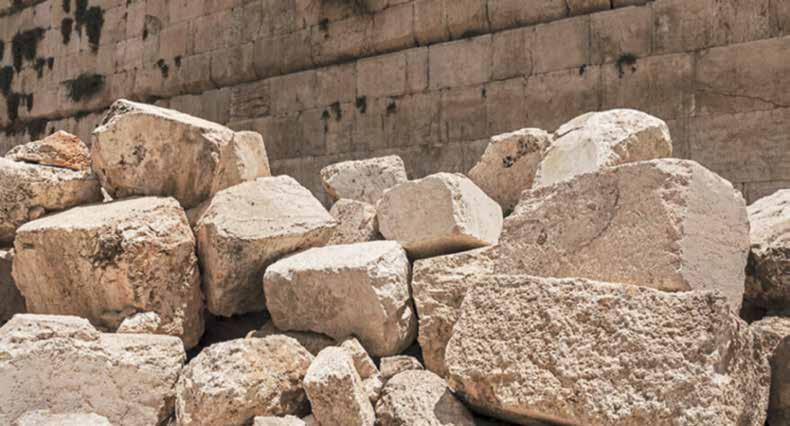
The Mishnah in Maseches Taanis lists five tragedies that occurred to our ancestors on Shivah Asar B’Tammuz and another five on Tishah B’Av. Shivah Asar B’Tammuz was the date on which Moshe Rabbeinu shattered the Luchos when he descended from Har Sinai and found the Jewish people worshiping the Eigel It was also the date on which Kohanim were no longer able to bring the korban tamid in the Beis HaMikdash and when the walls of the city of Yerushalayim were breached. On that date, Apostumos set a Sefer Torah on fire and erected an idol in the Beis HaMikdash.
Let’s begin by analyzing these tragic events and identifying when they actually occurred.
The first of the list, nishtabru haLuchos, took place in the Midbar, shortly after the Bnei Yisrael left Mitzrayim. They were encamped around Har Sinai awaiting Moshe’s return when they succumbed to the pressures of Moshe’s absence and sinned with the Eigel HaZahav, the Golden Calf.
Cessation of the Korban
There are several opinions as to when the cessation of the korban tamid occurred. The Yerushalmi brings two viewpoints. Rav Shimon posits that it was during the time of Bayis Sheini, the Second Beis HaMikdash, when the Greeks rendered it impossible to continue to bring the daily sacrifice. Rav Levi agrees that it happened during the Second Beis HaMikdash era, but he is of the opinion that it was the Romans who stopped the korban tamid from being brought. The Rambam writes that the Bavliim, the Babylonians, stopped the korban tamid from being brought during the time of the First Beis HaMikdash. Rashi on Sefer Daniel (8:14) advances that the decree to
stop offering the korban tamid was the result of another edict issued by the Greek general, Apostumos.
The Walls of Yerushalayim Were Breached
The walls of Yerushalayim were breached on the seventeenth of Tammuz during the period leading up to the destruction of the Second Beis HaMikdash. There is a disagreement between the Talmud Bavli and Talmud Yerushalmi as to when the city wall was breached during the era of the First Beis HaMikdash. The Bavli, based on a pasuk in Yirmiyah, tells us that the walls were breached on the ninth day of Tammuz. The Yerushalmi states that they were breached on the same date as at the time of the Second Beis HaMikdash: on Shivah Asar B’Tammuz, the seventeenth of Tammuz. The Yerushalmi then explains that the pasuk in Yirmiyah is in error.
Tosafos wonders what the Yerushalmi means. After all, how can a pasuk in the Navi be wrong? Tosafos explains that there was great chaos during the period leading up to the destruction of the First Beis HaMikdash. The citizens of Yerushalayim were confused, and they lost track of the date. They mistakenly thought that the day on which the city walls were breached was the ninth of the month, when in fact it was the seventeenth. In recording the tragic events of the Churban, Yirmiyah HaNavi intentionally wanted to preserve this sense of confusion that was prevalent at that time. He deliberately wrote the wrong date in the pasuk to impress upon us the hardships of the Jewish people. They were so overwhelmed that they could not even keep track of the date.
The Mishnah mentions Apostumos and the heinous acts he committed. Apostumos was a Greek general, and it was toward the beginning of the era of Bayis Sheini that he set a Sefer Torah ablaze.
Tiferes Yisrael comments that the Sefer Torah burned
by Apostumos was written by Ezra, and it was known as the authoritative text. Alternatively, Tiferes Yisrael offers that Apostumos actually tried to burn all Sifrei Torah.
The Mishnah teaches us that this was a second nefarious act committed by Apostumos; namely, erecting an idol in the Heichal. Rashi, however, writes that this odious act was actually performed by King Menashe, during the First Beis HaMikdash era.
The shattering of the Luchos clearly occurred many years before any of the other events listed in the Mishnah. According to Rashi, the next event listed should be the atrocity of placing an idol in the Heichal, committed by King Menashe during the First Beis HaMikdash period. Why, then, is it listed last, after events that clearly happened during the Second Beis HaMikdash era?
According to the Bavli, the walls of Yerushalayim were breached only on the seventeenth of Tammuz in the days leading up to the destruction of the Second Beis HaMikdash, not the first. Why, then, does the Mishnah place this event prior to mentioning that Apostumos burned the Sefer Torah, which happened many years earlier?
Let us explore these five tragedies, and perhaps we will identify a common thread that unites them and thereby achieve a better understanding of the order in which the Mishnah lists them.
Why Did Bilaam Choose the Eigel?
Balak employed Bilaam to curse Klal Yisrael. Bilaam set out to identify a point of vulnerability that he could use to undermine the Jewish nation. The Torah tells us, “Bilaam saw that it was good in Hashem’s eyes to bless Israel, so he did not go as every other time toward divinations, but he set his face toward the Wilderness” (Bamidbar 24:1). Rashi advises us to utilize the interpretation of the Targum as we seek to understand the pasuk.
“And Bilaam saw that it was correct before Hashem to give Klal Yisrael a bracha, and he did not do what he ordinarily would have done, to seek counsel from the snakes, and instead he faced the Eigel that the Jewish people worshiped in the desert” (Targum Onkelos, ibid.).
Bilaam was unable to find a point of vulnerability at that time, so he opted instead to turn to the sin of the Eigel that had taken place many years prior. He sought to hone in on the sin of the Golden Calf in his quest to bring about the downfall of the Jewish people.
Why did he choose to utilize the Eigel as his point of attack against the Bnei Yisrael?
In Tehillim, chapter 106, David HaMelech relates various events that transpired while Klal Yisrael was in the Midbar. Included in this perek is a verse that references the Cheit HaEigel. “ They exchanged their Glory [i.e., Hashem] for the likeness of a grass-eating ox” (Tehillim 106:20).
Why does David HaMelech mention the ox’s diet? It would suffice for him to merely mention that the Bnei Yisrael sinned by directing their service to an ox rather than to the Ribbono Shel Olam. Why mention that the ox eats grass? The last two words of the pasuk seem superfluous.
The Arizal teaches that the soul of Bilaam’s father, Be’or, was somehow trapped in the Eigel. It was he who cried out, “Eila Elokecha Yisrael.” This gives us insight into Bilaam’s fascination with the Eigel, as his father’s soul was contained within it.
In the sefer Shaar HaGilgulim, the Arizal uncovers an incredible revelation. The wicked Bilaam had two sons, Yunus and Yumbrus. It was they who actually made the Eigel in the month of Tammuz. This further explains why Bilaam employed the Cheit HaEigel in his quest to destroy Klal Yisrael: His sons had been the creators of the Golden Calf, and it therefore held special meaning for him.
When Bilaam traveled with Balak’s messengers, the pasuk tells us: “He was riding on his she-donkey and his two young men were with him” (Bamidbar 22:22). Targum Yonasan ben Uziel is quick to point out who these two servants were: “He sat upon his donkey, and his two young men, Yunus and Yumbrus, were with him.”
The Arizal then explains why the pasuk in Tehillim references the diet of the ox. David HaMelech is not merely informing us of the eating habits of the ox and its choice of food. He is telling us the date the Eigel was created, when the sin of the Golden Calf occurred: It was on the day whose acronym spells eisav, grass: Shivah Asar B’Tammuz! That was the date on which the Eigel was created and worshipped.
Klal Yisrael is likened to a bride and Hashem to the groom. Har Sinai was the site of the wedding, the location where we married our Betrothed, Hashem. We were still at the chuppah when we were unfaithful to Hashem. We committed adultery with the Golden Calf during our wedding ceremony! This is one of the most disgraceful things imaginable — a bride who is unfaithful to her new husband while still under the wedding canopy.
The Historic Revelation of the Aruch LaNer
The Aruch LaNer presents to us a profound understanding of the Mishnah that lists the five tragic occurrences that transpired on the seventeenth of Tammuz. The Mishnah is not merely providing a list of occurrences. Rather, it is teaching us a pattern, a progression
that takes place when Klal Yisrael experiences a downfall. We are being provided with an outline that demonstrates how we experience a yeridah. A five-step path is followed, as seen time and time again throughout our history.
Nishtabru HaLuchos — The Tablets Were Broken
The first step down the road of spiritual decline is nishtabru haLuchos. As long as Jews are engaged in the study of Torah, we are secure. Keviyus itim laTorah, setting fixed times to study Torah, protects us. Learning Torah keeps us from falling prey to the wiles of the yetzer hara; it keeps us from sinning and from pursuing our taivos.

If Klal Yisrael were to collectively utilize these twenty-two days properly, maximizing them to their fullest, we can bring the Geulah.
If learning slackens and Torah is no longer the priority, it is likened to the breaking of the Luchos, and it is the first step of Klal Yisrael’s downward spiral.
Bateil HaTamid —
The Daily Offering Was No Longer Brought
We are required to follow certain routines and we have regular practices in which we engage. Regardless of how little Torah an individual learns on a given day, he still prays three times, puts on tallis and tefillin, and observes Shabbos and Yom Tov.
Next along the progression of decline is the abolishment of these routines that identify us as Jews. When the commitment to limud haTorah falters, the “tamid,” the daily avodah, begins to dissipate. It may start with someone brushing off davening Maariv, saying, “It’s only a reshus, not a chiyuv” (when, in fact, the Rishonim pasken that the Jewish people have accepted it as a chiyuv). Perhaps one may miss zman Krias Shema, at first once in a while, then with more frequency. Davening with a minyan begins to falter, and people may daven in shul only on Shabbos morning. This may progressively decline over time, until the individual is showing up only on Yamim Noraim or even only for Kol Nidrei — if at all. Failure to maintain the temidus, the consistency, of our avodas Hashem is the second rung on the downward spiral.
It all started with disregarding limud haTorah; while this progression may take years and decades to evolve, this is the tragic manner in which Klal Yisrael falters. And it does not end there. Once the steadiness of our mitzvah performance is no longer present, Klal Yisrael is at risk of falling to the next step on the road to destruction.
Huvk’ah Ha’ir — The City Walls Were Breached Without Torah learning and without consistently per-
forming mitzvos, without the daily avodah, the neshama is open prey to the attack of the yetzer hara. Koheles compares the neshama to an ir, city: “ There was a small town with only a few inhabitants” (Koheles 9:14).
Now, the city, the neshama, is unfortified. The yetzer hara attacks, and it succeeds in causing rampant violation of Torah prohibitions. The walls of the proverbial city are breached in all areas, now leading to the complete destruction and conflagration of one’s Torah, the fourth step on the path of destruction.
Sreifas HaTorah — The Torah Scroll Was Burned
Limud haTorah became unimportant, consistently performing mitzvos was neglected, and aveiros were being committed. What follows is the total destruction of one’s Torah.
No longer present even in an incomplete form, the person’s Torah is now eradicated. There is no vestige of Torah left in him. Not a single mitzvah, not a single Torah commandment is observed. And still the yetzer hara is not content with this penultimate step downward.
He’emid Tzelem B’Heichal —
An Idol Was Erected in the Beis HaMikdash
The final step is the active introduction of idol worship into our holy places. Where there once were Torah and mitzvos, there is now a symbol of idolatry. The yetzer hara will not stop until one’s Torah is replaced by the unthinkable and there is an actual tzelem erected in the very places where Hashem’s Shechinah had resided. While in the past one may have had a “star of David” hanging around his neck, this final departure from Hashem ends with displaying the symbol of a foreign religion.
More than providing a list of historical happenings, the Mishnah is informing us of the progression with which we as a nation can fall away from the Ribbono Shel Olam. These are the five steps that can lead to the demise of the Jewish nation.
The Key to the Ingathering of the Exiles
From the onset of the Bein HaMetzarim, beginning with the seventeenth day of Tammuz through Tishah B’Av, these twenty-two days consist of 528 hours. The Bnei Yissaschar points out that this number is significant in that it is the gematria of the word maftei’ach, key.
This is no coincidence. This time period holds the key to our redemption. If Klal Yisrael were to collectively utilize these twenty-two days properly, maximizing them to their fullest, we can bring the Geulah
The Midrash tells us the secret to achieving the Final Redemption: Ein kol hagaluyos hallalu miskansos ela b’zechus Mishnayos, The exile we are in will be brought to an end only in the merit of learning Mishnayos. The Midrash finds its source in a pasuk in Hoshea: (Hoshea 8:10) “Although they pay tribute to the nations, now I will gather them.” The word yitnu can also be understood as a reference to Mishnayos, as a Mishnah is called Misnisin The ingathering of the exiles will take place in the merit of the study of Mishnayos. It is in the zechus of the Torah Sheb’al Peh that we will be redeemed.
The Bnei Yissaschar draws our attention to the number of perakim that are contained in the six sedarim of Mishnah, citing the Megaleh Amukos, Rav Nosson Nota Shapiro, who was the Rav in Cracow in the times of Taz and the
Bach. The Megaleh Amukos was zocheh to gilui Eliyahu; as it says on his gravestone, Eliyahu HaNavi would visit him, and they would speak face to face. The Megaleh Amukos notes that there are 528 perakim in Mishnah. Likewise, there are 528 hours in the Bein HaMetzarim, the time period that symbolizes the key to the Geulah, corresponding to the 528 perakim in Mishnah, which is the vehicle through which the Geulah will come.
The initiation of the process that ultimately led to the downfall of Klal Yisrael and the destruction of the Beis HaMikdash was the Cheit HaEigel, upon which Bilaam was trying to capitalize. This event precipitated the actual breaking of the Luchos, and it introduced shikchas haTorah to the world. As Chazal teach, “Had the Luchos not been broken, the Torah would never have been forgotten.”
The Bein HaMetzarim is therefore a time to rectify what happened in our past. It is time for increased Torah study when we intensify and strive to remember our learning in order to counter the process that ultimately led to the Churban and our being exiled.
There are 528 hours corresponding to the 528 perakim of the Mishnah, which are the key to bringing the Geulah
Rav Yeshaya Berlin (1719-1799) wrote haga’os on the mesores haShas. At the conclusion of Maseches Bikkurim, he writes that there are actually only 523 perakim in Mishnah, five fewer than the calculations of the Megaleh Amukos.
The Bnei Yissaschar explains that, in fact, there are five perakim that are not actual Mishnah; rather they are Baraisos or Tosefta. These have been added to the body of the Mishnah, but they are not Mishnayos proper. They are: the fourth perek of Bikkurim, the sixth perek of Pirkei Avos, and Tosefta on Pesachim, Kiddushin, and Sotah. Together with these perakim, we do arrive at a total of 528 perakim.
The last five hours of the Bein HaMetzarim, after chatzos on Tishah B’Av, are when we rise from the floor and the stringencies of aveilus begin to lift. These final five hours of the Bein HaMetzarim correspond with the time when David HaMelech was born.
Symbolically, there are 523 hours from the onset of the Bein HaMetzarim until the birth of Moshiach ben David, after midday on Tishah B’Av. There are an equal number of perakim proper in the Mishnah. There are then five hours in the afternoon of Tishah B’Av that have more lenient levels of aveilus and the time when the mourning begins to lift. These correspond to the five perakim that are not Mishnayos proper.
Thus, the hours of the Bein HaMetzarim precisely correspond to the perakim contained in the Mishnah.
Rav Nachman of Breslov writes that the letters of the name of the month of Tammuz, when rearranged, form an acronym for Zichru Toras Moshe — remember the Torah of Moshe.
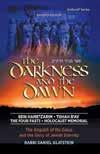
We are instructed to recall the Torah specifically at this time of the year, during this month, because of the sheviras haLuchos, the breaking of the Tablets, that transpired in this month and which precipitated the forgetting of the Torah. As the anniversary of this tragic event approaches, we are cautioned to remember the Torah, to work on ensuring that the Torah we learn is engrained in our memories.
Rav Nachman then addresses why the month of Tammuz would be spelled chaseir, without the vav that would typically be present.
The dimension of the Luchos, the Tablets that Moshe Rabbeinu broke, were six tefachim cubed. The vav, which in gematria is six, was removed from the name Tammuz

There are 528 hours corresponding to the 528 perakim of the Mishnah, which are the key to bringing the Geulah.
as a symbolic gesture memorializing the fact that the Luchos, with their dimensions, which were vav-by-vav, were broken.
Rav Nachman then points out another acronym that Tammuz spells out: Zman Matan Toraseinu. This allusion seems misplaced, however, since the Torah was actually given to Klal Yisrael in the month of Sivan, not in Tammuz.
Rav Nachman explains that while the Torah was gifted to us on Shavuos, in the month of Sivan, the actual Luchos were not physically brought down by Moshe to be given to Klal Yisrael until the seventeenth of Tammuz. Hence, the actual giving of the physical Torah took place in Tammuz.
When the patience of the Bnei Yisrael ran thin as they were awaiting Moshe’s return, they approached Aharon and asked him to manufacture a new deity for them to worship, since they had given up on Moshe ever returning. Aharon instructed them to bring him their wives’ jewelry. After the men had collected their own jewelry, the Eigel was created. Aharon then told the people to return the following day, for he was designating it as a holiday, as the pasuk states, “Aharon saw and built an altar before him. Aharon called out and said, ‘A festival for Hashem tomorrow!’” (Shemos 32:5).
The Chida expresses amazement at Aharon’s statement that the next day would be a holiday. They were worshiping a golden calf, violating one of the most stringent
aveiros in the Torah, and he calls for it a holiday? The Chida explains that we find the word machar, tomorrow, used to refer to a far-off date in the future, not literally the very next day. As an example, the Torah says, “If your child asks you tomorrow ” (Devarim 6:20). This pasuk refers to a future generation in which a child will ask his parent about the Exodus from Mitzrayim. Machar, therefore, is not limited to the very next day, and in fact, Aharon was not referring to the next day; rather, he was referring to the distant future, when at long last that date, Shivah Asar B’Tammuz, will be a holiday. When Moshiach comes and we are redeemed from this long and bitter exile, the seventeenth of Tammuz will no longer be a day of mourning — it will transform into a day of celebration.
“ Thus said Hashem, Master of Legions: The fast of the fourth [month], the fast of the fifth, the fast of the seventh, and the fast of the tenth will be to the House of Yehudah for joy and gladness and for happy festivals. [Only] love truth and peace!” (Zechariah 8:19). Thus, l’asid lavo, Shivah Asar B’Tammuz, Tishah B’Av, Tzom Gedaliah, and Asarah B’Teves will all become days of celebration.
Standing in front of Klal Yisrael on the eve of Shivah Asar B’Tammuz, Aharon HaKohen was looking forward to the day when this metamorphosis will finally take place. He understood that the very next day would be tragic, as Klal Yisrael would worship the Eigel. But in the distant future, when we will finally merit the Geulah, it will be a chag, a festival.
The vehicle through which it will become a chag will be our utilization of the 528 hours to commit ourselves to the study of Torah Sheb’al Peh. These hours will become the maftei’ach haGeulah, the key to the Redemption. We will be able to rectify the first step of the downward spiral — nishtabru haLuchos and the resultant shikchas haTorah, the forgetting of one’s Torah learning.
The haftorah that always precedes the Bein HaMetzarim is the haftorah of Parshas Balak This haftorah contains the prophecy of the Navi Michah. The prophet states, “ The remnant of Yaakov will be in the midst of many peoples like dew from Hashem, like raindrops upon grass, which is not hoped for from man and not awaited from a human being” (Michah 5:6). The she’eiris Yaakov, the remnant of Yaakov, refers to the Jewish people, the small remnant who has survived the trials and tribulations of Jewish history. B’kerev amim rabim, we will be among the mighty nations. K’tal mei’eis Hashem, k’rivivim, like the dew that falls from Hashem, like the rain. This means that Hashem will send His heavenly rain; ein mayim ela Torah, there is no water other than the Torah. Hashem will send a great influence of Torah upon Shivah Asar B’Tammuz – eisev – and transform it into an eternal day of celebration.
May we all be zocheh to the fruition of the pesukim, “Tzom ha’re’viei v’tzom ha’chamishi v’tzom ha’shevii v’tzom ha’asiri yehiyeh l’beis Yehuda l’sasson u’l’simcha u’l’moadim tovim v’ha’emes v’ha’shalom ahavu,” and may we be zocheh to see the fulfillment of the prophecy of Aharon HaKohen, “chag l’Hashem machar.”

By Barbara Deutsch
It’s Erev Shabbat in Israel, and I am sitting in my front garden listening to the chirping birds, drinking coffee that I brewed from my new Nespresso machine. I joined a WhatsApp group called Natan’s that alerts serious coffee drinkers, black and no sugar, to Natan’s hours – he has the best coffee in our shechuna, and there are long lines of eager consumers.
Now that we are olim, I am determined to brew my own. “Mom, you live here now; you can’t be going out every day,” admonishes my Israeli daughter, Rachel.
From the moment we pulled up in our “Ralph the Driver” giant van to Newark Airport with our nine duffel bags, two pieces of hand luggage and two wheelies, the tears started rolling. We were warmly greeted at the entrance by a full complement of Nefesh B’Nefesh staff who organized our luggage and took down our important details. Everyone got a name tag and a blue NBN identifier for their bags. Standing with us were families, couples and singles all following their dreams.
Many of us exchanged contact information, and we hope to see each other on our post-aliyah Zoom on Sunday. NBN has a whole new team for that.
I couldn’t stop crying; I’m crying as I write this.
We checked in; they counted but did not weigh the bags. Four hundred dollars later – for three of the nine bags – we were ready and waiting to board the plane home. Even though we lived close to JFK Airport and always preferred that point of departure, our group left from Newark, which it turns out is more user-friendly and navigable.
There is a popular old New Yorker Magazine cover that depicts the mindset of a New Yorker. It is a picture of the East Coast, just New York City, and the West Coast, simply the Pacific Ocean. There is nothing in between. When we met our fellow Olim, I was somehow surprised that there were people from Baltimore, Chicago, Arizona and California. There were also a handful from towns in New Jersey.
There is a whole world of people out there waiting to make aliyah; we are not alone.
After the pleasant flight, the El Al stewardesses cried as we departed the plane, “We are so moved by your bravery to make this big change during a time of war; thank you,” they said.
Ironically, while clustered with our group waiting, I spotted a former student on the NBN greet staff. “Hi Mrs. Deutsch, mazal tov,” she said. My old life welcomes the new.
We were taken to Terminal 1, the old charter plane terminal, for processing. We learned there are no longer NBN charter flights as they are too expensive these days and at most there are group ones; ours had 62 people from age 79 to a new baby.
The whole new NBN Greet Staff along with two Israeli government officials took us through the bureaucracy of what it means to be a “real” Israeli; we got our identity card and our health care, Kupa –the two most important numbers that we will need for life in our new home.
Waiting for all of the paperwork to come through took about four hours and though exhausted, especially the kids asleep standing up, everyone was patient with a minimal amount of crying; everyone had waited a long time to find home and we were able to hold on for just a few minutes longer. Even the babies and small children understood that.
After our group was processed, we went back to Terminal 3 (the usual point of arrival and departure) to pick up our luggage and meet the waiting cabs that would take us to our destinations in Israel. My New York mindset could not understand why everyone was not going to Jerusalem.
Walking through the doors and into the arms of those singing and dancing as they anticipated our arrival and greeted our tired bodies but energized souls got the tears rolling again. Seeing our kids, grandkids, Chaya (a dear friend’s baby who is like family), a former student’s daughter who is the granddaughter of my beloved colleague Abie Wahrhaftig, a”h,
and Rachel, a former teacher colleague who has recently made aliyah, brought back memories, joy and more tears.
All my worlds colliding to bring me and Bob home; our life’s dream realized.
Since landing, we have been involved in the mundane and the boring of unpacking – which is so much more arduous than the packing – figuring out how the not enough space will expand like Noach’s Teva, the setting up of an Israeli phone number, finding that a lot of what we gave away is still needed and what we have kept may not be, and sleeping.
We have also fielded many offers of help, invitations for meals and a Shabbos invite from a childhood close friend for August 10. His busy retired life has no openings before then.
Our first official night we had a delicious dinner with our close “friend who is like family” beloved friend Anne. She, because of life’s complicated circumstances and similar to so many of our close friends, mostly lives here. When she and good friends like her are around, we will make time to be together.
The celebratory drinks were delicious. L’chaim!
We are not jetlagged, but we are exhausted.
We already miss the loved ones we left behind. They keep texting and checking in to see if we are managing and surviving. Thank you!
“Are you okay?” “You are so brave.” “We wish we could do it!” Over and over again, we hear these questions and comments.
We are okay. There is nothing brave about this, and if you really have a dream of making aliyah, do it. There will never be a “right” time if you let life and its roadblocks get in your way. We waited 50 years as we kept our eyes on the prize and waited for the opportunity to fulfill our dream.
Those 50 years were filled with building a wonderful family, in Israel, in America and Toronto. We will visit and so will they. We have both enjoyed satisfying years as educators, and we will find ways

to share our skills and knowledge in Israel. We will stay in touch with colleagues and students. Bob just got an email from an old student asking to connect and talk about his future.
We are open to all ideas. We are also available to help and support those who share our dream.
I still have to figure out how to handle living without a set schedule, getting dressed “fancy” every day, and what to do come September without a “real” job. Right now, it’s just a regular summer and my usual vacation.
Just as we have always enjoyed a large group of friends who are like family and friends who enhance our lives, we will not let go of the opportunity to have good times with them, to reconnect with friends here, and make new ones with common interests.
Best of all, we get to be a daily part of our children’s, grandchildren’s and future family’s lives.
We have a lot to figure out and learn. So far, it’s not been that hard but certainly it’s not easy. We did not walk away from what we have built and loved; we are walking towards what we think is the right place for Jews everywhere, not just New York.
Next week has a full calendar of “to dos” and dinner with friends old and new.
I’ll keep you posted.
Mrs. Barbara Deutsch is currently the associate principal at HANC 609 and a longtime reflective educator, parent, grandparent, and new great-grandparent. Even after all these years, she still loves what she does and looks forward to working with kids every single day.
By ShloIme SchwA rTz
This past Motzei Shabbos, those turning on their phones and radios after Havdala confronted a dramatic story, the likes of which had not been seen in America for over forty years.
Former President Donald Trump, the presumptive Republican nominee for president, had faced an assassination attempt during a rally in the small town of Butler, Pennsylvania. The videos and images were shocking: Trump, mid-speech, grabbing at his ear and then sinking down to the stage, as shots rang out. It was clear very soon after the attempt that Trump had escaped without serious injury, but in the days that followed, preliminary investigations would prove just how close he had come to death.
In the aftermath, there were many burning questions: Who was Thomas Matthew Crooks, the 20-year-old shooter, and why did he try to kill Trump? How could a young man, with no military or significant firearms experience, evade the Secret Service and successfully get himself into a sniper’s position so close to the stage? How would this attempted assassination, a mere few days before the Republican National Convention, affect the ongoing presidential campaign?
For those old enough to remember, this moment and the uncertain atmosphere left in its wake, summoned dark memories of the turbulent ‘60s, where the assassinations of important and charismatic leaders became an almost commonplace feature of American life. However, political violence has been a part of our country’s history for far longer, stretching back through the centuries to the earliest years of the republic.
The first major assassination attempt was against President Andrew Jackson in 1835, less than sixty years after the country was founded. After that, there were two major eras of assassinations. The first began with Lincoln’s murder
in 1865 and ended with the attempt against Teddy Roosevelt in 1912, a 47-year era during which three sitting presidents were murdered and attempts were made against a leading presidential candidate. After several decades of relative calm, with a few unsuccessful attempts against various presidents, a second era began, stoking the flames of unrest that consumed the world in the second half of the 20th century.

Donald Trump, urging supporters to “fight,” moments after a gunman tried to kill him
current president, the effects of this attempt against Trump remain to be seen. However, it has fascinating parallels and connections to these incidents in the past. America is a grand modern experiment in self-governance and democracy, one whose results are still being discovered, but the more ancient art of violence still carries a sinister potency to alter the course of history.
President John F. Kennedy’s murder in Dallas in 1963 ushered in a new wave of political violence, taking the lives of some of the generation’s most influential leaders, including JFK’s younger brother Robert in 1968, while he was in a tight race to become the Democratic candidate for President.
Alabama Governor George Wallace was shot and paralyzed in 1972, and Gerald Ford faced two separate attempts against his life a mere 17 days apart in September of 1975. In 1978, California Congressman Leo Ryan was murdered while investigating the infamous cult at Jonestown, and finally in 1981, President Reagan was shot in the chest, suffering injuries that almost killed him. Each of the above incidents left an indelible mark on American history. Obviously, the actual murder of a president creates a greater impact than a failed attempt; still, the ripple effects of any violence send significant shockwaves through the world of politics. In an already chaotic and fraught political atmosphere, with massive divisions in the Democrat Party and serious questions swirling about the mental and physical capacity of the
In the hours and days following the assassination attempt, very little information was released about the attacker, Thomas Matthew Crooks. He was twenty years old and from Bedford Park, a suburb of Pittsburgh. As of the time of this writing, his political affiliations, ideology, and specific motivations for shooting Trump remain unclear. He was a registered Republican but had also made a small donation to a liberal organization in 2022. His friends did not say much about him, other than that he was bullied in high school and that he failed to make the school’s shooting team because of his lack of proficiency with firearms. Beyond that, not much is known.
Even with the paucity of information available about Crooks, it is clear that he fits into a pattern with most other American political assassins, most of whom have acted alone for their own reasons. One notable exception to this was John Wilkes Booth, who collaborated with four other
Confederate sympathizers to eliminate the three most powerful members of the Union government. Historically, these disgruntled loners strike out because of ideology, a desire to be part of history, mental illness, or some combination of the above.

Richard Lawrence, the first would-be presidential assassin in U.S. history, who tried to kill Andrew Jackson, was known to be mentally unstable, suffering from delusions, and talking to himself in the streets. His delusions of grandeur were on full display during his trial, when he told the court, “It is for me, gentlemen, to pass judgment on you, and not you upon me.” He was found not guilty by reason of insanity and was institutionalized for the rest of his life.
Charles Guiteau, who assassinated James A. Garfield in 1881, was an unstable individual, who had been kicked out of a cult in upstate New York and whose behavior was so alarming that close family members thought he was “possessed by Satan.” Guiteau was nominally a Republican, but ultimately ended up assassinating Garfield, a Republican president, because he felt that Garfield hadn’t appreciated his support.
Leon Czolgosz, who killed President McKinley in 1901, was much more motivated by politics. Although he was rebuffed from joining any of their groups due to suspicion that he was a spy, Czolgosz became caught up in the anarchist-socialist thinking of his time. Under the anarchist influence, he decided that McKinley deserved to die because the President was an enemy of the working man. Despite his lawyer’s best attempts to have him declared insane, Czolgosz remained adamant in his guilt and never wavered from his stated motivation, ultimately dying by execution in the electric chair.
As with everything relating to JFK’s assassination, the motivations of Lee Harvey Oswald remain unclear, shrouded by six decades worth of conjecture and conspiracy. In the brief time before he was shot by Jack Ruby, Oswald claimed to be innocent, but what is certain is that Oswald professed an interest in communism and had defected to the Soviet Union in 1959. Whether or not this ideological affiliation was what drove him to shoot Kennedy will never be known.
Later assassinations became much less about politics and much more about insanity and a desire for celebrity. Squeaky Fromme, an LSD-addled member of the Manson Family whose gun
jammed after attempting to shoot Gerald Ford, claimed she had merely wanted to discuss the preservation of California redwood trees with the President. During her trial, she hurled an apple at the prosecuting attorney and protested the trial as “a lack of respect for creatures and creation.”
John Hinckley, who shot President Reagan in 1981,
had no stated political motivations; instead, he was hoping to impress a Hollywood actress he was infatuated with.
Trump has long had a reputation for pugnacity and toughness, but this moment showed another side to his character: a bravery and warriorlike resolve that even his staunchest critics would find difficult to deny.
These lurid tales only serve to underline the role of the President in the national psyche. Besides for his enormous political power, he is also seen as a cultural nexus, the center of the world’s attention, leading to him being targeted both by those who seek to change the world or those who, in their own twisted way, yearn to step into the spotlight.
s trength and s y M pathy
As soon as it was clear that Trump had not been seriously injured, there was immediate discussion of how this attempt would affect the race. In the weeks leading up to the shooting, the main issue had been Biden’s frozen, mumbling and brain-fogged performance at the first presidential debate. Until that point, Biden’s cognitive decline
had been dismissed by the media as a right-wing talking point, but afterward, his fitness for the office became the central issue of the campaign. Although conservatives had been making the claim for years that President Biden was at best feeble and at worst fully senile, now there were many Democrats calling for Biden to step aside.
With the question of strength, energy and stamina playing such a major role in the election, it would seem that this assassination attempt will be an incredible boon for Trump. The images of him standing bloodied but unbowed under an American flag, pumping his fist and shouting “fight,” will be emblazoned on the American consciousness for generations to come. Trump has long had a reputation for pugnacity and toughness, but this moment showed another side to his character: a bravery and warrior-like resolve that even his staunchest critics would find difficult to deny. His contrast with Biden, already stark, will grow even greater.
Another effect that this might have will be changing people’s feelings towards Trump, something previously thought impossible. Trump is a notoriously polarizing figure, inspiring intense dedication from his supporters and equally intense hate from his detractors. After eight years, three presidential campaigns and never-ending media coverage, it’s hard to conceive of anyone not having their mind made up about Trump.
However, seeing a politician face violence humanizes them in the eyes of the populace and can make a big impact on their public perception. Ronald Reagan, who was also seen by many opponents as a right-wing extremist, gained something immeasurable after he was shot. As historian Del Wilber writes, “The shooting generated massive sympathy from the American public for Reagan, who spent 13 days in the hospital before returning to the White House. But it did something else – it built a bond between the president and the public. They had seen a president who acted with grace and courage. They would hear that he had cracked jokes with his doctors and nurses as they fought to save his life and sought to ease the anxiety of loved ones…. He was politically untouchable from that point on…. He became a mythic figure.”
secret service Fai Lures
With any assassination attempt,

successful or failed, there are always pressing questions about security and prevention. After the shooting last week, the country was shocked by the seeming incompetence and security lapses that allowed Crooks to fire at Trump, and those questions have still not been satisfactorily answered. This is another episode in the strange saga of presidential security, which has long been an oddly neglected area in American life.

A
Until President McKinley’s assassination in 1901, there was no formal government body designated to protect political leaders. The Secret Service had been founded by President Lincoln in 1865 but only as an entity meant to combat counterfeit currency. There were no highly trained federal agents protecting Lincoln the night he was shot in Ford’s Theater. His only protection was an unreliable Washington, D.C., police officer named John Parker, a man with a drinking problem who had once been found sleeping on a streetcar and claimed that he had been in there investigating “suspicious duck noises.”
The buffoonish Parker can be seen to represent the absurd and lackadaisical nature of presidential security. Until 1901, most presidents could walk around freely, with very few limitations or protocols meant to keep them secure. Even after the Secret Service was charged with the duty of protecting the president, there were still numerous glaring errors in their conduct. The Warren Commission that investigated the JFK shooting found that not enough agents were sent to protect the President and that many of the assigned agents neglected their responsibilities by staying up late drinking, leaving them woefully unprepared to prevent the violence or react to it properly. The Secret Service was praised for their quick response to Hinckley’s shooting, neutralizing the shooter and getting Reagan into the limo immediately. However, their failure to screen people on the sidewalk outside the hotel, and allowing them to get so close, was what led to the shooting in the first place.
It is clear that the Secret Service has an incredibly demanding job, protecting many current and former leaders, along with their family mem-
bers. However, their resources, practices and oversight are often lacking, an unacceptable state of affairs for something as important as presidential security.
In Zero Fall , a 2021 book about the agency, author Carol Leonnig warned that the current state of the Secret Service would lead to a disaster of the type that almost occurred last week, “[They have a] chronic, ridiculously large mission… Things were so bad in very recent years that agents were showing up to pick up a Cabinet member in their
Besides for his enormous political power, he is also seen as a cultural nexus, the center of the world’s attention, leading to him being targeted.
own personal car because the Secret Service’s fleet was too expensive to maintain… an intruder entered the White House grounds in 2017 and wandered around undetected for almost twenty minutes. The sensors, the cameras, the alarms [and] the radios didn’t work… This is supposed to be the most secure 18 acres in the world, and they just didn’t have the money to
fix those things… [the sources I spoke to] strongly believed that it was a matter of time before a president was shot on their watch… They’re worried that the agency increasingly is relying on luck. And it’s really a matter of time before somebody finds the right weakness and gets through.”
Wars are won or lost by the wholesale slaughter of thousands, not by the killing of a solitary man. However, assassinations of leaders often play a massive role in whether wars start, end, or continue. It can be legitimately argued that the astonishing tidal wave of conflict in the 20th century, including the Cold War and all its associated proxy conflicts, as well as World Wars I and II, can all be traced back to the bullets fired by Gavrilo Princip at Archduke Franz Ferdinand in 1914. That murder led the Austro-Hungarian Empire to declare war against Serbia, lighting the fuse on an explosive situation consisting of alliances, fervent nationalism and old grievances. Perhaps World War I would have occurred without Princip’s violent act; the nations involved had certainly been preparing for war for decades. Ultimately, however, it was his act that became that catalyst, pushing Europe over the brink and unleashing the unspeakable horror of The Great War.
From the end of the war in Vietnam until 9/11, armed conflict became less of an issue for American voters than it had been before. Although the War on Terror launched under President George W. Bush still continues in some form today, almost a quarter century later, it does not occupy the main focus of the public. Instead, it is America’s influence on the world stage, and the military aid it provides to allies, that has become a major topic of discussion. Europe trembles in the face of the ongoing vicious war between Russian and Ukraine, and Israel is battling Hamas while under constant threat of attack by its bloodthirsty neighbors. These two conflicts, along with aggressive behavior of countries like Iran, China, and North Korea, have made the threat of a worldwide armed conflict loom greater than it has in decades.

Beginning with his disastrous withdrawal of American troops from Afghanistan,
Biden’s bungled handling of domestic policy has been one of his weakest points. He has failed to defuse the conflict between Russia and Ukraine and has sent very mixed messages about the war against Hamas, alternating between full-fledged support and craven pandering to the radical pro-Hamas wing of his party. In contrast, Trump’s most effective campaign messages have emphasized the foreign policy successes of his first term and a promise to end the chaos unleashed by Biden’s weakness. As such, this election campaign will not only decide who gets to nominate Supreme Court justices or pass new healthcare laws. It may well decide whether the globe heads towards peace or all-out war. It seems shocking that one man with a gun would be able to have such a large impact on the course of world events, affecting the lives of millions and the fortunes of nations, but that is what we almost saw last week and what we have seen in the past. A war was the central motivation behind the first successful presidential assassination. John Wilkes Booth, a dedicated member of the Confederacy, was certainly out for revenge when he killed Lincoln. As a proud Southerner, Booth was furious at Lincoln as the leader who had slowly but surely pounded the South into submission, killing and injuring close to half a million of its soldiers and destroying its economic power. Booth killing Lincoln did not affect the outcome of the war, but it brought Andrew Johnson into the presidency, whose vision for postwar Reconstruction differed from Lincoln’s in significant ways. Ultimately, Johnson fell into conflict with his own party and was impeached, later being replaced at the top of the Republican ticket by Ulysses S. Grant. How Lincoln might have navigated this delicate period of rebuilding a nation shattered by war remains one of the most consequential “what-ifs?” in American history.
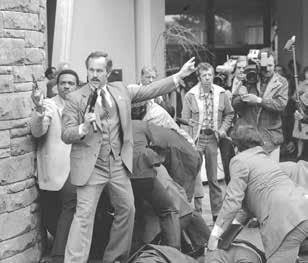
influence they both had on the course of this decades-long war was eliminated by the violent interference of deranged gunmen.
One of the most popular and persistent conspiracy theories surrounding JFK is that he was assassinated because he opposed the escalation of the war against Communist proxies in Vietnam. A cabal of shadowy and hawkish forces, including the dreaded military-industrial complex, were too invested in the war to allow JFK to remain in power. The theory goes that they were rabidly anti-Communist, as well as greedy for the money to be made from a prolonged conflict in Vietnam, and would not allow the “dove” JFK to scuttle their plans and removed him via an assassination conspiracy.
killing of JFK’s younger brother, Robert. Like Trump, RFK was a popular candidate running on the promise of ending unpopular wars. By 1968, the war in Vietnam had dragged on for years, with no end in sight. The draft and protests against the war were tearing apart the country, fueled by massive social and political changes.
The Civil War was echoed a century later by the war in Vietnam, another conflict which pitted the country against itself, albeit ideologically and not militarily. Vietnam is bookended by a pair of assassinations: John F. Kennedy in 1963 and his younger brother, Robert, in 1968. The potential
This theory has many holes in it; although JFK was more open to negotiation than some of his more conservative Republican counterparts, it does not seem likely that he would have backed away entirely from the Communist threat in Vietnam. The U.S. had been involved in Vietnam since the mid-‘50s, and JFK actually escalated the military presence during his presidency. He sent Green Berets and helicopters to fight in 1961 and backed a military coup in November of 1963, the same month he was assassinated. While there is documented evidence of JFK and his cabinet discussing the systematic withdrawal of all U.S. forces, the reality of the situation changed completely with the attack at the Gulf of Tonkin in 1964, and there is no real way to know what JFK’s reaction would have been, or if he even would have been president.
The attempt against Trump is far more reminiscent of the 1968
At the time of his assassination, Robert Kennedy was locked in a fierce battle with Vice President Hubert Humphrey to become the Democratic nominee for president. Much like today, the Democrat Party was divided into warring factions, and the surprise withdrawal of incumbent President Lyndon B. Johnson had only deepened the fractures within the party. Kennedy was the more “radical” candidate, who promised a focus on social justice and an avowed commitment to ending the war in Vietnam. Unlike with JFK, conjecture about RFK’s plans are far more clear-cut. Given the stalled nature of the war and its terrible cost to the country, it seems very likely that had he become president, RFK would have attempted to carry out his promise and end the war. Instead, the war dragged on, only ending five years later when President Nixon signed the Paris Peace accords. RFK’s legacy became, to paraphrase the eulogy given by his brother Ted, a figure remembered for dreaming of that which tragically never was and asking “why not?” He also left behind a stirring denouncement of violence, given in the aftermath of Martin Luther King Jr.’s assassination and eerily presaging his own, a speech worth rereading in the aftermath of the violent attack on Donald Trump:

“This is a time of shame and sorrow. It is not a day for politics. I have saved this one opportunity to speak briefly to you about this mindless menace of violence in America which again stains our land and every one of our lives…. What has violence ever accomplished? What has it ever created? No martyr’s cause has ever been stilled by his assassin’s bullet. No wrongs have ever been righted by riots and civil disorders. A sniper is only a coward, not a hero, and an uncontrolled, uncontrollable mob is only the voice of madness, not the voice of the people.”
Self-care is a wide-reaching topic, one which impacts a great many people. It impacts all of us, come to think of it. Though some of us are able to address it organically, without much thought, for most of us, it’s not that simple. Taking proper care of yourself takes some planning and introspection. Whether you’re one of those people from the majority who’ve been in my office and had this conversation or not, know that you’re not the only person who struggles with implementing the supposed panacea of mental health care known as self-care.
As with many mental health-centric terms (think narcissist, abuse, and depressed, to name a few), self-care is one which has been at least partially co-opted by popular culture. People sometimes ignore responsibilities and make objectively silly decisions in the name of catering to this concept. This is not to say, of course, that real, authentic self-care is a bad thing. Quite the oppo -
By Yeshaya Kraus, LCSW

site; it’s probably one of the most basic and important things you can practice. If long-term functioning as an effective member of society is on your agenda, doing this right has to be an integral part of your plan.
Let’s define what it is, why it’s important, and how it works.
We can use marriage as an analog. If someone wants to build and maintain a healthy relationship, it’s taken for granted that your spouse needs to feel like you have their back. He or she will need to both know and feel that in spite of whatever disagreements you have, differences of opinion, or relational drifts you may be experiencing, you are there. You and your caring are facts of life. The fact that you want the other to feel cared for is also a fact. Experiencing that knowledge on a visceral level helps you both get through the tough times, the times when you feel more distant. Knowing that you’re cared for, and more importantly, feeling it, is what
keeps you going. It makes the relationship feel safe, makes you feel safe enough to invest in it further, and makes the relationship an environment in which you can grow. Though there are some aspects of what you would like to see in marriage that you’re able to compromise on, there are other hardline boundaries that you just can’t. In good relationships, those are respected. In less than healthy relationships, they’re not, and there are repercussions for it. It shows up in how the person whose boundary isn’t being respected engages in the relationship.
I find it interesting that while there’s generally tremendous focus on the relationships we have with others, we often ignore the one we have with ourselves. In marriage, it’s understood; there needs to be effort put into making each other feel cared for, or helping each other internalize the idea that “you are a top priority to me.” We get that; it’s important if we want to make it work. For
our relationship we have with ourselves, not so much. There’s often an emphasis on “hustle” in Western culture, on running ourselves ragged and prioritizing everything else above ourselves. The popular perception of self-care, which often suggests that one should drop everything in order to provide for oneself, is a pendular response to that idea. Marriages need to be balanced, compassionate, and respectful in order to work. Our relationship with ourselves needs to be the same way. Here’s why. Imagine yourself as a large, complicated, and very delicate machine. It’s a system that makes you who you are and allows you to maintain your daily lifestyle. That includes your body, emotions, sense of spirituality, and anything else you can think of that you might have to push yourself to do. It expends energy in order to do the things it needs to do and needs to be maintained in order to work.
This is pretty simple when you’re, say,
a car. There’s only one type of fuel available, and there’s usually a clear indicator and a way to fill it up when it runs low. It’s low, you fill up, and it’s good.
What happens when your car is a bit more complicated? Maybe there’s some sort of mechanism that whenever you take the time to fill up the gas tank, the coolant level goes down. If that gets filled up, washer fluid decreases, and filling that up might deflate a tire slightly. The whole system is intertwined and interdependent. It’s real work to maintain enough of the important functionality the car needs in order to do what it’s supposed to do. It becomes an exercise in balance.
Bob doesn’t like going to work. He needs to, though, for obvious reasons. He’s got his mortgage, he’s making a wedding in a couple of months, and he also likes to be able to put food on the table. Among other things. Although going to work lowers his level of self-esteem, balance, and general happiness, he’s willing to do it for the opportunity to top off the sense of stability and security that having a decently stocked bank account gives him. It’s a trade-off. This can only go on for so long, though. After doing this for years and
getting increasingly grumpier and hopelessly unpleasant to be around as time goes on, he’s discovered that in order to maintain the balance that he needs to keep the “car” running, he needs to take a week off every couple of months. He doesn’t get paid (he works on commission. He doesn’t want to talk about that, and we’ll respect his wishes), but he’s topping off several other systems when he does it. It’s a conscious decision based on an awareness of a specific need.
Self-care doesn’t have to be sweeping gestures like Bob’s week off. It can be smaller gestures, which acknowledge needing to feel a certain way on some level. One person I know decided to make a conscious effort to sit down and eat, using a non-disposable plate. “I feel more grounded, and it makes me feel better about the experience. I feel more like a person. It doesn’t take much extra time, and for some reason, giving myself that experience changes the trajectory of the next couple of hours. So I do it.”
The ability to do this comes from noticing emotional needs and taking the time and effort to plan how to address them, even in a small way. It’s the ultimate in self-validation and compassion. You’re telling yourself, “I see you, and

I’ve got you. You’re important to me and I want to give you what you need, to whatever degree I can without sacrificing too much of other important things.”
It’s not just about allowing yourself to take a week off or using real cutlery, either. Noticing that you need to initiate a difficult but crucial conversation about something that’s bothering you is self-care. So is enforcing a boundary that you don’t want trampled on. It’s difficult, and may lower some of the tanks in your emotional car, but it needs to be done in order to keep the car running.
This is very different from the pop culture understanding of self-care. General society might have you believe that self-care is about adding activities, buying things, or going places. That might be true for some. Going to the spa, or meditating at the beach, staring at the waves, or treating yourself to ice cream could be pleasant. If it’s not serving a specific need, though, it’s not going to do the job you want it to do. What it will do, though, is ultimately deplete other areas in your life. You’ll end up having lower levels across the board, and not really gaining anything. It’s likely that it serves to distract from discomfort more than anything else. If that’s what you re -
ally need, that’s great. Go for it. It may not be the honest self-care you’re hoping for, though.
In a marriage, if your spouse says she’s bothered by the lack of connection, one would hope your reaction wouldn’t be to buy her mashed potatoes. That’s theoretically a good reaction to her saying that she’s hungry, but it won’t work if your response isn’t to the specific need. With a little patience, introspection, and self-awareness, we can learn to be aware of what we need as people, take care of ourselves properly, and help ourselves to be the most effective and balanced versions of ourselves possible.
Yeshaya Kraus, LCSW, is a therapist in private practice in Far Rockaway. He specializes in men’s mental health, parenting, relationships, and dating. He is also the creator of the Building Together workshop for engaged and newly married couples, and speaks publicly on a variety of topics, including dating and marriage. For inquiries or to register for the Building Together online workshop, email him at yykraus@ gmail.com or WhatsApp at 917-412-5824.


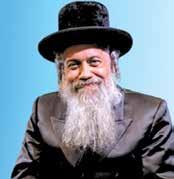
By Eliyahu RosEnBERg
abbi Avraham Goldstein’s widebrimmed black hat, long gray beard, and thick, chassidishe peyos certainly give him a Jewish appearance. But listen to him speak for just a moment, and you’ll soon realize that the ger tzedek ’s Yiddishkeit is, by no stretch of the imagination, surface deep. Behind Rabbi Goldstein’s tan skin and Yiddish-Spanish accent, there is
clearly a pure Jewish neshama shining through his warm smile.
Rabbi Goldstein’s journey began decades ago when he was a young boy growing up in Puerto Rico. Even before he developed an interest in converting to Judaism, he was in constant pursuit of meaning, of which he found little in his hometown.
“Across the street from my house,
There are different details: l itvish, Chassidish, sephardic; we talk about so many differences, but really, it’s not that different. We all have to keep Pesach, we all have to keep shabbos, we all have to do the same thing. a nd we make a big deal about differences, but really, they’re not that big. They’re just minor pronunciations, but the hashkafos really are the same. it’s only one Torah.
We’re all geirim one way or another. you know why? Because we have to make decisions every day. We have to become geirim every day, so to speak, because we have to do the mitzvos, we have to remember to daven with kavanah, we have to be sincere in avodas hashem. We have to choose the way of hashem every single day.
sometimes, we forget. sometimes, we are distracted. sometimes, there are many things that we need, but we always have to appreciate who we are as a people: the people who say na’aseh v’nishma.
there was a bar where people used to live out their day, every day. And for me, it was a clear vision of my community and the people around me,” Rabbi Goldstein recalled. “And it scared me, because I thought that that was going to be my future. And so, I started searching for more meaningful ways to live.”
As a young boy, his views of his community were cemented one day when a powerful earthquake hit Puerto Rico. It happened suddenly in the middle of the night when people across the street from his house were living it up; they had been blasting music, partying, and acting crazy and self-destructive – as if there would be no tomorrow. When the earth beneath their feet began to rumble and the house began to shake, the partygoers suddenly froze, the music coming to a halt. Shivering with fright at the realization that they had been hit by an earthquake, the partygoers became seized by the fear of death.
“When people are afraid, they become religious,” Rabbi Goldstein noted. “All of a sudden, all of these people became religious. And they went on their knees and they started to pray: ‘G-d, forgive me! I promise I’ll be good!’”
Observing the desperate and frightened partygoers, young Avraham had a glimmer of hope that these individuals would repent and live better lives, as they had promised; perhaps the community would be transformed in the process. But the young boy’s hopes were crushed the second the rumbling stopped. When the people realized that the earthquake had ended, they seemed to have immediately forgotten their
promises to G-d; they were no longer in the proverbial foxhole. The loud music went back on, and the partying continued for the rest of the night, as if nothing happened.
Since there was no meaning in his town, young Avraham, having grown up as an observant Christian, searched instead for purpose in the Bible. While the stories of the Bible intrigued the young boy, he questioned their relevance to him, as all the stories were about a nation he wasn’t even a part of: the Jewish people. The fourteen-year-old boy’s confusion about the Jews, however, ended up transforming into clarity after he told his mother that he wanted to live in a more meaningful world.
“My mother told me that she lived in Williamsburg in Brooklyn, New York, when she was a girl. She told me that the difference between her side of the neighborhood where she lived in Williamsburg and the Jewish neighborhood – it was day and night: the relationships between people, the morality, their decency,” he recounted. “And she told me, ‘I think that the type of life that you’re looking for, you’re only going to find it by the Jews. You’re not going to find it anywhere else.’”
The boy took his mother’s words to heart. Determined to find meaning, the young teenager went on to get a job as a paperboy, and once he saved up enough money, he booked a flight to New York. He had one goal in mind: to see the Jews. Young Avraham arrived in Brooklyn in the middle of the cruel December winter. He was almost fifteen years old – all on his own in a strange new land –
when he arrived in Williamsburg.
As he stood in the chassidish neighborhood, he was awestruck. Big-wheeled baby carriages were rolling about everywhere he looked, with children hanging on to the carriages from all sides. All the people, regardless of their age or status, wore the same elegant, aristocratic outfits. To the young Puerto Rican boy, it looked like the town’s people were royalty, as each individual wore beautiful hats, golden buttons, and velvet on their clothes. For the first time in Avraham’s life, he saw a child with glasses. It was, in his words, almost like he “parachuted on the moon.” It was a different planet. But what impressed the boy the most was the expressions that he saw on the faces of these people. It appeared to him as though each person wore a face of innocence, intelligence, and inner tranquility. In Williamsburg, he felt none of the negativity that he experienced in his hometown. He was surrounded by the people of the Torah, and he instinctively realized that it was in Judaism that he would find the truth and meaning that he had been desperately searching for.
Young Avraham quickly got a job making deliveries for a local grocery store, and he also found a place to sleep. It was while he was making one of his deliveries that he approached one of his Jewish coworkers to ask about Judaism. He figured he had nothing to lose.
So he went up to the Jew and said, “Excuse me, I’m trying to become Jewish. Maybe you can help me?” The person stared at him for a moment with wide eyes and a gaping mouth. The man looked at the young Puerto Rican teenager from top to bottom and, in shock, muttered, ”Meshugana!” And that was it. The Jewish man bolted.
Till this very day, Rabbi Avraham Goldstein laughs about the many misunderstandings he encountered during his journey to Judaism. For example, there was a time when

he asked some chassidish children what the Jews do at the “temple.” Although he was trying to ask about shul, the kids thought he was referring to the Beis Hamikdash, and so they went on to tell the Puerto Rican teenager all about how they bring in animals and how the ketores goes straight up to Hashem.
“And so I said, ‘I have to see this!’ So, I walked down Williamsburg, looking at every chimney, looking for straight smoke. Finally, I came to Bedford Avenue. There was a big building over there. I was there early in the morning, waiting for the animals to be brought in for sacrifices,” Rabbi Goldstein recounted.
“Finally, someone asked me, ‘Excuse me, what are you looking for?’ And I said, ‘When are you going to bring the animals in?’ And he thought I was calling the Jews animals. And so he started screaming, ‘Antisemite! Antisemite! Why are you making fun of me?!’ And so I ran for my life.”
But through all the misunderstandings, the teenage boy never wavered in his desire to become a Jew. And eventually, after the boy was immersed in Williamsburg for quite some time, a prominent rav named Rabbi Goldstein (whose last name Avraham would later take as his own) recognized that the young teenager had a sincere yearning to join the Jewish nation. The rabbi thus met with the boy to have a conversation about conversion. After Avraham told the Rav that he wanted to become a Jew, the rabbi immediately tried to dissuade the boy.
“You don’t have to be a Jew,” the rabbi told the boy. “You can be a friend of the Jewish people. It’s so difficult, you’re young, you may change your mind.”
The rabbi then put a chair between him and the fifteen-year-old.
“We have a commandment in the Bible: do not place a stumbling block before a blind person. You are young. Maybe by you becoming a Jew, things will be more difficult for you,” the rabbi added.
But the boy was determined and brushed off the warnings.
“No. Even if I have to stand on my head – I already know how Yiddishkeit looks – I want to become a Yid,” the boy responded.
The rabbi offered one last warning: “It’s a one-way ticket. Once you become Jewish, you can’t become non-Jewish. You have to be serious about this.” The boy said that he understood.
And so, little by little, the rabbi taught the boy all about brachos and hilchos Shabbos and the like. A yearand-a-half later, the Rav brought young Avraham to a prominent dayan in Boro Park by the name of Rav Moshe Bick for an interview. Once the meeting began, Rav Bick tried to dissuade the boy once more from becoming Jewish, but the teenager stood his ground and insisted that he wanted to convert.
After speaking with the boy for two hours, Rav Bick said, “I see that you mean it. I see that you’re serious. But there’s three things that you have to keep in mind. Number one: it’s going to be very difficult for you to get married. Number two: according to our laws, we’re not allowed to make you feel uncomfortable; we have to welcome you, we have to be nice to you, but sometimes it’s possible that somebody may make you feel uncomfortable, because Jews and Judaism should mean the same thing, but sometimes they don’t. And I don’t want you to become disappointed if you see somebody making a comment or doing something that they’re not supposed to do. And number three: to be a Jew is a mentality. You have to develop our way of thinking. We have thousands of years of experience. We have our politics, when to laugh, when not to laugh, our sarcasm, our comments. So you have to get used to all this to be part of our people.”
The young boy responded that he understood and that he had faith that
Hashem would help him get married. Rabbi Bick then closed his eyes and thought for a moment, and then looked at the boy and said, “OK. We’re going to accept you.”
A week-and-a-half later, the boy, still absolutely determined to become a Jew, endured the pain of having a bris milah, after which his mentor, the elder Rabbi Goldstein, told him the following: “We’re going to give you the name Avraham, after Avraham Avinu, and you’re going to have my last name, Goldstein, because from now on, you’re going to be my son.”
Till this very day, no one has ever intentionally gone up to Rabbi Avraham Goldstein to make him feel uncomfortable. And while it took years to acquire, Rabbi Goldstein, through immersion in Judaism, eventually developed a true Jewish mentality.
Avraham Goldstein went on to become a rabbi, a Puppa chassid, and the Rebbe of a community of geirim in Scranton, Pennsylvania, where he inspires both Jews and non-Jews alike. He would soon go on to get married after meeting his wife, who was from Mexico. His non-Jewish mother, in fact, traveled to New York to attend her son’s wedding and was so happy that her son found meaning among the most incredible people in the world. Today, Rabbi Avraham Goldstein, baruch Hashem, has seven children and sixteen grandchildren, a large, happy family.
“We’re all geirim one way or another,” he says. “You know why? Because we have to make decisions every day. We have to become geirim every day, so to speak, because we have to do the mitzvos, we have to remember to daven with kavanah, we have to be sincere in avodas Hashem. We have to choose the way of Hashem every single day.”
Moderated by Jennifer Mann, LCSW of The Navidaters

I am dating a great guy (I’ll call him Avi), and things have been going well for the past month and a half. Recently, Avi was at an Airbnb with his family, and I was on the phone with him while he was leaving. I heard his mom telling him to do something in the background and he sounded rushed like he was in a hurry and I asked what he was doing. He told me that when his family stays at hotels or Airbnbs, his parents tell all the kids to gather up unused amenities – things like small shampoo bottles, hot cups, mini creamers, sugar packets, etc.
Behaviors like this completely go against what I stand for. Not only is something like that a pet peeve, but I find it to be considered stealing and a very low thing to do. I can no longer look at his family the same way. I even have been thinking that despite all the good I see in Avi it could be that our upbringing is too different.
Is this something I should bring up in conversation with him? Or is this something that just makes a statement that we just have very different value systems?
Rebbetzin Faigie Horowitz, M.S.
The point of dating is to learn about one another, both similarities and differences, and to see if connection develops. Why would you not discuss values with him? Why would you just write him off because this is something that bothers you? Isn’t communicating with a dating partner a way to discover depth and get to know the person’s strengths, weaknesses, conflict management style, and middos?
What if Avi’s family feels that this is part of what you pay for? What if they discussed this with a rav? What if Avi feels it’s cheap to behave this way even if it may be halachically and legally OK?
There are many parts to a person’s and a family’s value system; writing off a person and a family because of this “indicator” may say something about you. Don’t sit in judgment on a family without exploring the issue with Avi and with others. Learn to listen even as you disagree. Make sure that you learn to differentiate between class, decency, and halacha, even if you say goodbye to Avi. Learn skills and about yourself from this experience.
Michelle Mond
Every human being on this earth grows up with a set of standards, personal thoughts and opinions based on the environment they grew up in. This applies to big things such as hashkafos and child raising and small things such as taking extra sugar packets from hotels. Even two people within the same home will process their upbringing differently. Some children born into a large and rowdy, low-class household will vow to grow up and become successful so they can give their own kids things they themselves never had. Others will say they had the perfect childhood and want to give their kids the same as they had.
There are two points I am making here: one is for you to acknowledge that any guy you end up with will have differences about his upbringing that go against the way you were raised. The other reason I mention this is to clarify that just because he was brought up this way does not necessarily mean he enjoys it and wants his home to be the same way. One of the reasons that making a shidduch is compared to the sea being split is this same concept. Just as it
The Navidaters
Dating and Relationship Coaches and Therapists
Thank you for writing! To be completely upfront, I don’t have the answer to your last question. We all know people who almost seem to get a high from tiny bottles of lotion or free “anything”! And I can understand how someone’s excitement or intensity about free things or even taking things that don’t explicitly belong to them can
goes against nature for a body of water to split into two, so too it goes against nature for two people brought up in two different worlds to agree to marry and merge lives.
I cannot tell you what to or not to be bothered by, but what I can say is you need to shift perspectives and talk to Avi. Even if your opinions differ about taking home mini shampoo bottles, you still might be bashert.
Dr. Jeffrey Galler
Wait!
When I go to a hotel, I have always automatically assumed that all these amenities were always brand new. It never occurred to me that they might have been leftover by the previous occupant. I certainly do not want to touch shampoo bottles, hot cups, or sugar packets, even unused ones, that were touched by any previous guests!
My initial reaction to your letter was, “Aren’t leftover amenities thrown out when a guest checks out, and isn’t the cost of these amenities built into the price of the room rental?”
Personally, I don’t bother taking these disposables home with me, not for ethical reasons, but simply because I’d rather not stuff my suitcase with junk, especially stuff like shampoo bottles that can leak all over my clothes.
But I did some research for our readers. According to the general manager at
Learn to listen even as you disagree.
Claridge House Chicago, “These items are complimentary gifts meant for guests to enjoy, even if they are unopened.” Some hotels see it as a form of advertising, since these items often bear the hotel’s name.
Interestingly, I actually found a very specific, fairly definitive, online article from the Reader’s Digest that lists, “Things You Can and Cannot Take from Your Hotel Room.”
According to that article, among the items that hotels expect guests to take are: shampoos, soaps, conditioners, tea, coffee, paper, and pens. And, from highend hotels that provide fancier amenities: dry-cleaning bags, shoe-shine kits, travel-size sewing kits, toothbrushes, cotton swabs, and nail files.
By contrast, items that are NOT OK to take are: sheets, pillowcases, towels, robes, batteries from TV remotes, drinking glasses, non-disposable plates, utensils, and mugs, and decorative items like vases, artwork, figurines, and artificial flowers. Now, granted that perhaps Airbnb rentals are different than hotel rooms. And, granted that everyone may have different opinions about what is, and what is not, OK to take, but ask yourselves: Is it halachically permissible to argue with what is written in the Reader’s Digest?!
leave a gal (or guy) feeling some - what unattracted, as if this behavior is undignified or lacking some class. It’s one thing when it’s a friend doing it but what role would this play in a marriage?
I will, however, give you my opinion with regard to your first question. If you
and Avi have a relationship that you value and you are considering moving forward with him, I strongly suggest you bring it up. Even if you do not want to move forward with him, I think honesty is kind. Bring up the concern in a very non-threatening way that is full of “I statements.”
“I feel uncomfortable bringing this up. In the name of honesty and communication, I need to let you know that when I
overheard your family taking things from the room it made me a bit uncomfortable and here’s why. I grew up in a family that…. For me, I feel strange taking things…. How do you feel about what I’m saying?”
He may surprise you. It may not be that big of a deal. One step at a time. You’ve got this!
Sincerely, Jennifer
“Ihave no idea. He just yells for no reason.”
“She does this all the time, and it makes no sense.”
Watching children, it appears as if much of their behavior is illogical. They yell shamelessly, purposely get into trouble, or color all over themselves. No normal adult person would ever do any of these things. To parents, it can be quite confusing.
It’s also challenging to predict an unpredictable person. It’s hard to go for a special outing if they may randomly tantrum. A child cannot enjoy a meal in a basic restaurant or simcha if they spontaneously throw ketchup.
It’s quite difficult to parent a child when you can’t figure out why they are doing any given behavior. Do you give a consequence, or do you ignore it? Do they need more attention or less? Knowing how to answer these questions is important in choosing the appropriate response.
The Basic Principle
For those that enjoy watching or
By Sara Rayvych, MSEd

reading about crime dramas, you know that an important step towards solving a crime is finding the motive. Who inherits in their place? Who was angry at them? With the recent increase in hate crimes (may Hashem watch over us), determining a motive is crucial to accurately prosecute a hate crime or religious discrimination suit.
Despite initial appearances, children usually have a reason for their actions. They have a motive and something that compels them to behave in a given way.
Accepting this principle gives us an opportunity to put ourselves in their place and better understand why they are doing something. We can then use that knowledge to parent more accurately.
There are a few important points we need to remember. Their motive may not be logical to an adult mind, nor may it be the best method, but it still feels logical to that child. I’ve seen children insist on doing things their own way, certain they have the best method, yet everything still falls apart. Their brains are less developed, and they don’t think the same way we do. This different cognitive un-
derstanding is frustrating to work with but makes kids so innocent and fun.
Shame is a more mature emotion that develops as children grow. Young children will not feel embarrassed doing something that would mortify an adult. Toddlers may start to feel self-conscious if someone makes comments about them or laughs at them but will still not hesitate to loudly tantrum on the floor.
There are an unlimited number of reasons why a child may do something. Usually, the child benefits, even if it’s not the adult’s intention. For example, a child may purposely hit another child knowing they will be punished, but they still do it because they want the attention. For a child, negative attention (i.e., punishment) is still better than no attention.
Wanting attention is a major childhood need. Children will go to great lengths to be noticed. They will clean their rooms hoping for praise or smack the baby to get yelled at. The second example sounds illogical, but it’s surprising how many adults will ignore a
well-behaved youngster and only interact with their child to punish them.
Ideally, parents should provide their child with healthy doses of love, attention and praise. This should be administered routinely – both when children are caught “being good” but also just so a child feels loved. It’s not spoiling a child to greet them warmly or play a game with them after camp. A big smile or warm hug speaks loudly. Positive attention should be considered normal emotional maintenance.
A child may scream and tantrum for hours if they know the parent will eventually crumble and give them what they want. It’s upsetting to hear a child scream, and it’s embarrassing when it happens in public. Giving into their demands to get them quiet appears to be the easiest route. Unfortunately, the child has now learned how effective this loud technique is, and they’ll be sure to do it again.
Many children get what they want through negative means. Often, parents will provide a child with anything to get them to stop whatever it is they’re doing.
There are even cases of teens using their frumkeit as a means to manipulate their parents.
One article is insufficient to properly cover this topic, but we can still discuss some practical points that come from understanding a child’s motives.
Determining their motive clues you into some of their emotions. They may feel a lack of attention and use any means to obtain that coveted love. Perhaps they’re jealous of a sibling. Maybe they’re feeling insecure and pushing someone else down to feel falsely elevated.
Anticipate an unmet need. It’s better to provide a child with attention and not make them force it out of their parents. It’s preferable to feed a hungry child or give them a nap before they melt down. In this situation, a “need” is something that fulfills a basic emotional or physical need. Needs also include clean clothes for school or camp, toiletries and peer socializing. It does not include the latest iPhone, brand name shoes, or flights to exotic locations.
Teach a child an acceptable way to
get what they want. It’s helpful to provide them with the appropriate wording.
“Mommy, I want to wear those socks today (not these).” “Can I please have a drink?” “Please read this to me.”
We don’t want to inadvertently reinforce negative behaviors. It’s tempting to say, “Here, just take it, but stop screaming.” Unfortunately, that will
ative means children may use to obtain what they desire, motivation is important and a positive emotion. Children study to get good grades. They work hard at their summer job to earn money. They daven nicely to get the prize (eventually they daven to connect to Hashem). They act responsibly to get more privileges. Adults, too, are motivated to
Positive attention should be considered normal emotional maintenance.
only teach them that tantruming is an effective tool. When one child hits another, we tend to focus on rebuking the perpetrator, yet ignoring the injured party. If a child is hitting for attention, this only reinforces hitting as an effective means to obtain attention.
While we mostly discussed the neg-

accomplish and push themselves further to gain a greater goal.
Motivation can also be an important parenting tool. We often quote Morah Sarah, a veteran kindergarten teacher. She would often say, “Every child has their price.” Every child has what motivates them and gives them that internal push to do what needs to be done. Star charts and other positive reinforcement
methods often rely on this part of human nature. Most children can be encouraged to do something that is challenging or necessary in exchange for “their price.” Work with a therapist to earn Playmobil. Babysit to earn money towards a new pair of shoes. Brush teeth nightly to earn a prize. Children can be encouraged and motivated to do what needs to be done – mitoch shelo lishma, ba lishma (from being motivated not for its own sake, they eventually become motivated for its own sake).
Rather than haphazard, children have a lot of intention behind their actions. By understanding what compels them to behave as they do, we can gain a better insight into their thought process and get to the root of the issue. We can also appreciate their ingenuity as they navigate a world so new to them.
Sara Rayvych, MSEd, has her master’s in general and special education. She has been homeschooling for over 10 years in Far Rockaway. She can be contacted at RayvychHomeschool@gmail.com.

By Tehila Levine-Soskel, RDN, CDN
Despite its reputation, dairy and milk products offer a range of nutritional benefits often overlooked. Individuals with lactose intolerance or who are sensitive can opt for many healthy alternatives. The amount of dairy individuals need varies based on many factors from age to physical activity level. The daily recommendation levels vary by age, from children needing around 2 to 2 ½ cups of dairy per day to adults needing 3 cups of dairy per day. One cup of yogurt or one cup of milk or soy milk would generally count as fulfilling the 1 cup of the dairy requirement. According to the U.S. Department of Agriculture, around 90% of Americans do not eat enough dairy. There are numerous nutrients one obtains from consuming dairy products such as the most commonly known calcium, phosphorus, vitamins A, D, and B12, protein, choline, and so much more. Calcium is essential for maintaining strong bones and healthy teeth. In most American diets, the main source of calcium are dairy products. According to American Bone Health, many people’s diets in the U.S. do not contain enough potassium. Potassium plays numerous roles in our bodies such as maintaining proper kidney and heart function, nerve transmission, and muscle contraction. Too little potassium in your body may increase your blood pressure and deplete your bones of calcium. Food sources of potassium include milk, yogurt, avocados, beans, bananas, broccoli, cereals, lentils, nuts, prunes, raisins, spinach, and tomatoes. Vitamin D is just as crucial as it helps our bodies absorb calcium as well as regulating levels of calcium and phosphorus, all needed to help build healthy bones. Fatty fish like salmon, egg yolks, and fortified milk can help provide adequate vitamin D intake. Individuals who don’t consume dairy products can choose dairy-free milk products like almond, coconut, rice, oats and other plant-based

milks. Luckily, there are so many plantbased milks out there to choose from, as well as dairy-free yogurts.
Diving into the health benefits of consuming dairy products, calcium sticks out for being crucial for bone health. As you
ing. Changes in blood sugar levels can lead to numerous health issues such as diabetes, weight gain, and metabolic disorders. Blood sugar, also known as blood glucose, is the primary source of energy for our body’s cells.
Diving into the health benefits of consuming dairy products, calcium sticks out for being crucial for bone health.
may know, the main mineral in your bones is calcium with dairy being the best source of it. Reducing the risks of developing osteoporosis and reducing the risks of fractures are also some benefits of consuming dairy. Apart from dairy, leafy greens, kale, and legumes are good sources of calcium as well. Dairy products may also lower the risk of type 2 diabetes and obesity. Maintaining blood sugar balance is crucial for one’s overall health and wellbe -
Individuals with high cholesterol or cardiovascular disease should limit their intake of whole milk and cheese as they are higher in saturated fat. It’s recommended that those individuals choose low-fat dairy products and limit their saturated fat intake. Low-fat means there are 3 grams or less fat per serving, while reduced-fat means that compared to the regular version it has at least 25 percent less fat. Processed
cheese like American cheese is made with mixing cheeses, artificial coloring, and other ingredients. One 1-ounce slice of American cheese contains around 9 grams fat, with 5 grams coming from saturated fats. The American Heart Association recommends 5% to 6% of calories coming from saturated fat. To put that in perspective, in a 2,000 calorie diet, there should be no more than 13 grams of saturated fat, which is around 120 calories. Limiting or replacing high saturated fat foods can help lower the risk of heart disease.
Here are some quick and easy dairy meals and snacks that can provide many important nutrients:
Cottage cheese on whole wheat toast with a side salad; yogurt parfait with fresh fruit; string cheese and fruit; omelet with mozzarella cheese; and hoop cheese salad. Smoothies can be a great option for a quick, on-the-go meal – add in yogurt, all-natural nut butter, chia seeds, flax seeds, and fruit. Keep your meals simple and try not to overthink. Dairy products may offer us an array of nutritional benefits with a wide range of beverages and nutrient-rich foods. Unless an individual cannot tolerate lactose or has a medical condition pertaining to them from consuming dairy or dairy products, dairy may be beneficial to include in your diet. From helping to build healthy bones, improving the risk of type 2 diabetes, and so much more, dairy offers us many nutritional benefits. Always consult with your doctor for specific recommendations or changes in your diet.
Tehila Soskel is a registered dietitian nutritionist with a private practice in the Five Towns. She sees clients for weight loss, diabetes, and other various diseases. Appointments can be made for in-person or virtual sessions: 516-457-8558, tehilasoskelrd@ gmail.com, tehilasoskelnutrition.com.
Yield: About 3 quarts

By Naomi Nachman
I made this soup with my friend Chef Jordana Hirschel who adapted it from The Chef’s Garden (Avery, April 2021). This recipe has smoky notes from the kosher “bacon” and creamy notes from the parve milk. It was a huge hit when we made this together on Kosher.com.
Ingredients
◦ 1 pound beef fry
◦ 2 sweet large onions, finely diced
◦ 10 to 12 cloves garlic, thinly sliced
◦ ¼ cup all purpose flour
◦ 2 (28-ounce) cans plum tomatoes
◦ 1 quart chicken stock
◦ 1½ teaspoons kosher salt, plus more to taste
◦ ½ teaspoon freshly ground black pepper
◦ 3 bay leaves, preferably fresh
◦ 8 sprigs fresh thyme
◦ 3 cups cashew milk

1. Cook beef fry in a large saucepan over medium heat, stirring occasionally, until lightly browned and fat is partially rendered, about 12 minutes.
2. Add onions and garlic and sauté until translucent, about eight minutes. Scatter flour over the onions and sauté, stirring to incorporate, for two minutes; reduce heat if flour starts to brown.
3. Add tomatoes, stock, salt, pepper, bay leaves, thyme, and cashew milk. Bring to a boil over high heat, then reduce to a gentle simmer over medium-low. Simmer for 30 minutes to allow flavors to meld.
4. Discard bay leaves and thyme. Let soup cool.
5. Working in batches, ladle soup into a blender and purée until smooth. (Alternatively, use an immersion blender.) Pass soup through a fine-mesh strainer into a clean saucepan. Taste and season with more salt as needed. Reheat, if desired. Soup can be stored in an airtight container in the fridge for up to one week or frozen for up to two months.
Notes: Crisp up extra beef fry for garnish, if you would like.
Naomi’s blog. Naomi can be reached through her website, www.theaussiegourmet.com or at (516) 295-9669.
This column features business insights from a recent “Mind Your Business with Yitzchok Saftlas” radio show. The weekly “Mind Your Business” show – broadcasting since 2015 –features interviews with Fortune 500 executives, business leaders and marketing gurus. Prominent guests include John Sculley, former CEO of Apple and Pepsi; Dick Schulze, founder and Chairman Emeritus of Best Buy; and Beth Comstock, former Vice Chair of GE; among over 400+ senior-level executives and business celebrities. Yitzchok Saftlas, president of Bottom Line Marketing Group, hosts the weekly “Mind Your Business” show, which airs at 10pm every

Sunday night on 710 WOR and throughout America on the iHeartRadio Network.
Since 2015, Yitzchok Saftlas has been speaking with leading industry experts on the “Mind Your Business” show, sharing insightful business and marketing strategies.
In this article, we’re sharing advice from five business leaders on how to channel the power of positivity to enhance your company culture, productivity, and leadership skills.

Make Ti M e for Hu Mor
James rosebush, former Senior a dvisor to President ronald reagan
One vital thing I learned from President Reagan was the importance of humor in leadership. A great leader is able to use humor as a way to relate to people and help them trust you. That doesn’t mean to make jokes at someone else’s expense, but to approach everything from a humorous lens to show that you’re human. Reagan always wanted to start his day with humor. Every morning, when Reagan would go to the Oval Office, there would be a line of his staff waiting outside the door, so that they could tell him a story or a joke. It became almost like a competition, as if you were going to a ballgame. People were lined up, saying, “I’ve got to tell the President this story that I just heard.” And you could hear him in the Oval Office roaring with laughter. He really believed that humor is the best medicine, but more than anything else, he loved the American people so much and wanted them to trust him. He wanted to show them that they could laugh, that they could see things through a humorous lens, even in serious times. Reagan said, “If the light of American exceptionalism grows dim, the rest of the world goes into chaos.” So, even in dark or challenging times, I think it’s important to always remember the positive things in the world. There’s so much good out there. We have to hold oto that, because we see so much chaos as well. Reagan knew that humor was a part of the medicine that we really need. i nJ ec T
Jeanne Stafford, Noted Communications Trainer and President of Stafford & Company
A happy, optimistic attitude can be injected into every part of your company’s culture. For example, if you have a weekly meeting that doesn’t seem to have much life and leaves employees feeling drained, reevaluate it. Start the meeting at a different time. Have someone who’s never led a meeting before lead the meeting. Start with a game. Ask employees what they love that they haven’t brought to work yet. “You play guitar? Great! Do you want to bring it in one day and perform for 5 minutes to open up our meeting?” These ideas might sound silly, but they are all ways of saying to everyone in that space that they are people you are truly invested in. It opens up the conversation in a way where employees feel safe, happy, and ready to engage in their work on an even greater level. The tangible result is that your employees become greater advocates for you and the work that you’re doing. This also makes them better at giving over the company’s story to both prospective and present clients.

Take cH arge of your Mood
Steven Gaffney, Communications Consultant for Fortune 500 Companies
Have you ever noticed that you’re smarter when you’re in a good mood? We’ve all had this experience. We’re in a good mood, somebody throws us a problem, and we happily tackle it with no issue. And we’ve also all been in the opposite situation. We’re in a bad mood, somebody throws us a problem, and we grumble to ourselves, “Here we go again.” People’s success has a lot to do with their mood.
Very successful people get where they are by taking charge of the following three moods. The first is Powerless. This is the mindset of “what difference can I make? I’m only one person.” It’s feeling as though you completely lack control. The second mood is Conditionally Powerful. This is where we recognize that we have some power, but it’s conditional on certain factors. For example, I might say I can get something done, as long as I have more time and resources. Those are legitimate conditions, but the problem is that my power becomes somewhat dependent on them. The third mood, Unconditionally Powerful, is the one we want to achieve. It’s the feeling of being powerful, despite any conditions. It doesn’t mean that we ignore those conditions, but we focus 100% of our energy on what we’re going to do about the situation.

Steve Rizzo, Noted Author, Speaker, and Development Coach
People create a mindset where they say to themselves, “I’ll enjoy myself when I achieve my goal. I’ll enjoy myself when I get to where I want to go.” And by doing that, you’re cheating yourself. Because it’s the journey towards the goal where your life unfolds. As a matter of fact, that journey should be your goal. It’s a step-by-step process. Feeling good is the fuel that drives motivation and inspiration, and enjoyment kicks motivation and inspiration into high gear. Unfortunately, enjoyment is something that most people leave by the wayside, especially when change is taking place. That’s when self-doubt and overwhelming fear can become very dangerous mindsets, and without realizing it, enjoying yourself becomes secondary at a time when it has to become primary. Studies have shown that people who make a conscious choice (and it is a choice) to enjoy themselves during the process of whatever they’re trying to achieve are able to bounce back faster from life’s challenges and able to find solutions to problems a lot quicker. Having said that, I would wager that most, if not all, people when writing out their plans and goals for the future, nowhere on those lists do they ever include “enjoying myself.” And that totally blows me away. Instead, they create these dangerous mindsets. And they say things like, “How do you expect me to enjoy myself when things aren’t going the way I want? When I get the things that I want, that’s when I’m going to enjoy myself, and I’m not going to do it one minute sooner.” When they do that, they have no idea that they’re putting their happiness on hold. They’re actually convincing themselves that their happiness is dependent upon something that has to take place at some point in the future. Happiness will always be steps ahead of them.

c reaT e a Po Si T ive c ulT ure
Bill Higgs, Forbes Bestselling Author and Speaker
Many business leaders don’t understand that even if they are not intentionally creating a company culture, they still have one. It might not be the one that they want, but however you’re getting business done shapes your company’s culture. And when a company neglects curating a positive culture, I’ve seen really great employees get frustrated and move on to other companies, because they felt like they weren’t being listened to. That turnover of people and the inefficiencies that are created by having to hire and train new employees can become a big hindrance to a company’s bottom line. That’s why I recommend that young people who are looking for their first or second job look at the culture of each company they apply to. You don’t have to accept going into a culture that’s a bit toxic and doesn’t take care of you. In Houston, I remember there were these huge churches that would immediately connect new members into 2-3 smaller groups: like Sunday school, the choir, the youth group, etc. I liken that idea to what we do at my company. We connect new hires on day one to 2-3 smaller groups, so that they can really feel connected to the positive power and energy of the company culture.


I would ask that you refrain from spreading baseless conspiracies that Trump’s political opponents like the Clintons are behind this. It is dangerous and unsubstantiated, and the Clinton’s don’t miss.
- Tweet by Stephen L. Miller

It was a mistake to use the word. I didn’t say crosshairs. I meant bullseye – focus on it. Focus on what he’s doing. Focus on his policies.
– Pres. Biden when pressed by Lester Holt if he regrets tweeting last week that it is “time to put Trump in a bullseye”
Oh, I’ve heard from him.
- Ibid., when asked if after the assassination attempt he has spoken to the head of the Secret Service…who is a female
On Saturday, the devil came to Pennsylvania with a rifle, but an American lion got up on his feet and he roared.
- Sen. Tim Scott (R-SC) at the Republican National Convention
I fully endorse President Trump and hope for his rapid recovery.
- Tweet by Elon Musk shortly after the assassination attempt
Over the weekend, Pres. Trump survived an assassination attempt. Democrats are so sympathetic that they agreed to only yell “Hitler” into his good ear.
– Greg Gutfeld, Fox News
In response to the Trump assassination attempt, MSNBC cancelled this morning’s episode of “Morning Joe.” Terrible idea – that will only encourage more assassination attempts. I’d shoot myself to cancel Joy Reid.
– Ibid.
Biden can’t get through a debate and a bullet can’t stop Donald Trump. It almost doesn’t matter who the Democrats put up now.
- Bill Maher
Trump is the luckiest [person] that has ever walked the face of this earth.
– Ibid.


Now I want to hand it over to the president of Ukraine, who has as much courage as he has determination. Ladies and gentlemen, President Putin!
- Pres. Biden introducing Ukraine’s President Zelensky at the NATO summit
Zelensky Having Trouble Chasing Out American Funding After Latest Check Was Written Out to “President Putin.”
- Tweet by Associated Free
Joe Biden has been making gaffes for 40 years. He made a couple of last night. He will probably continue to do so.
- Biden campaign communications director Michael Tyler after Pres. Biden’s gaffe-filled NATO press conference during which he referred to his vice president as Vice President Trump
Popularity Skyrockets After He Announces Trump Is His VP.
- Babylon Bee headline
Janet Yellen Reassures the Nation that Biden’s Dementia Is Transitory.
- Babylon Bee
I’m supposed to be dead. By luck or by G-d –many people are saying it’s by G-d – I’m still here.
- Trump in his first interview after the assassination attempt
I didn’t talk to Biden. I didn’t want to talk to him. My husband was a devout Republican, and he would not have wanted me to talk to him.
- Helen Comperatore, wife of Corey Comperatore who was killed at the Trump rally when hit by a stray bullet during the assassination attempt, explaining why she didn’t pick up Pres. Biden’s call

O L-rd, our G-d, we pray for the peace of Jerusalem, your eternal city, and for all the children of Abraham. We remember and pray for freedom for the hostages kidnapped and held so cruelly against their will. L-rd, please keep them in your sight and hasten the day of their freedom.
- The prayer said at the beginning of the Republican National Convention, as the thousands gathered in the arena stood in complete silence and concentration
That’s not the message we want to be sending right now. We want to tamp it down.
- CNN correspondent Jaime Gangel criticizing Trump for defiantly screaming, “Fight, fight, fight,” seconds after being shot
Drinking wine, eating dessert, and flirting with men with mustaches.
- Helen Denmark, of Alabama, when asked at her 108th birthday party how she stays young
Well, I feel all right – I’ll be here when I’m 110.
- Ibid.

This is not a normal election where you want to win, and if you don’t, you cooperate and do the best you can for the country and hope to win the next time. This is something that is undermining our democracy. He must be stopped. He cannot be president!
- Rep. Nanci Pelosi (D-CA) on MSNBC on Friday, the day before the attempted assassination of Trump
Donald Trump is a genuine threat to this nation. He is a threat to our freedom. He’s a threat to our democracy. He is literally a threat to everything America stands for.
- Tweet by Pres. Biden on June 28
I don’t know about you, but if I were a real gogetter, someone who cared for his country and I knew that there was a “genuine threat” to this country, to my freedom, I’d do everything I can to stop that threat… I might even kill it, especially if the Commander in Chief told me so and I was some lonely weirdo looking for an easy path to infamy.
- Greg Gutfeld, Fox News
Yesterday, Biden said that he is grateful that Trump is doing well and recovering. How could that be? How can you be grateful that a person who is a “genuine threat” to our country is doing well? After the attempted assassination of Hitler, did America send him a “Get well Mein Fuhrer” card?
– Ibid.
So, could it be that Joe was lying about how evil Trump is? Could it be that they were all lying? And it’s a lie said over and over again and led to an attempted assassination?
- Ibid.
Calling Trump “Hitler” made all actions against him morally required. If you had a time machine, who wouldn’t go back and take out Baby Hitler?... But you don’t need a time machine, you just need a media platform and a hope that among 300 million people you will reach the ones with more loose screws than a Boeing jetliner.
- Ibid.
The person who pulled the trigger is ultimately responsible for this heinous act, but make no mistake: Democrats identified the target.
- Michal Goodwin, New York Post

George Clooney, what a … hero this guy is, huh? Comes forward today — now, this guy threw a fundraiser, raised tens of millions, co-chair for Biden, three weeks ago. Today comes out, he’s like, “Guess what? The guy you saw in the debate, that vegetable, that’s …Biden, he’s a vegetable. He was a vegetable three weeks ago.” Acting like he’s doing some heroic thing.
- Dave Portnoy after George Clooney – who hosted a Biden fundraiser last month – wrote an op-ed in The New York Times calling on Biden to step down due to cognitive decline
George wrote a New York Times Op-Ed titled “I Love Joe Biden. But We Need a New Nominee,” adding, “We also need a money guy, a safecracker, an acrobat and Brad Pitt.” It’s the plot of “Ocean’s 24: Amal’s Busy With Human Rights Stuff and I Got Bored.”
- Stephen Colbert
In my opinion, the shooter, he just handed Donald Trump the election. That is what I believe. Of course, I don’t know that as fact. Of course, things could change, but, in my opinion, he just handed Donald Trump the election.
– ESPN sports show host Stephen A. Smith
Ladies and gentlemen, you can’t buy — I’ve been in media for 30 years — you can’t buy a better photo than what Donald Trump has at this disposal as we speak. He goes to the ground. He’s got blood on his right. Looked like it got nicked, which is what he said. It pierced his ear. He gets up. He looks disheveled. [He was] clearly taken aback by what happened, and rightfully so. Blood trickling down his ear and the right side of his face. Surrounded by Secret Service agents. Raises his fist, cringing his face up. “Fight, fight, fight.” He says it three times. And while raising his fist, surrounded by Secret Service agents, the American flag is behind him. Ladies and gentlemen, you can’t buy a better photo than that if you’re a politician.
- Ibid.
By Patrick Kingsley, Natan Odenheimer, Aaron Boxerman, Adam Sella and Iyad Abuheweila

JERUSALEM — They hide under residential neighborhoods, storing their weapons in miles of tunnels and in houses, mosques, sofas — even a child’s bedroom — blurring the boundary between civilians and combatants.
They emerge from hiding in plainclothes, sometimes wearing sandals or tracksuits before firing on Israeli troops, attaching mines to their vehicles or firing rockets from launchers in civilian areas.
They rig abandoned homes with explosives and tripwires, sometimes luring Israeli soldiers to enter the booby-trapped buildings by scattering signs of a Hamas presence.
Through eight months of fighting in the Gaza Strip, Hamas’ military wing — the Qassam Brigades — has fought as a decentralized and largely hidden force, in contrast to its Oct. 7 attack on Israel, which began with a coordinated largescale maneuver in which thousands of uniformed commandos surged through border towns and killed roughly 1,200 people.
Instead of confronting the Israeli invasion that followed in frontal battles, most Hamas fighters have retreated from their bases and outposts, seeking to blunt Israel’s technological and numerical advantage by launching surprise attacks on small groups of soldiers.
From below ground, Hamas’ ghost army has appeared only fleetingly, emerging suddenly from a warren of tunnels — often armed with rocket-propelled grenades — to pick off soldiers, then returning swiftly to their subterranean fortress. Sometimes, they have hidden among the few civilians who decided to remain in their neighborhoods despite Israeli orders to evacuate or accompanied civilians as they returned to areas that the Israelis had captured and then abandoned.
Hamas’ decision to keep fighting has proved disastrous for the Palestinians of Gaza. With Hamas refusing to surrender, Israel has forged ahead with a military campaign that has killed nearly 2% of Gaza’s prewar population, according to
Gaza authorities; displaced roughly 80% of its residents, according to the United Nations; and damaged a majority of Gaza’s buildings, according to the U.N.
By contrast, fewer than 350 Israeli soldiers have died in Gaza since the start of the invasion, according to military statistics — far fewer than Israeli officials had predicted in October.
Yet despite the carnage in Gaza, Hamas’ strategy has helped the group fulfill some of its own goals.
The war has tarnished Israel’s reputation in much of the world, prompting charges of genocide at the International Court of Justice, in The Hague, Netherlands. It has exacerbated long-running rifts in Israeli society, prompting disagreements among Israelis about whether and how Israel should defeat Hamas. And it has restored the question of Palestinian statehood to global discourse, leading several countries to recognize Palestine as a state.
Just as important for Hamas, its war doctrine has allowed it to survive.
Hamas’ leader in the territory, Yahya Sinwar, and most of his top military commanders are still alive. Israel says it has killed more than 14,000 of Hamas’ 25,000 fighters — an unverifiable and disputed number that, if true, suggests thousands remain active.
An analysis of battlefield videos released by Hamas and interviews with three Hamas members and scores of Israeli soldiers, most of whom spoke on the condition of anonymity because they were not authorized to speak publicly, suggests that Hamas’ strategy relies on:
— Using hundreds of miles of tunnels, the scale of which surprised Israeli commanders, to move around Gaza without being seen by Israeli soldiers;
— Using civilian homes and infrastructure — including medical facilities, U.N. offices and mosques — to conceal fighters, tunnel entrances, booby traps and ammunition stores;
— Ambushing Israeli soldiers with small groups of fighters dressed as civilians, as well as using civilians, including
children, to act as lookouts;
— Leaving secret signs outside homes, like graffiti or a red sheet hanging from a window, to signal to fellow fighters the nearby presence of mines, tunnel entrances or weapons caches inside;
— Dragging out the war for as long as possible, even at the expense of more civilian death and destruction, in order to bog Israel down in an attritional battle that has amplified international criticism of Israel.
“The aim is to vanish, avoid direct confrontation, while launching tactical attacks against the occupation army. The emphasis is on patience,” said Salah alDin al-Awawdeh, a Hamas member and former fighter in its military wing who is now an analyst based in Istanbul. Before Oct. 7, the Qassam Brigades operated as “an army with training bases and stockpiles,” al-Awawdeh said. “But during this war, they are behaving as guerrillas.”
At the start of the war, Hamas and its allies fired a barrage of rockets toward civilian areas of Israel, including roughly 3,000 on Oct. 7 itself, often using launchers hidden in densely populated civilian neighborhoods in Gaza. The Israeli army captured and destroyed scores of launchers, including some it said it found near a mosque and a kindergarten, bringing the rocket fire to a near halt.
After Israeli ground troops invaded in late October, Hamas went further in transforming civilian areas of Gaza into military zones, setting traps in scores of neighborhoods and creating confusion about what a combatant looks like by dressing its fighters as civilians.
Israeli officials say that Hamas’ tactics explain why Israel has been forced to strike so much civilian infrastructure, kill so many Palestinians and detain so many civilians.
Mousa Abu Marzouk, a senior Hamas official based in Qatar, dismissed criticism of Hamas’ use of civilian attire and storage of weapons inside civilian homes, saying that it deflected attention away from Israel’s wrongdoing.
“If there’s someone who takes a weapon from under a bed, is that a justification for killing 100,000 people?” Abu Marzouk said. “If someone takes a weapon from under a bed, is that a justification to kill an entire school and destroy a hospital?”
Some Hamas members acknowledge and defend the movement’s use of civilian clothes and civilian homes, saying the group had no alternative.
“Every insurgency in every war, from Vietnam to Afghanistan, saw people fight-
ing from their homes,” said al-Awawdeh.
“If I live in Zeitoun, for example, and the army comes, I will fight them there, from my home, or my neighbor’s, or from the mosque. I will fight them anywhere I am.”
Hamas militants wear civilian clothes in a legitimate attempt to avoid detection, al-Awawdeh said. “That’s natural for a resistance movement,” he added, “and there’s nothing unusual about it.”
Hamas’ response to Israel’s ground invasion Oct. 27 became a model for its strategy since.
When Israeli tanks and infantry battalions surged into Gaza that Friday, they were met with little to no resistance for the first couple of miles, according to four soldiers who were among the first to cross the border.
Lior Soharin, an Israeli reserve sergeant major, helped overrun a Hamas outpost a few dozen yards from the border. There was no one inside, he recalled.
“We learned in retrospect that they were there — just underneath the ground,” Soharin said.
Having retreated into their labyrinth of tunnels, Hamas fighters had ceded thousands of acres of farmland to Israeli forces.
That was partly because the Israeli forces advanced along routes that Hamas had not lined with explosives and traps, according to a Hamas junior officer from northern Gaza who left the territory before Oct. 7 and remains in close touch with his subordinates. But it was also because the Qassam Brigades’ strategy was to ambush Israeli soldiers once they had advanced deep into the territory instead of counterattacking immediately, according to the fighter.
Dozens of Hamas propaganda videos, posted by the group on its social media channels, show small groups of fighters — often clad in jeans, sweatpants, sandals and sneakers — emerging from tunnels to take potshots at nearby Israeli tanks and personnel carriers; rushing on foot toward tanks and attaching mines near the turrets; firing rocket-propelled grenades from residential buildings; and shooting at soldiers with sniper rifles.
Hamas had been preparing for this moment since at least 2021, when the group began scaling up production of explosives and anti-tank missiles, in preparation for a ground war, and stopped making so many long-range rockets, the Hamas officer said.
It also expanded a vast network of

tunnels, creating entry points in houses across Gaza that would allow fighters to enter and exit without being seen from the air but made targets of civilian neighborhoods. The network was fitted with a landline telephone network that is difficult for Israel to monitor and that allows fighters to communicate even during outages to Gaza’s mobile phone networks, which are controlled by Israel, according to the Hamas officer, al-Awawdeh and Israeli officials.
By the start of the war, Hamas had enough explosives in its underground arsenals for an extended campaign — as well as enough canned vegetables, dates and drinking water to last for at least 10 months, the officer said.
The tunnel network grew so extensive that it ran underneath a major U.N. compound and the largest hospital in Gaza, as well as major roads, countless homes and government buildings. Nine months later, senior Israeli officials say that they have destroyed only a small fraction of the network and that its existence has stymied Israel’s ability to destroy Hamas.
Hamas’ commandos had also been trained to remain alert and focused during shortages of food and water, the officer said. Before the war, fighters were sometimes ordered to spend days eating only a handful of dates and to sit for several hours without moving, even as instructors splashed water on their faces to distract them, the officer said.
As vast swaths of Gaza began to empty out in October, Hamas fighters began booby-trapping hundreds of houses that they expected the Israeli troops would seek to enter, the officer said. The mines were linked to tripwires, movement sensors and sound detectors that detonate the explosives once triggered, the officer said.
The terrain prepared, the fighters then descended into the tunnels — and waited for the Israelis to arrive.
In the best-planned ambushes, Hamas squads have lulled Israeli forces into a false sense of security by allowing them to move freely for hours or even days in areas marked for attack.
Hamas fighters and Israeli soldiers say that Hamas tracks the Israelis’ locations using hidden cameras, drones and intelligence provided by civilian lookouts. Five Israeli soldiers said those lookouts include children, who stand on roofs and relay information to commanders below.
Hamas’ ambush squads typically stay hidden until an Israeli convoy has moved through an area for several minutes or Is-
raeli forces have grouped in a particular place for hours, creating the impression that Hamas has left the area, six Israeli soldiers and the Hamas officer said. After a period of calm, a squad emerges from a tunnel, often as a group of four.
Two fighters are tasked with fixing explosives to the sides of a vehicle or firing anti-tank missiles at it, according to the Hamas officer. A third carries a camera to film propaganda footage. A fourth typically stays at the tunnel entrance, preparing a booby trap that can be activated as soon as the others return, to kill any Israelis who try to follow them underground.
A well-planned ambush aims to take out not only the initial Israeli force but also the backup fighters and medics who come to rescue the injured, according to soldiers who experienced such ambushes and the Hamas officer.
One Israeli special forces member recalled how a group of Hamas fighters
they want to plant a set of roadside mines.
“We ask, O L-rd, for the ambush to achieve its goals; let us kill your enemies, the Jews,” the narrator says.
Next, Hamas men — wearing civilian clothes — are seen laying those explosives in the rubble of a ruined neighborhood. Then, the video cuts to what appears to be the planned ambush: Filmed by hidden cameras, a group of Israeli soldiers picks its way through the rubble before being hit by gunfire. That attack seems to lure an Israeli relief squad to the scene, and the arrival of those rescuers appears to trigger the mines.
“This is a miniature sample of what their defeated army is suffering in the mire of Gaza,” the narrator concludes.
In addition to setting traps in houses, Hamas has also used residential buildings to conceal scores of small arms cach-
By the start of the war, Hamas had enough explosives in its underground arsenals for an extended campaign — as well as enough canned vegetables, dates and drinking water to last for at least 10 months.
appeared to have positioned itself specifically so that Israeli backup forces would have to fire across stricken comrades in order to hit the ambushers.
Another described Hamas fighters waiting after members of an Israeli unit had been wounded by an exploding mine, then emerging to fire on the rescuing force. In a June 11 attack in Rafah, both Hamas and the Israeli military said that Qassam fighters fired mortars at an Israeli relief force that came to rescue soldiers who had been attacked earlier in the day.
Hamas showed off most of these approaches in an extensive eight-minute video released on its social media channels in early April.
The video appears to show fighters carrying out a multistage ambush that is said to take place in Khan Younis, in southern Gaza.
The video seems to show Hamas fighters, their faces blurred, sitting on patterned mats as they plan the attack. They use pen, paper and a digital tablet to draw simplistic maps detailing where
where other fighters had hidden weapons and ammunition inside the lining of furniture, Israeli soldiers said.
To help its gunmen find these weapons caches, several Israeli soldiers said, Hamas has developed an elaborate system for marking houses that double as military storerooms or contain tunnels or booby traps. Some buildings were marked with a particular symbol, some had red fabric hanging from windows, and others had plastic barrels or plastic bags outside — all of which told Hamas fighters something about what was concealed inside.
Some Israeli units were eventually supplied with printed guides to help them identify the meaning of each symbol or object, one soldier said.
When in doubt, soldiers entered houses by blowing a hole in their walls, in case the front doors were rigged with mines, according to a senior military officer, Maj. Gen. Itai Veruv, who escorted a reporter from The New York Times in central Gaza in January.
To draw Israelis toward a trap, Hamas gunmen sometimes scattered a building with visible signs of their presence, such as a Hamas flag. At other times, two Israeli soldiers said, Israeli troops were lured inside by a piece of Israeli clothing or identification card, which hinted that hostages might be held within.
One soldier said Hamas used chained dogs to entice soldiers toward a booby-trapped building, hoping that the soldiers would try to free the dogs.
es across the territory, according to more than a dozen Israeli soldiers who have found such stockpiles.
The soldiers said it became normal to find munitions hidden inside civilian homes and mosques, which is one of the reasons, they said, the army had destroyed so many such buildings.
Some soldiers said their units needlessly destroyed civilian property or filmed themselves vandalizing it, creating the impression that the Israeli military often had little reason to be searching civilian homes. But others said there was usually a clear military purpose to picking through civilian belongings: One recalled finding guns behind a false wall in a child’s bedroom, while another said his unit found grenades in a woman’s clothes closet. International law requires combatants to avoid using “civilian objects,” which include homes, schools, hospitals and mosques, for military objectives.
Sometimes, Hamas fighters emerged from tunnels without weapons, passing as civilians until they reached a house
Another soldier recalled spotting a dead Hamas fighter inside an apartment block and making his way toward the body. As he drew closer, he realized the corpse had been rigged with an explosive, he said. When his squad fired at the body, it blew up and set the building ablaze, he said.
Some soldiers said they found weapons in houses that they had searched earlier in the war. It suggested that at least some of the arms had been placed in houses after the start of Israel’s offensive. Even in areas where Israel claims to have defeated Hamas, Israeli forces have often had to return, weeks or even months later, to continue the battle against fighters who had survived earlier phases of the war.
For Hamas, “it was always about avoiding losses for as long as possible so they can fight another day,” said Andreas Krieg, an expert on military strategy at King’s College London. “They’re nowhere near being defeated.”


By Jonathan S. Tobin

There is a good argument to be made that the best way to deal with antisemites, and especially Holocaust deniers, is to ignore them. Since they seek publicity, denying them the attention they crave can be like depriving a fire of oxygen. But in the Internet age where the gatekeepers of public discourse no longer exist, the virtual public square is open to all, including the very lowest and worst actors. Try as we might, there is no ignoring someone who broadcasts open hate on platforms where they have several million followers. And even if such persons are kept off broadcast and cable outlets, anyone with a YouTube channel with millions of subscribers can never be effectively denied attention.
Still, editors of responsible publications and broadcast outlets are faced with a dilemma any time someone who is a public figure with a large audience,
even if they are entirely disreputable, says something outrageous and deeply offensive that is then spread to a mass audience. Should we note that dangerous and completely false statements are being spread to many millions of people? Or would it be better to simply refuse to dignify their vile screeds by taking the trouble to report and condemn them.
That, in a nutshell, is the problem of Candace Owens.
Owens’s latest bid for publicity involves her embrace of Holocaust denial in which she uses her popular videos and X posts to speak as if the horrors of Auschwitz, including the bestial medical experiments of Dr. Josef Mengele, is mere “propaganda.” On top of that, she
has the chutzpah to speak of the Germans as if they were the true victims of World War II and that the Allies who defeated Adolf Hitler’s Nazi regime were the true axis of evil.
We can hope that this latest entry in an increasingly long list of antisemitic rants is the one that finally leads to a situation where she will, like some other hatemongers before her, sink into well-deserved obscurity where her mad utterances will draw no further notice from the general public.
Still, I think it’s important to note her journey from populist conservative talker to conspiracy theorist to fullblown lunatic Jew-hater. This story deserves to be understood not just because what she says is terrible – though it certainly is – but because Owens is a cautionary tale of how articulate, yet also utterly ignorant and completely unprincipled people can be platformed by
serious outlets without them having a full understanding of the sort of person they’re employing. It’s also a commentary on how once you start buying into conspiracy theories, the rabbit hole of antisemitism can become an irresistible temptation.
In examining her career, there is no foolproof way to ensure that credible people, especially journalists, public intellectuals and responsible activist groups, don’t wind up enabling the rise of such bad actors. And it is also true that the descent into extremism can happen just as easily on the left as on the right. We should also acknowledge that left-wing extremists currently have more influence on U.S. politics via their grip on the activist wing of the Democratic Party than antisemites like Owens have on the Republicans. Nevertheless, some things can be learned from her story that involve the need to be cau -
tious about platforming new voices, as well as acting quickly to shut them down once it becomes clear that they are not who everyone thought they were.
Owens became famous because she was fairly unique. In a political culture in which most African-Americans are very much on the left, she leaped to notoriety and then a large audience because she went against type as a powerful voice of black female conservatism. During the years of the Trump administration, she more or less came out of nowhere as a producer of conservative political videos before being hired by the conservative activist group Turning Point USA. From there, it was a quick ascent up the ladder of exposure as she was acclaimed at the age of 29 by The Washington Post as the new face of black conservatism.
From 2019 to 2021, she hosted a show on the PragerU website and YouTube channel that gave her access to a broad audience, which rightly looks to it for educational content and smart commentary. She then joined The Daily Wire , a highly successful conservative outlet founded by Jewish pundit Ben Shapiro, where she hosted another talk show from 2021 until she was finally (and belatedly) dismissed in March of this year for her antisemitic invective. Since then, she has gone out on her own, blasting out her opinions to 5 million followers on X and 2 million subscribers to her personal YouTube channel.
It’s hard to blame those who enabled her ascent since there was nothing antisemitic about her discourse in the first years of her public career. The fact that she had been a political liberal up until 2017 wasn’t disqualifying since many people have gone on political journeys from the left to the right with President Ronald Reagan being just the most prominent example. And there was no denying that she was a talented speaker who seemed to have the right combination of poise and combative spirit that endeared her to those who hired her and their audiences.
But it’s also true that Owens’s meteoric rise to popularity was something that would have been far more unlikely in the pre-Internet era of journalism. Nowadays anyone, including college students who know less about the world than those who might read or listen to their supposed insights, can parachute into journalism as pundits via blogs,
websites and podcasts without first having to learn their trade from the ground up as cub reporters or lower-level editors.
Perhaps it dates this writer by noting that one used to have to earn coveted slots as an opinion writer by laboring in the vineyards of journalism. We’re never going back to a world where a few elite gatekeepers in the field could decide who could be allowed to spout their opinions to mass audiences – and never should even if it were possible. The Internet has democratized journalism in ways that are destructive as well as ways that help nurture the sort of lively debate about the news and issues that might otherwise be dismissed by the powers that be.
cial media and other Internet outlets are bound to create a slippery slope by which partisans will seek to suppress their opponents.
But as Owens has again taught us, not everyone who decries the dead hand of liberal groupthink is a principled dissenter or honest observer. Antisemitic conspiracy theories are always the last refuge of media con artists.
The manner by which she slipped effortlessly from normal political discourse to defending rabid antisemites like Kanye West to attacks on Israel and mimicking Hamas propaganda to her current bout of Holocaust denial also illustrates the way hucksters like her can exploit partisan divisions to gain clicks and then a foothold for hate.
She uses her popular videos and X posts to speak as if the horrors of Auschwitz, including the bestial medical experiments of Dr. Josef Mengele, is mere “propaganda.”
However, the ease and speed by which Owens parlayed her ability to glibly speak about the issues by telling conservative readers, listeners and viewers what they wanted to hear without gaining experience in the field or serious study that could lend real weight and value to her opinions is troubling. It should offer some food for thought to anyone who controls platforms that can enable the unknown to become stars.
The urge to censor dissident opinions remains a great temptation for establishment thinkers. Writer Ben Weingarten correctly termed the way in which the Biden administration colluded with Silicon Valley, mainstream corporate media and even liberal Jewish groups like the Anti-Defamation League to silent dissent from conservatives or those who questioned Covid-19 policies on lockdowns, masks or vaccine mandates as the creation of a “censorship industrial complex.” As the evidence from those efforts showed, efforts to ban extremists, even the most hateful ones that all decent people deplore, from so -
her, even as her opinions diverged more and more from the conservative beliefs they espoused and her weakness for Jew-hatred became more noticeable. They should have booted her off their platform nearly two years ago, as some of us said at the time. Whether it was because they feared losing her followers or because it had already become a complicated business transaction, there she stayed until her post-Oct. 7 attacks on Israel and Jews forced their hand.
It’s hardly surprising that Owens has now gone completely off the deep end now that she’s no longer held accountable, even in theory, to other more responsible people. The same was true for Tucker Carlson, who kept his animus for Israel mostly under wraps while he was hosting the most popular show on cable news but unleashed it once he was fired by Fox News Channel last year and was relegated to a smaller but still significant viewership via his X account.
Having first established herself as a supporter of former President Donald Trump, and with the imprimatur of PragerU and Daily Wire behind her, it was all too easy for decent people to give her a pass when she first started demonstrating signs of extremism. In a media culture where “owning” one’s foes has become a paramount objective, anyone who can infuriate the other side is always initially assumed to be either trolling them for effect when they say outrageous things or are victims of groupthink and censorship when they get negative blowback. With Owens, there was also a tendency to see any criticism of her as evidence of the unfair way in which liberals always seek to smear blacks who choose to dissent from the leftist orthodoxy.
That’s how she got away with her defense of West, though her poor excuses for arguments demonstrated that she was woefully ignorant about the subject.
More to the point, having gifted her with a large audience, those who ran the Daily Wire seemed to be stuck with
We needn’t waste time refuting the lies Owens tells about the past or her falsehoods about being a victim of a corrupt establishment. Her decision to become a Holocaust denier puts her beyond the pale and should render her too toxic for anyone with a shred of credibility to bother defending. Much like crackpots like Nick Fuentes, who are called “groypers,” and Michelle Malkin, another former mainstream conservative pundit turned antisemitic fever swamp dweller, Owens is now likely to fade from view. We can only hope that from now on, only fellow extremists and antisemites like Nation of Islam leader Louis Farrakhan will have anything to do with her.
Yet before she is rightly relegated to the dustbin of history where such hatemongers usually wind up, we do well to ponder just how easy it was for her to gain access to so many readers, listeners and viewers. Owens’s journey towards Jew-hatred isn’t unique to the right or to African-Americans. In the future, we should be wary of people with no track record of fully thought-out beliefs and whose only qualifications are their ability to talk fast, along with a particular ethnic or racial identity that makes them stand out. Those who initially applauded her stands should establish a policy of zero tolerance for hate that we would expect to be observed by those on the other end of the political spectrum. Failing to do that is a formula for disaster that will only produce more Holocaust deniers with a mass audience (JNS)
By Avi Heiligman

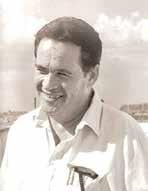

It is quite common to see top military brass adorned with rows of medals and decorations on their uniforms. However, some militaries don’t give out decorations and medals all too often. Israel awards far fewer decorations and ribbons than other countries, but there are three medals that are currently issued to IDF personnel that display courage on the battlefield. The stories behind the recipients of the Medal of Valor, the Medal of Courage, and the Medal of Distinguished Service are history to be remembered.
One of the most intense battles on the southern front of the Yom Kippur War took place in the Sinai Peninsula north of the Great Bitter Lake. From October 15 to 17, 1973, Israeli forces, including armored units as well as the elite Paratroopers Brigade, battled two Egyptian divisions. Called the Battle of the Chinese Farm, the Israelis were victorious and opened up a route to the Suez Canal. The battle became known as one of the most bitter battles of the war as over 160 Israelis were killed in the fighting.
Four of the paratroopers cited for bravery in action were Captain Gideon Dvoretsky, Corporal Ofir Beit-Aria, Lieutenant Giora Shoham and Yehuda Hadad. Dvoretsky took command of a company in Ehud Barak’s battalion after the company commander was wounded. Eight tankers and paratroopers had been wounded and were left stranded. After a failed rescue attempt, Dvoretsky led another group in his armored personnel carrier (APC). This time, they were successful,
and the wounded were safely evacuated.
A few days later, Dvoretsky, Beit-Aria and Shoham were killed by a direct hit from an Egyptian missile. For his actions in leading the rescue mission Dvoretsky was awarded the Medal of Courage.
Asher Porat was doctor who served on the front lines through several conflicts including the Six Day War, the War of Attrition, and the Yom Kippur War. Born in Paris, Porat’s family moved to Argentina when he was young. He began studying medicine in Buenos Aries and finished in Israel. Soon
their main target, Yasser Arafat. During the battle, 30 IDF soldiers were killed and close to 100 were injured. Tanks were caught in the open, and one of them was in an area that was being targeted by heavy enemy fire. The doctor that was attached to the unit abandoned his duties, and an armored force failed four times to reach the wounded soldiers. Porat with another soldier took a tank to get close to the area and then crawled under heavy fire to rescue two of the wounded Israelis. A third could not be rescued. He then put the two
Despite wounds on his hands and the landing gear not working properly, Yoeli made an emergency crash landing at Tel Nof Air Base.
after his move to Israel, he joined the IDF, took an officer’s course and became a military doctor. During the Six Day War, he was with the 60th Brigade, but he also treated wounded soldiers from other units as well. In 1968, Porat was the medical officer with the 7 th Brigade while there were performing missions during the War of Attrition.
The Battle of Karameh took place on March 21, 1968, between the IDF against the PLO and Jordan. The IDF destroyed the PLO camp of Karameh and took around 140 prisoners but failed to capture
soldiers in a tank and drove them to an evacuation station. Only one of the wounded soldiers survived his injuries, and Porat was also wounded in the rescue. For his actions in the rescue operation, Porat was awarded the Medal of Courage.
Aharon Yoeli was one of Israel’s first fighter pilots and was the first Israeli pilot to shoot down an enemy plane while flying a jet. Yoeli, a descendent of the first Lubavitcher Rebbe, had taken Israel’s third pilot course in 1948 and soon was flying jet aircraft. He took command of
the 117 th Squadron that was operating British-built Gloucester Meteor jets. On October 31, 1956, a machine gun bullet penetrated his cockpit while he was flying over Egyptian territory. Shrapnel hit him in his hands, and despite wounds on his hands and the landing gear not working properly, Yoeli made an emergency crash landing at Tel Nof Air Base.
More than a year earlier, on September 1, 1955, Israeli warning systems picked up Egyptian aircraft that entered Israeli territory. Together with his wingman, Yoash Tzidon, Yoeli took off after the Egyptian de Havilland Vampire – another British-built jet fighter. Yoeli shot down two of the enemy planes but was prevented from going after the remaining two planes as they crossed back into Egyptian territory. Yoeli described how he shot down one of the planes: “I approached the right plane from behind and opened fire from a range of about 400 meters from four 20-millimeter cannons.” His award for the action was later upgraded to the Medal of Courage for his skill in shooting down the two enemy jets.
These are just some of the stories of the men who received medals fighting for Israel. Their hard work and dedication under the most difficult conditions make it history not to be forgotten.
Avi Heiligman is a weekly contributor to The Jewish Home. He welcomes your comments and suggestions for future columns and can be reached at aviheiligman@gmail.com.

MAJOR APPLIANCE REPAIR
Servicing Washers , Dryers , Refrigerators , Dishwasher, stoves
All work guaranteed. Call 718 3762288
VACUUM SALES AND REPAIR
All areas call Max Flam 718-444-4904
THE LEATHER SHOPPE
The spot for all your custom leather Judaica. Tallis/tefillin bags, lulav and esrog bags, havdallah sets, challah covers, shtenders, pesach sets, matzah/afikomen bags. WhatsApp: (732) 523-0007 or email: theleathershoppe732@gmail.com for a full catalog. We ship.
MY MOTTO IS DON’T WAIT TO buy real estate
Buy real estate and wait Your realtor for life 516-784-0856 Alexandra at Realty Connect USA
PEACEFUL PRESENCE STUDIO
Men’s private yoga, Licensed Massage & Holistic Health Guidance 436 Central Ave, Cedarhurst Info. & free video training www.peacefulpresence.com 516-371-3715
GERBER MOVING
FULL SERVICE MOVING Packing Moving Supplies
Local Long Distance. Licensed Insured 1000’S Of Happy Customers Call Shalom 347-276-7422
HANDYMAN AVAILABLE
For big or small jobs, Sheetrock, carpentry, painting, electrical, plumbing, install & repair appliances Call Ephraim at 347-593-4691
MANAGEMENT STAFF WILL ASSIST you with: * Obtaining Medicaid and Pooled Income Trust
* In-home Assessments, Individual and Family Counseling
* Securing reliable home care assistance
* Case and Care Management services
Dr. S. Sasson, DSW, LCSW (718) 544- 0870 or (646) 284-6242
HAIR COURSE:
Learn how to wash & style hair & wigs. Hair and wig cutting, wedding styling Private lessons or in a group Call Chaya 718-715-9009
ZEVIZZ WOODTURNING JUDAICA Challah knifes, batei mezuzah, besamim holder, kiddish cups, havdalah candle holders, yad for sefer torah, pens, stenders, bowls and more 952-356-2228

DON’T GET STUCK WITH A TWO STORY HOUSE YA KNOW, IT’S ONE STORY BEFORE YOU BUY IT BUT A SECOND STORY AFTER YOU OWN IT! Call Dov Herman For An Accurate Unbiased Home Inspection
Infrared - Termite Inspection Full Report All Included NYC 718-INSPECT Long Island 516-INSPECT www.nyinspect.com
Don’t miss this opportunity!
4 Bedroom 21/2 Bathroom House Perfectly located in Cedar Bay Park, walking distance to all.
Oversized property for expansion, A Must See.
LOCATION, LOCATION.
For More Info call (516) 881-7727 Leave Message
WOODMERE
Introducing a stunning 14-side hall colonial home in the Hewlett Woodmere School District. Formal living room, formal dining room, den with a skylight. Eat in Kitchen, two sinks, a double oven, a warming draw and a microwave. First floor bedroom, a full bathroom and laundry room. Two-car garage. Upper level has four bedrooms, two full bathrooms. Finished basement with playroom, storage and utilities. Well-groomed exterior with porch adjoining the master bedroom. Hardwood floors and back patio. Central air conditioning, inground sprinkler system, alarm system. Close proximity to schools, shopping centers, restaurants, and transportation options. Mark Lipner Associate Broker Berkshire Hathaway Laffey International 516-298-8457 mlipner@bhhslaffey.com
WOODMERE
Beautiful, brick, colonial boasting 5 bdr 3.5 Bth in pristine condition. Excellent location, near all! Move right in! RCUSA 516-512-9626

CAN’T AFFORD YOUR PROPERTY TAXES?
MORTGAGE?
Must sell for any reason? Call for FREE Consultation. Call now 212-470-3856
Cash buyers available!
Spacious home within school district 14 with exquisite upgrades and central air conditioning, splendid kitchen with dual sinks, five bedrooms. Main level encompasses a spacious great room, office space, complementing the formal living and dining areas. Unfinished basement, detached garage. Expansive lot, measuring 80 x 100. Conveniently located near shopping, railroad, restaurants and places of worship.
Mark Lipner Associate Broker Berkshire Hathaway Laffey International 516-298-8457 mlipner@bhhslaffey.com
WOODMERE
Dead end street, lot 8000 built 2100, 2 car garage 850k, pool, needs a lot of work. 917-770-0849
REAL ESATATE
Entrance off gourmet glatt lot, second floor, shared bath, ideal for therapist/ office work, includes utilities, $600. Call 516-371-3715
1500SF LOFT OFFICE
(formerly Shmuel Flaum Architect) 2 store/offices; ~600sf each 2 Cedarhurst offices; ~100sf each Starting at $650 Also… Large Parking Lot & Storage available Utilities, Internet & Parking incl. with some Kosher kitchen – Minyan Next to LIRR - No broker fee Call/text/Whatsapp: 516-206-1100

BIG FULLY RENOVATED, Woodmere, spacious 4bedroom 2 full bath split level.2 car garage +driveway. Backyard on water SD#14. W&D. Tons of storage space. 347-517-3552
HEAD ENGLISH, AFTERNOON Teaching Position Zareinu is hiring for the 24-25 school year. Looking for a qualified teacher to teach a modified English curriculum! for a small group of 3rd grade girls in Far Rockaway. Great Pay! Warm environment! Great administrative support! Email resume: jlepolstat@zareinu.org or call 516-993-2142
SEEKING SETSS PROVIDER 2024-25 High school girls yeshiva. Experience with high school curriculum and connecting with this demographic required. FT, Forest Hills, Queens Email aklaver@aylondon.com
BYAM HAS THE FOLLOWING positions available for the upcoming school year.
-Nursery Morah -Gym Teacher -Computer Teacher- part-time -Associates AM/PM
Please email your resume to ywerner@baisyaakovam.org
Assistant Join the Zareinu team! Seeking a detail-oriented individual Will provide support to our administration, staff and parent body. Responsibilities: managing office tasks, setting up appointments, maintaining records, and assisting with communication between our staff and with the different schools that host Zareinu. Strong communication and computer skills. Competitive salary!! RSVP: jlepolstat@zareinu.org












EDUCATIONAL JOB OPENINGS
@Chabad of Merrick:
Immediate Opening:
Full time Administrator or Director for Hebrew school
Send resumes to programs@ chabadjewishlife.org or call 516-8333057 ext 108
Preschool Opening for 2024-2025 school year:
-Judaic Preschool teacher -Part/Full Time Assistant Teacher who can lead the Judaic lessons (mentorship available) Send resume to admissions@ jewishelc.org or call 516-833-3057 ext 110
REGENTS EXPERT
Tutoring regents in Algebra and Geometry A Darchei Torah instructor. Guaranteed results Text 347-491-8045 WhatsApp 347-767-1755
SEEKING ASSISTANT teachers for elementary General Studies classes for ‘24-’25 school year. Candidates should have skills to take over for teachers if needed. M-Th, PM hours, strong support. Far Rockaway area. Send resume to teachersearch11@gmail.com
BOOKKEEPER
Excellent growth potential, Frum environment, Excellent salary & benefits. Email resume to: resumetfs1@gmail.com
DELIVERY PERSON NEEDED to deliver this Newspaper every Thursday morning to locations in Brooklyn. Must have Mini van or SUVand availability to work Consistently every week. Good pay
Please email gabe@ fivetownsjewishhome.com or call (917) 299-8082

ZAREINU
Is seeking a P/T afternoon, secular studies, special education teacher for a small fourth and fifth grade girls class in a Far Rockaway Bais Yaakov. Great pay! Warm environment with administrative support!
Email resume: jlepolstat@zareinu.org or call 516-993-2142.
ZAREINU
Is seeking a P/T morning Limudai Kodesh special education teacher for small fourth and fifth grade girls class in a Far Rockaway Bais Yaakov. Great pay! Warm environment with administrative support! Email resume: jlepolstat@zareinu.org or call 516-993-2142.
ZAREINU
Is seeking a P/T early afternoon Limudai Kodesh special education teacher for small sixth-seventh grade girls class in the Five Towns. Great pay! Warm environment with administrative support! Email resume: jlepolstat@zareinu.org or call 516-993-2142.
ZAREINU
Is seeking P/T assistants for their small, special education, elementary and middle school classes. For more information, call 516-993-2142.
Email resume: jlepolstat@zareinu.org
TAL ACADEMY IN Belle Harbor seeking experienced special education teacher for afternoon class. Warm working environment. Competitive pay. Send resumes to Careers@talacademy.org
FIVE TOWNS SCHOOL
Seeks executive assistant in a busy financial office as well as assisting with events. Must be reliable, detail oriented and able to work with tight deadlines. Position will be part time. Salary range will depend on skills and experience. Must be fluent in Microsoft Office, InfoGrasp knowledge a plus. E-mail resume and references to responses246@gmail.com
SPECIAL ED TEACHER HASC seeks Special Ed Teachers for our Early Learning Program. Warm, supportive and enjoyable working environment. Great Pay and Benefits! Sign on Bonus! Referral Bonus! Please email resume to jobswd@hasc.net
Seeks a responsible individual to serve as a bookkeeper in a busy financial office. Must be reliable, detail oriented and able to work with tight deadlines. Position can be full or part time. Salary range will depend on skills and experience. Must be fluent in Quickbooks and Microsoft Office, InfoGrasp knowledge a plus. E-mail resume and references to responses246@gmail.com
5 Towns area Nursing Home management office seeking a Regional/Corporate level MDS Nurse to work in our office. Must be an RN. Regional experience preferred. 2-3 years MDS experience with good computer skills required. Position is Full Time but Part Time can be considered. Great Shomer Shabbos environment with some remote options as well. Email: officejob2019@gmail.com
HEAD ENGLISH, AFTERNOON Teaching Position
Zareinu is hiring for the 24-25 school year. Looking for a qualified teacher to teach a modified English curriculum! for a small group of 4th and 5th grade girls in Far Rockaway. Great Pay! Warm environment! Great administrative support! Email resume: jlepolstat@zareinu.org or call 516-993-2142
HEAD MORAH, MORNING POSITION Zareinu is hiring for the 24-25 school year. Looking for a qualified head Morah afternoon position! Looking for a qualified teacher to teach a modified Limudie Kodesh curriculum. for a small group of 4th and 5th grade girls. Great Pay! Warm environment! Great administrative support! Email resume: jlepolstat@zareinu.org or call 516-993-2142
classifieds@fivetownsjewishhome.com • text 443-929-4003
ASSISTANT TEACHER, MORNING and Afternoon Positions
Join our Specialized team at Zareinu. Looking for a warm and caring teacher assistant to work with an experienced teacher in a small 3rd and 4th grade girls’ class in a Beis Yaakov in Far Rockaway. Great Pay! Great Opportunity! Warm environment with administrative support! Email resume: jlepolstat@zareinu.org or call 516-993-2142
SEEKING ASSISTANT TEACHERS
For elementary General Studies classes for ‘24-’25 school year. Candidates should have skills to take over for teachers if needed. M-Th, PM hours, strong support. Far Rockaway area. Send resume to teachersearch11@gmail.com.
and Science/History teacher. M-Th, PM hours, strong support, curriculum and material provided, excellent salary. Far Rockaway area. Teachersearch11@gmail.com.
A multi-tasker needed for general office work. The ideal candidate is someone who is detail-oriented, responsible, and can take ownership. Looking for someone who is eager to learn, and expand his/her skill set while possessing the ability to work independently and as part of a team. Experience with Excel required. Five Towns location. In-office position only, not remote. Please send resume to 5tpart.timecareer@gmail.com
SEEKING SETSS PROVIDER 2024-25 Junior High boys yeshiva. Experience with middle school curriculum and connecting with this demographic required. FT, Forest Hills, Queens Email aklaver@aylondon.com
A YESHIVA IN QUEENS is looking for an experienced part/ full time secretary, 2-year-old morah, kindergarten morah, kindergarten morah assistant and Pre-1A English teacher for the 2022-2023 school year. Nice and timely pay. Please email resume to mshelt613@gmail.com or call/text 718-971-9799.
5 TOWNS BOYS YESHIVA
Seeking Elem Gen Ed Teachers
Excellent working environment and pay. Only lic/exp need apply. Email resume to yeshivalooking@gmail.com
SEEKING ELA TEACHER
Teaching position for Gr. 6. Mon.-Thurs., afternoon hours. Far Rockaway/5T area. Great salary, warm, supportive environment. Training in our curriculum is provided. Teachersearch11@gmail.com
YESHIVAT KOL YAAKOV
In Great Neck, NY, is seeking general studies teachers for both the elementary and middle schools, for the upcoming academic year. Mon-Thur afternoons. Competitive salary, warm and supportive environment. Send resume to m.kalati@kolyaakov.org
SHMIRAS HALASHON
Text 516-303-3868 with a time slot of your choice to be careful on lashon hara. Be a part of the 1,000 people for klal yisroel!

By Rivki D. Rosenwald Esq., LMFT, CLC, SDS
Are you a golf or a tennis person? Wait, don’t tell me – neither! Or impress me with your athleticism and answer: both!
Maybe that’s great, but maybe that’s a bit too great.
Some people are out for the major commitment. Eighteen holes out on the course and goodbye to civilization. Hit and walk, hit and walk, and so the day goes by.
It’s relaxing and fun for some. They are far away from the rat race. Great!
But they’re also far away from the family – the kids and mate! Oy!
One can always take a different approach and throw the family on the golf cart and make a fun day for all. Maybe that’s not a golf player’s ideal day. But it’s great family bonding.
Again, some may opt for a compromise and only play nine holes. Or better yet, train the family to love golf, too.
Ultimately, it’s like this: one can be “single” and have all the time in the world to play golf, or one can be committed to someone and take all the time in the world to play golf. However, in that case, they’re being “single-minded” and not thinking enough about the repercussions to them and the others.
Golf is a game where you want to beat your last score. Well, guess what? So is life!
You don’t just hit the ball in golf and not worry where it lands. That can get you into hot water, major traps, or wandering in a confusing maze. You need to think before you act. That is the way to be successful out on the golf course.


Well, so, too, in the course of life. One must decide: do they want to wind up in hot water? Do they want to get caught in major traps? Or do they want to wonder around confused as to where they are and
their relationship stands?!
So before venturing out for the day, think about your last performance as a dedicated mate and parent and how you want it to look in the future.
Rivki Rosenwald is a Licensed Marriage & Family Therapist working with both couples and individuals and is a certified relationship counselor. Rivki is a co-founder and creator of an effective Parent Management of Adolescent Years Program. She can be contacted at 917-7052004 or at rivkirosenwald@gmail.com.


